

General Aviation Services & Private Aircraft Handling
FLY, WE TAKE CARE OF
YOU
EVERY DETAIL 30 years of experience with fully renewed facilities

mallorcair.es Aeropuerto de Palma de Mallorca | Mallorca | xaviermudoy@mallorcair.es | +34 971 78 95 22
“Included in the TOP 10 during the last 10 years.” “Awarded 5 times as the best FBO in Europe.”
FEATURES
ENGEL & VÖLKERS Advertorial 8 JAUME VILARDELL Art & Design 12 OLIVE OIL Gastro 18 NIKKI BEACH MALLORCA Advertorial 22 RURAL BOUTIQUE HOTELS Traves Experiences 28 XTANT Art & Design 34 CASTELL BELLVER Heritage 38 MALLORCA COUNTRY CLUB Advertorial 44 CAMI DE CAVALLS Travel Experiences 48 SABATES PLA Style 52 SLOW LIVING Advertorial 56 AL ORIGEN Art & Design 62 PALMA INTERNATIONAL BOAT SHOW Advertorial 68 TASSABENE Signature 72 WORLD CUISINE Gastro 76 ARQUINESIA Style 82 FUNDACIÓ MIRÓ Art & Design 86 72 HOURS IN MAJORCA IN WINTER Escape 90 KEWENIG GALLERY Art & Design 98 ES VERGER Gastro 104 CAN PEP REY Style 108 PLAÇA GOMILA Art & Design 114 PEDRA EN SEC Heritage 120 MARKET GASTRO ROUTE Gastro 124 SDI BUSINESS COACHING Signature 128 BIZNAGA & ARTISTEO Art & Design 132 WINE BARS Gastro 136 TONY MORA Style 140 PALAU MARCH Heritage 144 YOGA RETREATS Travel Experiences 148 SHOPPING Style 152
 Photo: Can Pep Rey
Photo: Can Pep Rey

DESIGN & EDITION We Are Yellow Passeig Mallorca 28, Entlo A · Palma (+34) 655 171 020 weareyellow.com CONTRIBUTORS Aina Coll Comunica PRINTER Gràfiques Rubines ADVERTISE WITH US acc@mallorcair.es FOLLOW US @_themmagazine CREDITS The M Magazine is a bi-annual publication. Cover photo: Benjamin Voros COPYRIGHT: 2022. All rights reserved. Published by: Mallorcair S.L. P.O. Box 50002 Palma de Mallorca · Spain Tel. (+34) 971 787 932
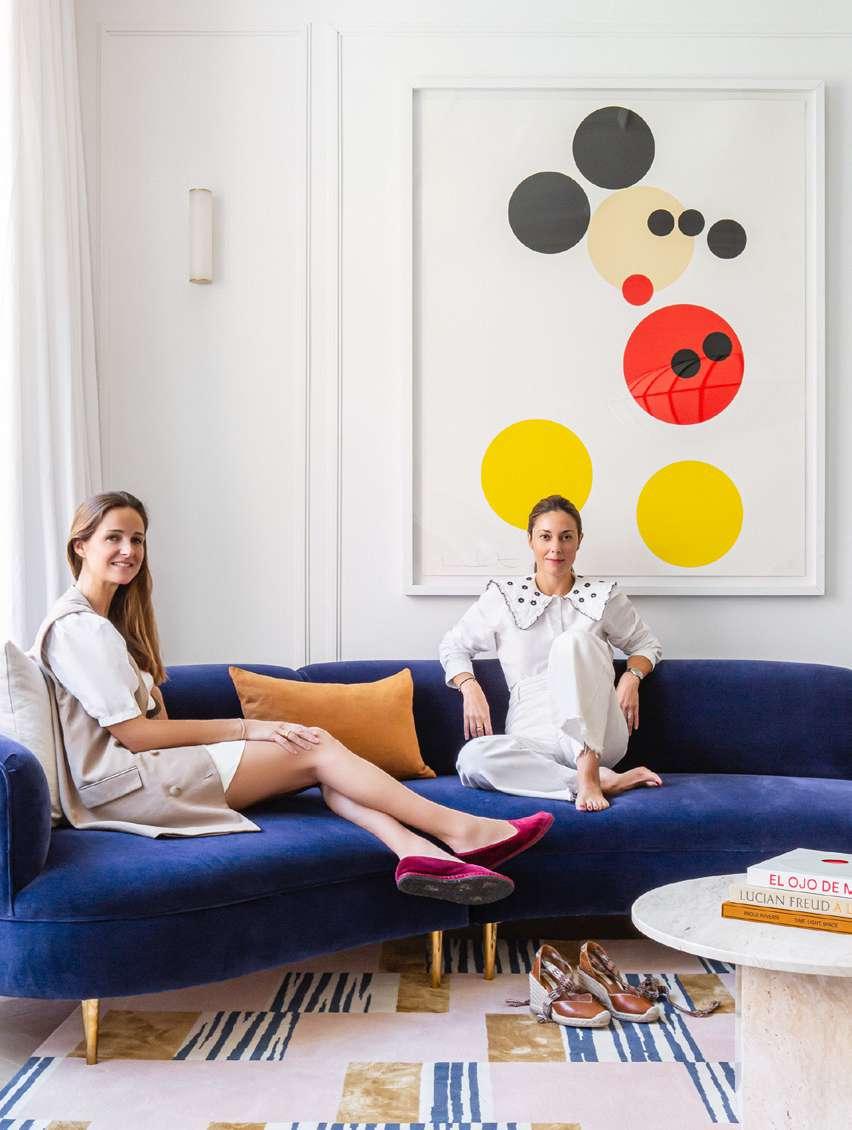

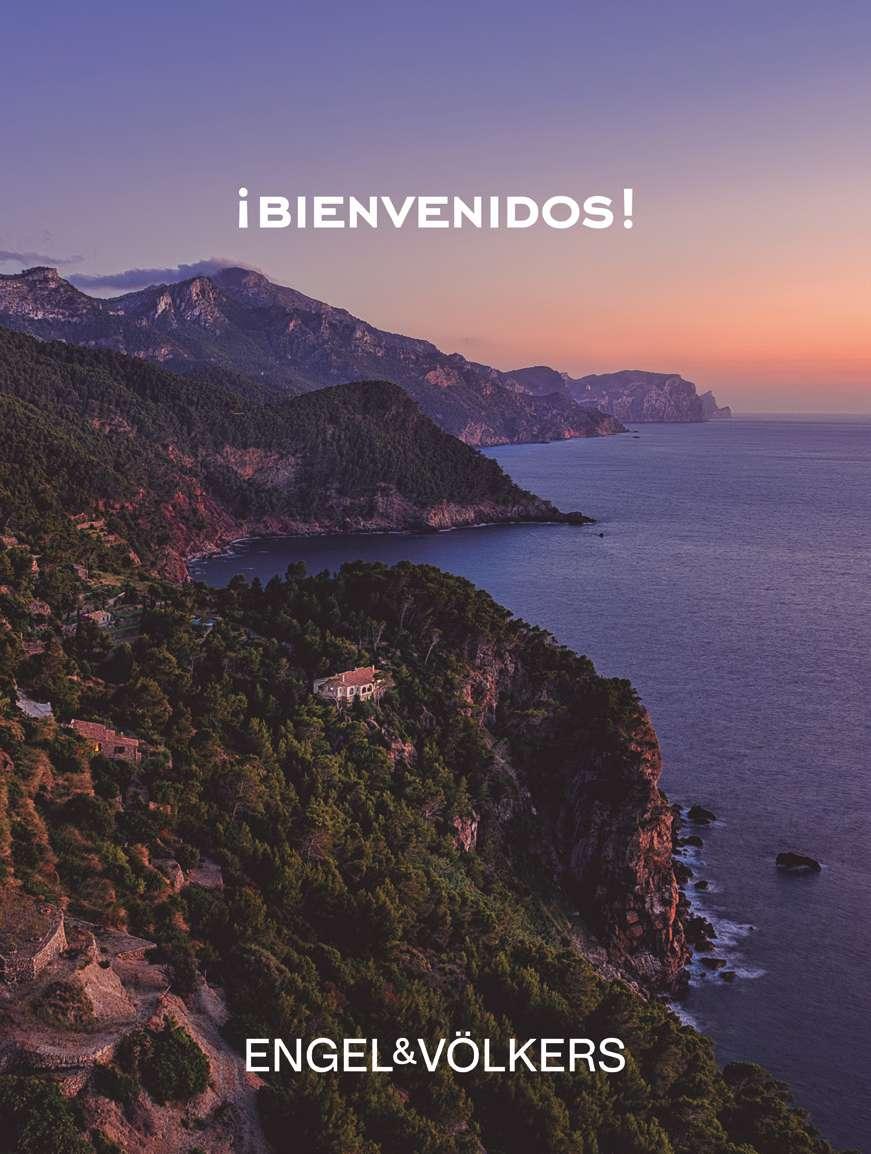
Warmsun, paradisiacal beaches, and beautiful landscapes, combined with a blend of tradition, culture, and a unique lifestyle, make Mallorca a safe place to live year-round. A new life in the Mediterranean can become a reality, offering unparalleled quality of life and infrastructure, with 18 international schools, 11 hospitals, excellent sports facilities, and outstanding connectivity. Palma boasts the best-connected airport in the Mediterranean, with over 375 routes throughout Europe and the Atlantic. These are just some of the reasons why Mallorca ranks as the number 1 destination in Europe for investment, whether for private or commercial use.
Engel & Völkers celebrates over 30 years on this wonderful island of Mallorca, with a team of over 170 experts spread across 19 real estate shops, combining local knowledge and global reach.
Contact us for more information:
ENGEL & VÖLKERS MALLORCA (+34) 971 238 584 · mallorca@engelvoelkers.com
www.engelvoelkers.com/mallorca

9
ADVERTORIAL
E&V ID W-02S06B

Cálido sol, playas paradisíacas y hermosos paisajes junto con la combinación de tradición, cultura y estilo de vida único hacen Mallorca un lugar seguro para vivir durante todo el año. Una nueva vida en el Mediterráneo puede convertirse en una realidad ofreciendo una calidad de vida y una infraestructura singular, con 18 escuelas internacionales, 11 hospitales, excelentes instalaciones deportivas y una gran conectividad. Palma es el aeropuerto mejor conectado del Mediterráneo, con más de 375 rutas en toda Europa y el Atlántico. Estas son solo algunas de las razones por las cuales Mallorca se clasifica como el destino número 1 en Europa para invertir, ya sea para uso privado o comercial.
Engel & Völkers celebra más de 30 años en esta maravillosa isla de Mallorca, con un equipo de más de 170 expertos distribuidos en 19 tiendas inmobiliarias, combinando el conocimiento local y el alcance mundial.
Póngase en contacto con nosotros para obtener más información:
ENGEL & VÖLKERS MALLORCA
(+34) 971 238 584 · mallorca@engelvoelkers.com
www.engelvoelkers.com/mallorca
10 ADVERTORIAL
E&V ID W-02R350
Photo by Ferdinand Graf Luckner
Auf Mallorca vereinen sich warmes Sonnenlicht, paradiesische Strände und atemberaubende Landschaften zu einem sicheren und ganzjährigen Wohnort. Hier bietet sich die Möglichkeit eines Neuanfangs im Mittelmeer mit erstklassiger Lebensqualität und Infrastruktur: von 18 internationalen Schulen und 11 Krankenhäusern bis hin zu herausragenden Sporteinrichtungen und exzellenten Verkehrsanbindungen. Palma beheimatet den am besten vernetzten Flughafen im Mittelmeer mit über 375 Routen durch ganz Europa und den Atlantik. Diese Faktoren machen Mallorca zum Top-Ziel in Europa für Investitionen, sei es für private oder geschäftliche Zwecke.
Engel & Völkers feiert über 30 Jahre auf dieser wunderbaren Insel, mit einem Team von über 170 Experten, verteilt auf 19 Immobilienläden, die lokales Wissen und globale Reichweite vereinen.
Kontaktieren Sie uns für mehr Informationen:
ENGEL & VÖLKERS MALLORCA (+34) 971 238 584 · mallorca@engelvoelkers.com www.engelvoelkers.com/mallorca
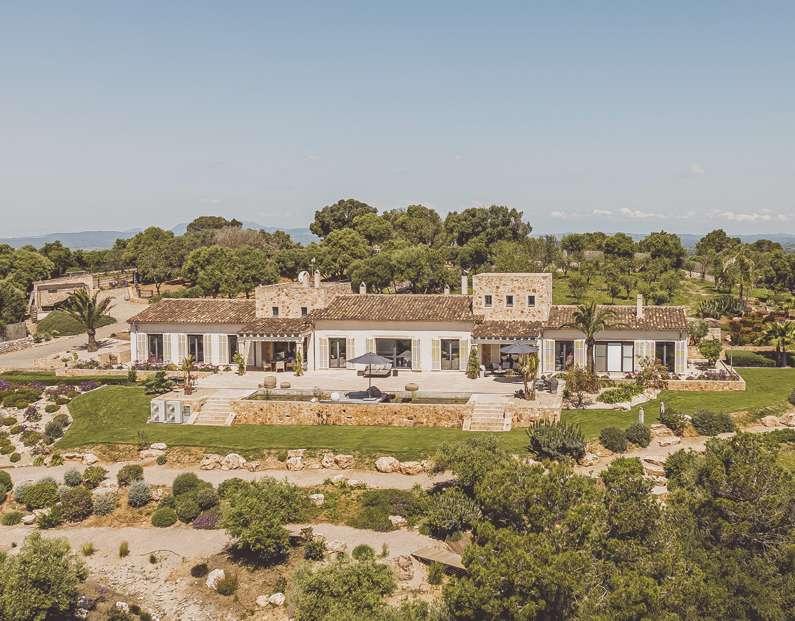
11
ADVERTORIAL
E&V ID W-02SU1C
JAUME VILARDELL
DELICACY AND SOPHISTICATION
When Jaume Vilardell looks back, he always remembers that when he was a young man, he wanted to be an architect, but he ended up studying industrial design at the former Palma School of Arts and Crafts, later specializing in furniture design in London.
However, his professional life took another turn while working as Creative Director of ForaVila studio, when he discovered his passion for drawing that has now become more a way of interpreting the world than just a profession.
Since deciding to turn his professional life around, the illustrator has skillfully developed both his communication and his editorial and product design. His innate, delicate and sophisticated talent shines in every piece, which all share a common factor: his undeniable ability to extol beauty.
Using watercolours, pen, pencil or gouache, his way of adapting to the essence and needs of each customer has landed him contracts with magazines such as ICON, Vogue and Esquire UK, the Hearst publishing house and long-standing brands such as Codorniu, Bulgari, Mondadori or Sony Pictures, among others.
If you go through his portfolio, it’s impossible to pick just one project. In 2019 he featured in Italian magazine l’Officiel Italia with ten haute couture collections. Vilardell illustrated the Dior Couture collection created by Maria Grazia Chiuri inspired by the circus, and in 2021 he recreated San Sebastián’s La Concha beach with an engraving for the new label of the iconic San Sebastian beer Keler.
Beyond his international projects, Vilardell - who admires the work of professional colleagues like René Gruau, Carmen García Huerta, Berto Martínez or Ignasi Monreal has also left his mark on the island, collaborating in local signature campaigns.
In 2017, he performed the most iconic jewels from the Compromiso and Nómada collections by Nicolás Joyeros in a tribute to the elegance of the Majorcan brand’s jewellery masterpieces. In 2022, as well as illustrating the Bazaar Palma calendar, he created an ad hoc floral universe to celebrate the fiftieth anniversary of the multi-brand Forum Shop.
Thanks to Vilardell’s creative gaze, the world always looks more pleasant, more peaceful, and more beautiful.
www.jaumevilardell.com
12 ART & DESIGN
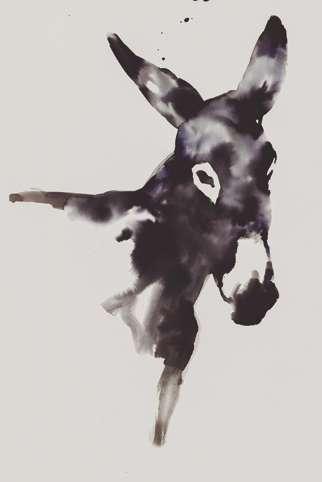

13
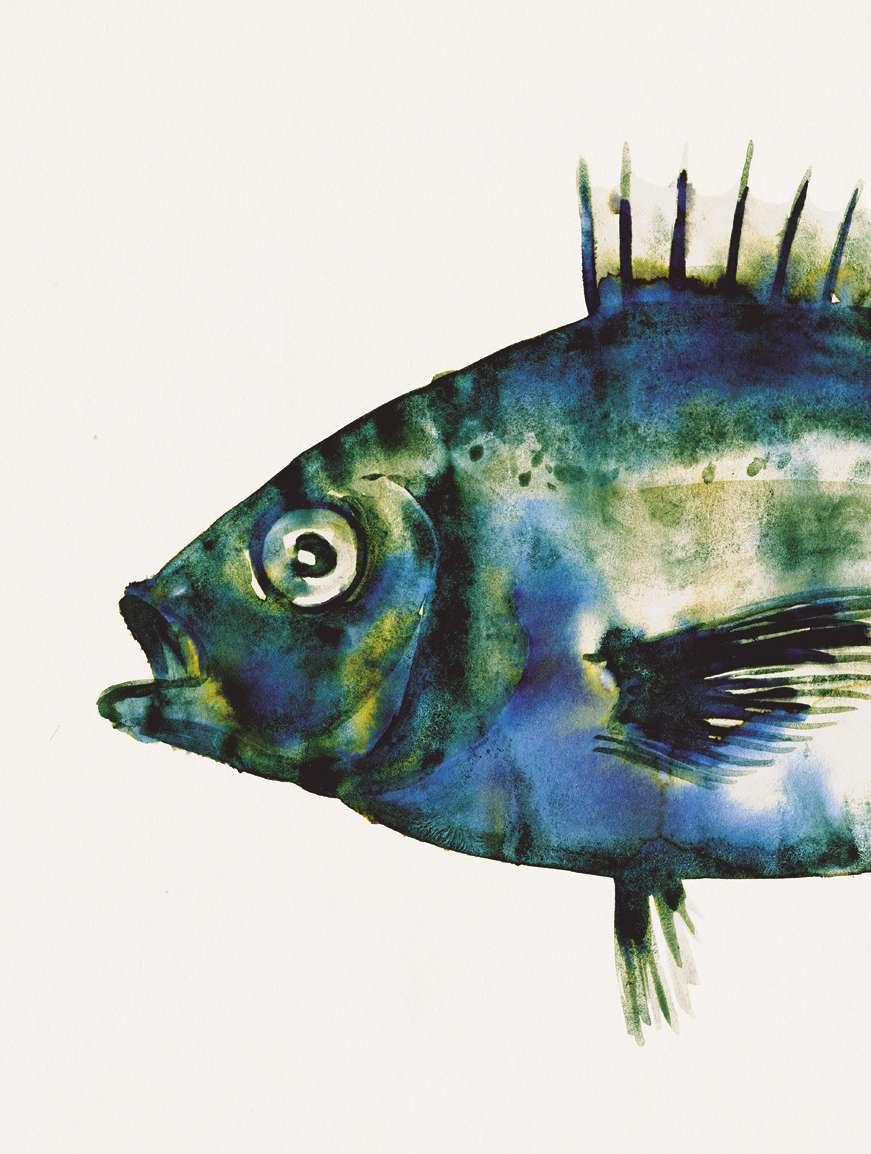



16
JAUME VILARDELL DELICADEZA Y SOFISTICACIÓN
Cuando Jaume Vilardell mira hacia el pasado siempre recuerda que, de joven, quería ser arquitecto pero que finalmente estudió diseño industrial en la antigua Escuela de Artes y Oficios de Palma y, después, se especializó en diseño de muebles en Londres.
Sin embargo, su vida profesional daría otra vuelta de tuerca cuando, trabajando en el estudio ForaVila como director creativo, descubrió en el dibujo una pasión que, por derecho propio, se ha convertido en, más que una profesión, una forma de interpretar el mundo.
Desde que decidiera dar un giro a su vida profesional, el ilustrador se desenvuelve con la misma destreza en comunicación que en diseño editorial o en diseño de producto gracias a un talento innato, delicado y sofisticado, que brilla a través de sus obras que tienen todas algo en común: su innegable capacidad de ensalzar la belleza.
Con acuarela, bolígrafo, lápiz o gouache, su forma de adaptarse a la esencia y las necesidades de cada cliente le ha llevado a trabajar para revistas como ICON, Vogue y Esquire UK, la editorial Hearst y marcas de largo recorrido como Codorniu, Bulgari, Mondadori o Sony Pictures, entre otras.
Revisando su portfolio resulta imposible quedarse con un solo proyecto del ilustrador. En 2019 fue uno de los artistas con los que contó la revista l’Officiel Italia para interpretar diez colecciones de alta costura -Vilardell ilustró la colección de Dior Couture creada por Maria Grazia Chiuri inspirada en el mundo del circo- y en 2021 ilustró con un grabado la playa de la Concha de San Sebastián para la nueva etiqueta de la icónica cerveza donostiarra Keler.
Más allá de sus proyectos internacionales, Vilardell -que admira la obra de colegas de profesión como René Gruau, Carmen García Huerta, Berto Martínez o Ignasi Monrealtambién ha dejado su huella en la isla, colaborando en campañas de firmas locales.
En 2017 interpretó las joyas más icónicas de las colecciones Compromiso y Nómada de Nicolás Joyeros en un homenaje a la elegancia de las piezas de alta joyería de la marca mallorquina y en 2022, además de ilustrar el calendario de Bazaar Palma, plasmó un universo floral ad hoc para celebrar el cincuenta aniversario de la tienda multimarca Forum Shop.
Gracias a la mirada creativa de Vilardell, sin duda, el mundo siempre luce más ameno, más apacible, más bello.
JAUME VILARDELL
FEINE RAFFINESSE
Blickt Jaume Vilardell zurück, denkt er daran, dass er als
Kind eigentlich Architekt werden wollte. Aber am Ende studierte er Industriedesign an der damaligen Kunstgewerbeschule Palma und spezialisierte sich dann in London auf Möbeldesign.
Eine weitere Wendung nahm sein Werdegang, als er bei Studio ForaVila als Kreativdirektor arbeitete und seine Leidenschaft fürs Zeichnen entdeckte, das für ihn mehr als ein Beruf zur Art wurde, die Welt zu interpretieren.
Mit seinem Entschluss, beruflich einen anderen Weg einzuschlagen, erlangte der Illustrator eine Versiertheit in Kommunikation, Editorial Design und Produktdesign, die durch das ihm angeborene, feine und raffinierte Talent all seine Werke durchdringt. Die unleugbare Fähigkeit, Schönem zu huldigen, ist allen gemein.
Seine Art, mit Aquarell, Kuli, Bleistift oder Gouache Ansprüche und Wesen des jeweiligen Kunden einzufangen, brachten ihm Arbeiten für Zeitschriften wie ICON, Vogue und Esquire UK, für Hearst und für etablierte Marken wie u.a. Codorniu, Bulgari, Mondadori und Sony Pictures.
Schaut man sich sein Portfolio an, kann man sich unmöglich nur für eins seiner Projekte entscheiden. Als einer der von der Zeitschrift l‘Officiel Italia mit der Interpretation von zehn Haute-Couture-Kollektionen beauftragten Künstler illustrierte Vilardell 2019 die von der Welt des Zirkus inspirierte Dior-Couture-Kollektion von Maria Grazia Chiuri und übernahm 2021 die grafische Darstellung des Strandes La Concha in San Sebastián für das neue Etikett des regionalen Kult-Biers Keler.
Neben internationalen Projekten hat Vilardell, großer Bewunderer der Arbeiten von Berufskollegen wie René Gruau, Carmen García Huerta, Berto Martínez und Ignasi Monreal, auch auf der Insel bei der Mitarbeit an Kampagnen hiesiger Unternehmen seine Spuren hinterlassen.
2017 interpretierte er die kultigsten Schmuckstücke der Kollektionen Compromiso und Nómada von Nicolás Joyeros, eine Verbeugung vor der Eleganz hochwertiger Juwelierkunst der mallorquinischen Marke, und 2022 illustrierte er den Kalender von Bazaar Palma und ein blumiges Universum aus Anlass des 50jährigen Bestehens des MultimarkenGeschäfts Forum Shop.
Die Welt aus der kreativen Sicht Vilardells erscheint immer freundlicher, angenehmer, schöner.
www.jaumevilardell.com
17 ART & DESIGN
OLIVE OIL
LIQUID GOLD
Olive trees have been a symbol of Mediterranean life since the Phoenicians and Greeks brought it to the Balearic Islands. They stand out on old and modern postcards, showcasing Majorca’s countryside and oil - a fundamental ingredient in Balearic gastronomy. Used in stews, fish, meats, stir-fries and, of course, on artisan bread, this product is cultivated all over the island and delights anyone who tastes it.
This liquid gold, harvested in the fields of the island from the end of September and processed in local mills, is a culinary emblem which features in traditional recipe books, and is used as a base ingredient in all contemporary recipes. Although the designation of origin Oli de Mallorca (which only includes Arbequina, Mallorquina and Picual olive varieties) was not formalized until 2002, oil production on the island is currently in a period of splendor, thanks to three important factors: the variety, quality and the excellence of the local, handmade product.
We invite you to discover the island’s best oil mills, that help maintain the island’s natural landscape by respecting agriculture and nature. They continue to produce traditional extra virgin oil that you will want to smell and taste.
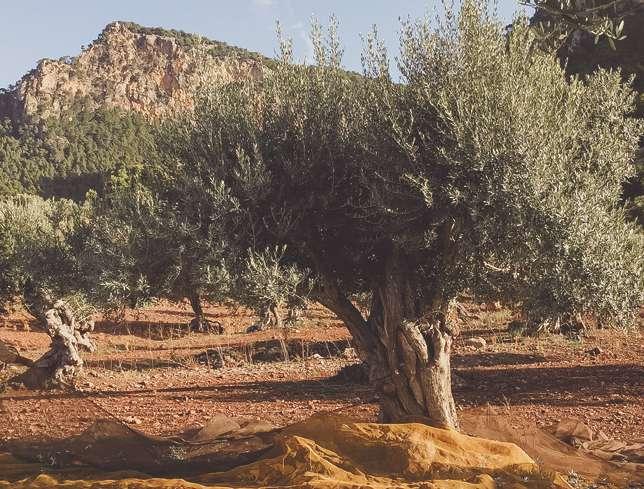
18 GASTRO
Photo: Son Moragues

ACEITE DE OLIVA
ORO LÍQUIDO
Símbolo de mediterraneidad, desde que llegara a las Baleares de la mano de los fenicios y los griegos, el olivo es el árbol protagonista indiscutible de cualquier postal -de ayer y hoy- que retrate el campo de Mallorca y el aceite, el ingrediente fundamental de la gastronomía balear. En guisos, pescados, carnes, sofritos y, por supuesto, en una rebanada de pan artesano, este producto que nace en todos los puntos cardinales del paisaje isleño deleita a todo aquel que se deja seducir por sus encantos.
Este oro líquido, que se cosecha en los campos de la isla a partir de finales de septiembre y se procesa en almazaras locales, es un emblema culinario indisociable del recetario tradicional, pero también la base de cualquier receta contemporánea que se precie. Aunque la denominación de origen Oli de Mallorca -que sólo contempla las variedades de aceituna Arbequina, Mallorquina y Picual- no se formalizó hasta 2002, en la actualidad la producción de aceite en la isla goza de una época de esplendor seguramente respaldada por tres motivos de peso: su variedad de matices, su calidad excelsa y el encumbramiento que vive el producto local.
Te invitamos a descubrir las mejores almazaras de la isla, esas que, desde el respeto por la agricultura y la naturaleza, ayudan a mantener el paisaje natural isleño y siguen ofreciéndonos el fruto, siempre virgen extra, de una tradición que querrás oler y saborear.
OLIVENÖL FLÜSSIGES GOLD
Als mediterranes Sinnbild fehlt der von Phöniziern und Griechen auf die Insel gebrachte Olivenbaum auf so gut wie keiner Postkarte. Er ist Wahrzeichen mallorquinischer Landschaft und Olivenöl grundlegender Bestandteil balearischer Gastronomie. In Eintopf-, Fisch- und Fleischgerichten, Sofritos und natürlich auf einer ‚pa amb oli‘ (Scheibe Landbrot) begeistert dieses Produkt, das von überallher auf der Insel stammt, alle.
Nach der Olivenernte Ende September und der Verarbeitung in örtlichen Ölmühlen ist das flüssige Gold unverzichtbarer Bestandteil aller traditionsreicher Rezepte aus Mallorca, aber auch Grundlage jedes angesehenen zeitgemäßen Rezepts.
Die Herstellung von Olivenöl, die Herkunftsbezeichnung Oli de Mallorca, zu der nur die Olivensorten Arbequina, Mallorquina und Picual zählen, wurde erst 2002 offiziell anerkannt, erlebt derzeit ein Hoch, das auf drei schwerwiegenden Gründen beruht: Vielfalt der Geschmacksnuancen, ausgezeichnete Qualität und der Trend zum regionalen, handwerklich hergestellten 0-Kilometer-Produkt.
Ans Herz legen möchten wir Ihnen die besten Olivenölmühlen der Insel. Sie tragen mit Achtung für Landwirtschaft und Natur dazu bei, die Landschaft der Insel zu bewahren und bieten das Meisterstück einer Tradition, immer extra nativ, dessen Duft und Geschmack Sie zu schätzen wissen.
GASTRO
19
Photo: Son Moragues


SON MORAGUES MALLORCA
This mountain estate is more than 500 years old with olive groves, orchards and ancestral forests. They have been working for 15 years to regenerate this farm and bring back the past vitality. A Majorcan olive variety, native to the Serra de Tramuntana, yielding deliciously fruity handmade oil that is harvested early, with a slight aroma of apple, grass and nuts. It is produced under the Protected Designation of Origin Oli de Mallorca and holds Organic certification (CBPAE).
Esta finca de montaña cuenta con más de 500 años de antigüedad con olivares, huertos y bosques ancestrales. Desde hace 15 años en Son Moragues trabajan para regenerar esta finca y devolver así a este entorno la vitalidad de tiempos pasados. De variedad de aceituna Mallorquina, la variedad autóctona de la Serra de Tramuntana, su aceite es de cosecha temprana y elaboración artesanal, con delicioso frutado y ligero aroma a manzana, hierba y fruto seco. Esta producido bajo la Denominación de Origen Protegida Oli de Mallorca y con certificación Ecológica (CBPAE).
Das mehr als 500 Jahre alte Landgut in den Bergen besticht durch Olivenhaine, Obstgärten und uralte Wälder. Seit 15 Jahren wird das Gut wieder bewirtschaftet und damit der Umgebung die Bedeutung vergangener Zeiten zurückgegeben. Das handwerklich hergestellte Olivenöl aus früher Ernte der einheimischen Olivensorte Mallorquina, Serra de Tramuntana, zeichnet sich durch deliziöse Fruchtigkeit und eine leichte Note von Apfel, Gras und Nüssen aus. Hergestellt wird es unter der geschützten Herkunftsbezeichnung Oli de Mallorca mit Bio-Label (CBPAE).
AUBOCASSA MALLORCA
The estate dates back to the Andalusian rule of the island (902-1229 AD). Albocàsser is a magnificent paradigm of Majorcan ownership, where history, heritage and agricultural exploitation come together spectacularly. Aubocassa oil is made with 100% Arbequina olives and feels silky, full and fresh in the mouth when you first taste it. You then smell the fruit and vegetable aromas. This oil stands out for its elegance and freshness, and for the perfect balance of an unforgettable landscape.
El origen de la finca arranca durante el dominio andalusí de la isla (902-1229 d.C.). Albocàsser es un magnífico paradigma de possessió mallorquina, donde historia, patrimonio y explotación agropecuaria se combinan de manera ejemplar. Su aceite Aubocassa está elaborado con variedad 100% arbequina y la primera sensación en boca es de sedosidad, plenitud y frescura. Después llegan las percepciones de frutas y verduras que se apreciaban en nariz. La elegancia y la frescura marcan la diferencia en este aceite pero sobre todo el equilibrio perfecto de un paisaje inolvidable.
Der Ursprung des Landgutes lässt sich bis in die Zeit der andalusischen Herrschaft über die Insel (902-1229 n.Chr.). Albocàsser ist ein Paradebeispiel für ein mallorquinisches Anwesen, auf dem sich Geschichte, Kulturerbe und Landwirtschaft mustergültig verbinden. Das Olivenöl Aubocassa wird zu 100% aus der Sorte Arbequina hergestellt. Der erste Eindruck vom Geschmack ist seidig, reichhaltig und frisch. Dann kommt die Wahrnehmung von Obst und Gemüse, die man zu riechen meint. Elegante Frische zeichnet dieses Öl vor anderen aus, aber vor allem perfekte Ausgewogenheit wie die Landschaft selbst. sonmo.es
aubocassa.com
20 GASTRO
OLI DE JORNETS
MALLORCA
The name Jornets, not documented before the XIV century, comes from the Jornet family who owned the land that the estate is now built on, a few km from Sineu. Its oil is 100% picual, of limited production, coming directly from olives and produced using mechanical procedures. It is very fruity, fresh and balanced with fresh grass and nut tones. In 2012, the prestigious German gourmet magazine “Der Feinschmecker” and the “Mastri Oleäri” listed it as one of the world’s 50 best oils.
El topónimo Jornets, no es documentado antes del siglo XIV, proviene del nombre de la familia Jornet, que era propietaria de los terrenos de la actual possessió, ubicada a escasos kilómetros de Sineu. Su aceite es 100% de la variedad picual y de producción limitada, directamente de aceitunas y solo mediante procedimientos mecánicos. Se caracteriza por ser muy afrutado, fresco y equilibrado con atributos de hierba fresca y frutos secos. En el año 2012, la prestigiosa revista gourmet alemana “Der Feinschmecker” y el “Mastri Oleäri” lo seleccionaron entre los 50 mejores aceites del mundo.
Der erst im 14. Jahrhundert urkundlich erwähnte Ortsname Jornets stammt von der Familie Jornet, der die nur wenige Kilometer von Sineu entfernten Ländereien des heutigen Anwesens gehörten. Das Olivenöl wird in begrenzter Auflage zu 100% aus der Sorte Picual direkt aus den Oliven und in rein mechanischen Verfahren hergestellt. Charakteristisch sind ausgeprägte Fruchtigkeit und Frische mit ausgewogener Note von frischem Gras und Nüssen. Im Jahr 2012 wählten die deutsche Gourmet-Zeitschrift “Der Feinschmecker” und “Mastri Oleäri” das Olivenöl zu den 50 besten der Welt.
olisdejornets.com
FINCA SAVATRY
MALLORCA
Located in the heart of Majorca and with more than 3500 olive trees, this estate is entirely dedicated to producing picual olive oils, a catering entrepreneur pouring his heart and soul into producing it. His secret is, in his own words, to give the olive tree the best and not to be stingy when caring for it. His oils have been internationally recognized, winning a gold medal in multiple competitions including the prestigious TerraOlivo and the Japan Olive Oil competition.
Situada en el corazón de Mallorca y con más de 3.500 olivos, se dedican íntegramente a la producción de aceites de oliva de la variedad picual bajo el cuidado y mimo personal de un empresario de la restauración venido a productor de aceite por amor a este producto. Su secreto está, según sus propias palabras, en darle lo mejor al olivo y no ser tacaño con él. Sus aceites han sido reconocidos internacionalmente con la medalla de Oro en múltiples certámenes como el prestigioso concurso TerraOlivo y en la Japan Olive Oil competition, con sendas medallas de Oro y Plata.
Mitten auf Mallorca widmet man sich hier mit mehr als 3.500 Olivenbäumen voll und ganz der Herstellung von Olivenöl aus der Sorte Picual unter Obhut und persönlicher Fürsorge eines Unternehmers der Gastronomie, der aus Liebe zu diesem Produkt zum Hersteller von Olivenöl wurde. Sein Geheimnis besteht nach eigenen Worten darin, dem Olivenbaum das Allerbeste zu geben und dabei nicht geizig zu sein. Seine Olivenöle wurden auf internationaler Ebene bei zahlreichen Wettbewerben mit Goldmedaillen geehrt wie beim renommierten Wettbewerb TerraOlivo.
fincasavantry.com


21 GASTRO
NIKKI BEACH MALLORCA
DISCOVER THE ESSENCE OF MEDITERRANEAN CHIC
Nestled along the sun-drenched shores of Spain’s Mallorca lies an oasis of barefoot luxury: Nikki Beach Mallorca. With panoramic views of the Mediterranean Sea and Isla de sa Porrassa, this exclusive beach club and restaurant beckons guests to indulge in an unparalleled escape.
Under the culinary mastery of Executive Chef Alex Gullberg, Nikki Beach Mallorca offers a gastronomic journey like no other. From vibrant seafood platters to locally inspired dishes bursting with flavor, each creation is a masterpiece that tantalizes the palate and elevates each dining experience to new heights.
This summer, Nikki Beach Mallorca presents an array of exciting activations and culinary collaborations. David Navarro, an acclaimed bartender, has partnered with Nikki Beach Mallorca to craft a special cocktail. Additionally, Chef Edu Martinez created a signature appetizer called “Origen,” highlighting Majorcan ingredients and complemented by a curated selection of Kombuchas. And the hailed Pastry Chef Ariadna Salvador adds a sweet finale with a special dessert item.
As guests lounge on plush daybeds beside the crystal-clear pool, they are enveloped in the ambiance of Nikki Beach’s ‘Celebration of Life’ motto, with lively entertainment provided by resident and guest DJs. Nikki Beach keeps the Balearic groove alive and pulsating throughout the summer, offering an exciting array of brand experiences. This property epitomizes the ultimate beachfront experience, perfect for both carefree afternoons and unforgettable nights on the Spanish coast, tailored specifically for the seasoned traveler.
Conveniently situated between the prestigious yacht harbors of Port Adriano and Puerto Portals, Nikki Beach Mallorca offers seamless access for visitors, including complimentary pontoon and yacht pick-up services for those arriving by boat.
Visit Nikki Beach Mallorca this summer, where luxury and indulgence intertwine, inviting you to Celebrate Life amidst the beauty of the Spanish coast.
www.mallorca.nikkibeach.com
22 ADVERTORIAL


23


24
NIKKI BEACH MALLORCA
DESCUBRE LA ESENCIA DEL MEDITERRÁNEO CHIC
Situado a lo largo de la soleada costa española de Mallorca, se encuentra el oasis de lujo donde poder caminar descalzo: Nikki Beach Mallorca. Con vistas panorámicas al mar Mediterráneo y a la Isla de Sa Porrassa, el exclusivo Beach club y restaurante invita a sus clientes a disfrutar de una jornada inigualable.
Bajo la maestría culinaria del Chef ejecutivo Alex Gullberg, Nikki Beach Mallorca ofrece un viaje gastronómico incomparable. Desde vibrantes platos de mariscos hasta sabrosos platos de inspiración local, donde cada creación es una obra maestra que tenta al paladar y eleva cada experiencia gastronómica a nuevas alturas.
Este verano, Nikki Beach Mallorca presenta una variedad de emocionantes activaciones y colaboraciones culinarias. David Navarro, el premiado bartender, se ha asociado con Nikki Beach Mallorca para elaborar un cóctel especial. Además, el chef Edu Martínez ha creado un aperitivo exclusivo llamado “Origen”, que destaca los ingredientes mallorquines y lo complementa con una cuidada selección de Kombuchas. Y la conocida pastelera Ariadna Salvador añade un dulce final con un postre especial.
Mientras los clientes se relajan en los elegantes divanes junto a la piscina de aguas cristalinas, se sumergen en el espíritu “Celebración de la vida” de Nikki Beach, con entretenimiento en vivo a cargo de DJ residentes e invitados. Nikki Beach Mallorca mantiene vivo el ritmo de las Islas Baleares durante todo el verano, ofreciendo una emocionante variedad de experiencias de marca. Esta propiedad representa la mejor experiencia frente al mar, perfecta tanto para tardes despreocupadas como para noches inolvidables en la costa española, diseñada específicamente para el viajero experimentado.
Estratégicamente situado entre los prestigiosos puertos de yates de Port Adriano y Puerto Portals, Nikki Beach Mallorca ofrece un acceso perfecto para los visitantes, incluyendo servicio gratuito de recogida en pontones y yates para quienes llegan en barco.
Visite Nikki Beach Mallorca este verano, donde el lujo y satisfacción se entrelazan, invitándolo a celebrar la vida en medio de la belleza de la costa española.
NIKKI BEACH MALLORCA
ENTDECKEN SIE WAHREN MEDITERRANEN CHIC
An der sonnigen Küste Mallorcas in Spanien befindet sich eine luxuriöse Oase zum barfuß laufen: Nikki Beach Mallorca. Panoramablick aufs Mittelmeer und die Insel de sa Porrassa machen den exklusiven Strandclub mit Restaurant zur idealen Adresse für den Genuss eines einmalig schönen Tages.
Mit dem meisterlichen Können von Küchenchef Alex Gullberg bietet Nikki Beach Mallorca einen unvergleichbaren kulinarischen Streifzug. Von appetitlichen Meeresfrüchten bis hin zu wohlschmeckenden, regional inspirierten Gerichten ist jede Kreation Meisterwerk und Gaumenfreude für Hochgenuss der gehobenen Art.
In diesem Sommer erwartet Sie im Nikki Beach Mallorca eine Fülle attraktiver Anregungen und kulinarischer Angebote. Der renommierte Barkeeper David Navarro kreierte für Nikki Beach Mallorca einen ganz besonderen Cocktail, Chefkoch Edu Martínez erdachte einen exklusiven Imbiss mit Namen „Origen“, der Zutaten Mallorcas besonders zur Geltung bringt und von einer Auswahl erlesener Kombuchas ergänzt wird, und die berühmte Patissierin Ariadna Salvador setzt mit einem besonderen Dessert das süße i-Tüpfelchen zum Abschluss.
Bei erholsamer Entspannung auf eleganten Liegen am Pool mit glasklarem Wasser und bei Live-Unterhaltung von hiesigen und Gast-DJs schwelgen Gäste im “Ein Hoch auf das Leben”-Gefühl von Nikki Beach. Balearisches Lebensgefühl gibt es im Nikki Beach mit einer Vielfalt ansprechender Markenerlebnisse den ganzen Sommer über. Erlebnisangebote vom Feinsten direkt am Meer für unbeschwerte Nachmittage und unvergesslich schöne Nächte an der Küste Spaniens, speziell konzipiert für Reisende mit Erfahrung, erwarten Sie hier.
In strategisch günstiger Lage zwischen den renommierten Yachthäfen Port Adriano und Puerto Portals ist Nikki Beach Mallorca für Besucher bequem erreichbar und bietet zusätzlich kostenfreien Abholservice von Stegen und Yachten für Gäste, die mit dem Boot unterwegs sind.
Besuchen Sie in diesem Sommer Nikki Beach Mallorca, wo sich Luxus und Behaglichkeit zu einem Hoch auf das Leben und die Schönheit der Küste Spaniens verbinden.
www.mallorca.nikkibeach.com
25 ADVERTORIAL


Yachts and private residences.
While working together with world-renowned shipyards and designers, Zijlstra Interiors has produced some of the most extraordinary interiors ever created for luxury yachts and private residences. Our team can customise and update your interior, from small details to complete redesigns, turning it into a place with comfort and style. If you would like to come and talk to us about your project, please email or call us to arrange an appointment.
+31 72 505 28 52
- info@zijlstrainteriors.nl - www.zijlstrainteriors.nl
Showroom Palma de Mallorca - Carrer dels Paraires, 29 Principal L-1 - 07001 Palma, Spain
Scan QR-code for our corporate video


 The finest bespoke interiors.
The finest bespoke interiors.
RURAL BOUTIQUE HOTELS
RELAXED LUXURY
New ways of travelling - slower, more conscious, and more rooted in the destination - are becoming more popular. More and more people are looking for places to disconnect (or reconnect) with what’s important in life: finding calm and inspiration in nature’s serenity, slowing down and escaping the hustle and bustle of big cities, without compromising on XXI century comfort.
In tune with this growing demand, luxury and the countryside have come together to create rural boutique hotels, a new, carefully designed accommodation concept in enchanting settings. The idea is simple: leave the noise and stress of city life behind for a few days to enjoy exclusive spa treatments, outdoor activities, holistic therapies, craft workshops and healthy dining experiences.
Majorca’s other façade, light years away from the sun and beach tourist scene and buzzing urban life, is a willing host to this luxurious, tempting new offer. If you crave a few days of tranquillity, ultimate peace, self-care and idyllic views, you’re about to discover your new favourite hotel. It has everything you need to discover another way of understanding travel, in a beautiful setting in Majorca. Embrace the calm.

28 TRAVEL EXPERIENCES
Photo: Castell de Son Claret

HOTELES BOUTIQUE RURALES
EL LUJO RELAJADO
Nuevos modos de viajar -más lentos, más conscientes, más enraizados con el destino- se imponen en nuestros días. Cada vez más personas buscan parajes en los que desconectar -o reconectar con lo verdaderamente esencial de la vida-, encontrar la calma y la inspiración entre la serenidad de la naturaleza, bajar el ritmo y alejarse del ajetreo de las grandes ciudades… eso sí, sin renunciar a ninguna comodidad del siglo XXI.
En sintonía con esta demanda creciente, el lujo y el campo se han aliado en forma de hoteles boutique rurales, conceptos de una nueva hotelería que cuidan hasta el más mínimo detalle en entornos que embriagan. La idea es simple: dejar atrás, aunque sea por unos días, el ruido y el estrés de la vida en la ciudad para disfrutar de spas con tratamientos exclusivos, actividades al aire libre, terapias holísticas, talleres artesanales y experiencias gastronómicas saludables.
La otra Mallorca, la que se distancia de la oferta turística de sol y playa, y también de la vida urbanita, se está convirtiendo en un escenario que acoge, con gusto, esta propuesta mimada y tentadora que está en alza. Si eres de los que anhelan unos días de sosiego, absoluta paz, autocuidado y vistas idílicas, estás a punto de encontrar tu nuevo hotel favorito. Tiene todo lo que necesitas para descubrir otro modo de entender el viaje, está rodeado de belleza y, por supuesto, se encuentra en esta isla. Abraza la calma.
LÄNDLICHE BOUTIQUE-HOTELS
UNBESCHWERTER LUXUS
Eine neue Art des Reisens, gemächlicher, achtsamer, näher am Reiseziel, wird immer beliebter. Immer mehr Menschen suchen nach Orten, an denen man den Alltag draußen lassen oder wieder zum Wichtigen im Leben finden kann, wo man Ruhe und Inspiration in der Stille der Natur erlebt, entschleunigt und dem Trubel der Großstadt entkommt… allerdings, ohne auf irgendeine Annehmlichkeit des 21. Jahrhunderts zu verzichten.
Dieser wachsenden Nachfrage entsprechend verbinden sich Luxus und Landleben in ländlichen Boutique-Hotels, neue Hotelkonzepte mit viel Liebe zum Detail in betörender Umgebung. Die Idee ist einfach: Auch wenn nur für ein paar Tage, lassen Sie Krach und Hektik der Stadt hinter sich und gönnen Sie sich Spas mit exklusiven Behandlungen, Freizeitvergnügen an frischer Luft, ganzheitliche Therapien, Kunsthandwerk-Workshops und gesunde Gastro-Erlebnisse.
Das andere Mallorca, weit weg vom touristischen Sonneund Strand-Angebot und auch vom Stadtleben, wird zur Location für dieses immer beliebtere, verlockende Verwöhnangebot. Wenn auch Sie sich nach ein paar Tagen erholsamer Ruhe, Stille und herrlicher Aussichten sehnen, um die Seele baumeln zu lassen, werden Sie gleich Ihr neues Lieblingshotel finden. Es hat alles, was man für diese andere Art des Reisens braucht, ist von Schönheit umgeben und natürlich auf dieser Insel. Gönnen Sie sich Beschaulichkeit.
29 TRAVEL EXPERIENCES
Photo: Es Racó d’Artà

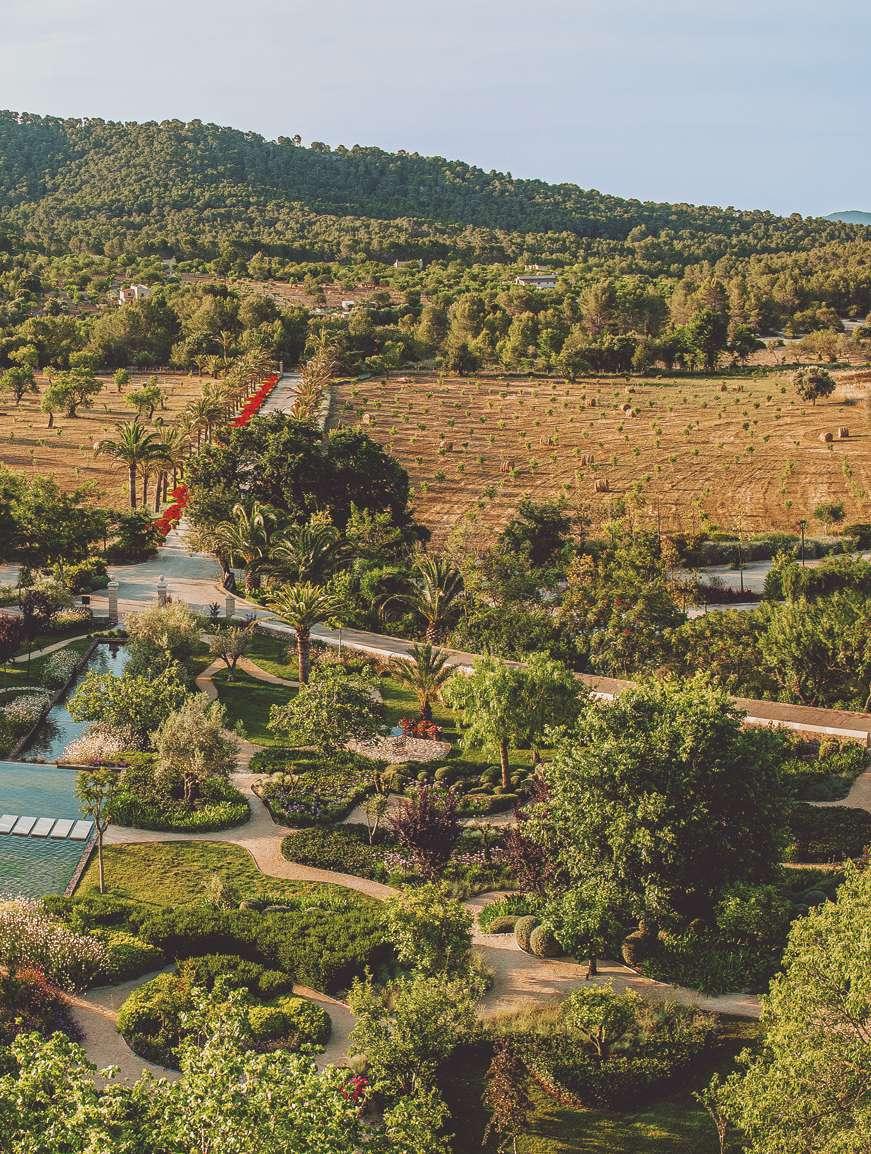 Photo: Castell Son Claret
Photo: Castell Son Claret

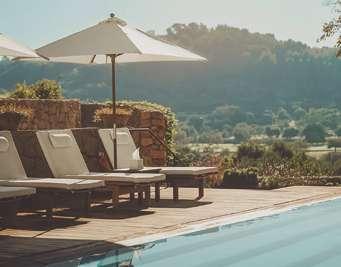
ES RACÓ D’ARTÀ ARTÀ, MALLORCA
Es Racó d’Artà has come back to life after friends Jaime and Antoni decided they wanted to restore this ancient and beautiful historical estate in the northeast of the island to glory. The XIII century estate is an oasis of peace for those seeking a leisurely, conscious and carefully planned way of life. A journey back to Majorca’s beloved origins, where nature, gastronomy, culture and architecture were respected creating a melting pot of colours and textures.
SON BRULL POLLENÇA, MALLORCA
Son Brull, included in the Relais & Châteaux collection, is a 5-star hotel located in the heart of the Serra de Tramuntana. This historic XVIII century monastery, surrounded by 32 hectares of vineyards, orchards and centuries-old olive trees, is the perfect place to enjoy gastronomy and relaxation in Majorca. The orchard, vineyards, bee hives and laying hens all live in harmony in the valley of fertile land. The farm follows organic, local practices, in keeping with its monastic past.
Es Racó d’Artà renace tras el sueño de dos amigos, Jaime y Antoni, quienes quisieron recuperar esta antigua y hermosa finca histórica en el noreste de la isla. La finca, que data del siglo XIII, es un oasis de paz para los que buscan encontrar un modo de vida pausado, consciente y lleno de detalles en cada lugar que poses la mirada. Un viaje de vuelta a los orígenes, a la Mallorca añorada, aquella en la que la naturaleza, la gastronomía, la cultura y la arquitectura, eran respetadas, creando un crisol de colores y texturas.
Son Brull, incluido en la colección de Relais & Châteaux, es un hotel de 5 estrellas ubicado en plena Serra de Tramuntana. Este histórico monasterio del siglo XVIII, rodeado de 32 hectáreas de viña, huerto y olivos centenarios, es el lugar perfecto para disfrutar de Mallorca en una experiencia tanto gastronómica como de relajación. En el valle de fértiles tierras se reparten el huerto, las viñas, las colmenas y las gallinas ponedoras. Rememorando su pasado monástico, la explotación agrícola se basa en principios ecológicos y locales.
Es Racó d’Artà ist der wahr gewordene Traum zweier Freunde, Jaime und Antoni, die dieses herrliche, altehrwürdige und geschichtsträchtige Landgut im Nordosten der Insel zu neuem Leben erweckten. Das Anwesen aus dem 13. Jahrhundert, Ort friedlicher Stille, ist ideal für alle, die Wert auf gemächliche, achtsame Lebensart und Details, wohin das Auge auch blickt, legen. Zurück zum Ursprünglichen, zu einem vergessen geglaubten Mallorca, wo man Natur, Gastronomie, Kultur und Architektur achtet. Ein Schmelztiegel von Farben und Texturen, tausend und einem Geruch und Geschmack.
Carretera de Cala Mitjana, Km 1.5. Artà esracodarta.com
Son Brull, 5-Sterne-Hotel aus der Kollektion Relais & Châteaux, mitten in der Serra de Tramuntana ist reinstes, unverfälschtes Mallorca. Das altehrwürdige Kloster aus dem 18. Jahrhundert auf 32 Hektar Land mit Weinstöcken, Obstbäumen und jahrhundertealten Olivenbäumen ist die beste Adresse für erholsamen Mallorca-Genuss, Gastronomie inbegriffen. Im fruchtbaren Tal gibt es Obstgärten, Weinberge, Bienenstöcke und Legehennen. Ganz im Sinne der klösterlichen Vergangenheit wird das Landgut nach ökologischen und hiesigen Richtlinien bewirtschaftet.
Carretera Palma - Pollença, Km 49.8. Pollença sonbrull.com
32 TRAVEL EXPERIENCES
Photo: fontsantahotel.com
SON GENER
ARTÀ, MALLORCA
This small rural hotel is located on an XVIII century estate, surrounded by gardens with centuries-old olive and almond trees overlooking the sea and surrounding hills. Although the exterior appearance maintained its essence and initial characteristics, the interior design focused on achieving a clean and relaxing private atmosphere. Decoration is simple and sober: clutter-free with carefully chosen refined natural furniture.
CASTELL DE SON CLARET
PALMA, MALLORCA
This XIX-century estate, converted into a 5-star Leading Hotels of the World collection property, is an oasis of serenity surrounded by Majorcan nature. A pure and inspiring embrace in a discreet, elegant and restless setting. With the majestic Serra Tramuntana in the background and surrounded by lush gardens, Castell Son Claret offers a luxurious, private Majorcan experience with top gastronomy and stunning nature.
Este pequeño hotel rural está ubicado en una finca de siglo XVIII, rodeado por jardines con olivos centenarios y almendros desde donde se puede observar el mar y las colinas de los alrededores. Aunque el aspecto exterior mantuvo su esencia y las características iniciales de la construcción, el interiorismo se centró en lograr una atmósfera limpia y clara que invita al descanso y permite disfrutar de la privacidad. La decoración es sencilla y sobria: apenas hay elementos ornamentales superfluos y los muebles han sido elegidos por sus líneas depuradas y naturales.
Das kleine Landhotel auf einem ländlichen Anwesen aus dem 18. Jahrhundert inmitten von Hainen mit jahrhundertealten Oliven- und Mandelbäumen bietet herrliche Ausblicke auf das Meer und die umliegenden Hügel. Im Gegensatz zum äußeren, dem ursprünglichen Aussehen des Bauwerks entsprechenden Erscheinungsbild besticht das Innere durch geradliniges, lichtes Ambiente, eine Einladung zu genussvoller, absolut ungestörter Erholung. Die Einrichtung ist schlicht und dezent gehalten, kein Element ist zu viel und Möbel wurden nach klarer Linienführung und Nähe zur Natur ausgewählt.
Carretera Vella. Son Servera - Artà, km 3 songener.com
Esta finca del siglo XIX reconvertida en hotel de 5 estrellas de la colección The Leading Hotels of the World, es un oasis de serenidad en plena naturaleza mallorquina. Un abrazo puro e inspirador en un ambiente de elegancia discreta. Respaldado por la majestuosidad de la Serra Tramuntana y rodeado por sus exuberantes jardines, Castell Son Claret ofrece una verdadera experiencia de lujo, privacidad, gastronomía y naturaleza en Mallorca. Los elementos de decoración contemporáneos destacan por su sencillez estética que proporciona funcionalidad y a la vez una atmósfera reconfortante.
Dieses zum 5-Sterne-Hotel umgebaute Landgut aus dem 19. Jahrhundert aus der Kollektion The Leading Hotels of the World ist eine friedvolle Oase inmitten mallorquinischer Natur. Wie eine herzlich inspirierende Umarmung in dezent eleganter und anrührender Umgebung. Die erhabene Serra Tramuntana im Hintergrund und inmitten üppiger Gärten bietet Castell Son Claret das Erlebnis wahren Luxus, Ungestörtheit, Gastronomie und Natur auf Mallorca. Die Elemente der zeitgemäßen Einrichtung bestechen durch schlichte Ästhetik und garantieren Zweckmäßigkeit und Behaglichkeit zugleich.
Carretera Es Capdellà, km 1.7. Es Capdellà castellsonclaret.com


TRAVEL EXPERIENCES
33
XTANT HERITAGE CRAFTSMANSHIP
“XTANT is a non-profit organization based in Madrid and Majorca, fostering excellence and preserving indigenous knowledge by inspiring the next generation through transformative educational and retail experiences, via five pillars: awareness, beauty, craftsmanship, time, and community.” This is XTANT’s definition: a project that transcends borders, disciplines and generations, and challenges traditional fashion and design sectors.
Founded in May 2023, XTANT brings together global artisans, artists, collectors, gallery owners, designers, architects, researchers and students to the Raixa estate for its fourth edition. The project is promoted by designer and activist Kavita Parmar and sustainable luxury consultant Marcella Echavarría. This educational program offers workshops, talks and debates on current Digital Age topics like textile craftsmanship, activism, new materials, regenerative agriculture or our future with artificial intelligence.
There were also exhibitions, conferences and the inauguration of a public gallery market, involving four historic buildings in Palma: Can Vivot, Can Oms, Can Balaguer and Can Marqués. The aim of XTANT is to offer a space to converse and preserve artisanal heritage, nourished by expert voices and knowledge, boosting quality, putting human beings at the forefront and vindicating a culture of beauty.
The craftsmanship project shares knowledge and honours the art of fibre and has fostered a remarkable global community of key craftsmen, designers and artists, including Majorcan-born Adriana Meunié, designer Álvaro Catalán de Ocón, Nilda Callañaupa Álvarez (founder of the Center for Traditional Textiles of Cusco) and Alicia Gautier and Guillaume Thiebaut of the Mèmori studio.
It’s time to rethink our consumption and how things we consume are produced. It’s time to take responsibility for how our decisions have an impact on the environment, and move towards a new world that values textile language. It’s time to collaborate and weave a fairer, more human, and more supportive future. And where better than Majorca, open to the world and able to preserve its contemporary and rooted, rural and modern traditions as a venue for this meeting?
www.xtant.io
34 ART & DESIGN
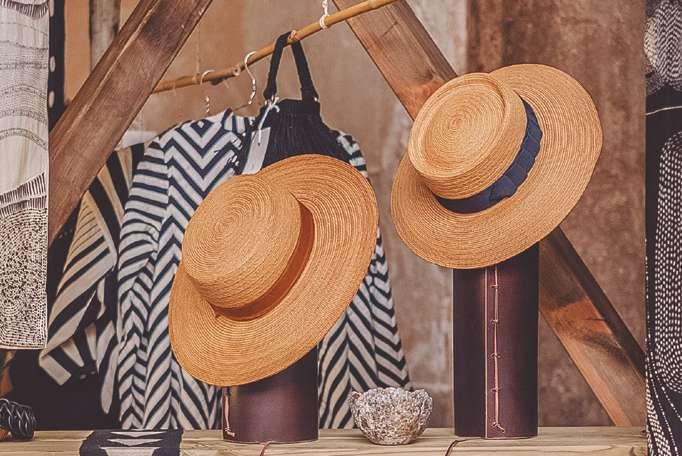

35
Photo: barefoothotels.de
Photo: barefoothotels.de
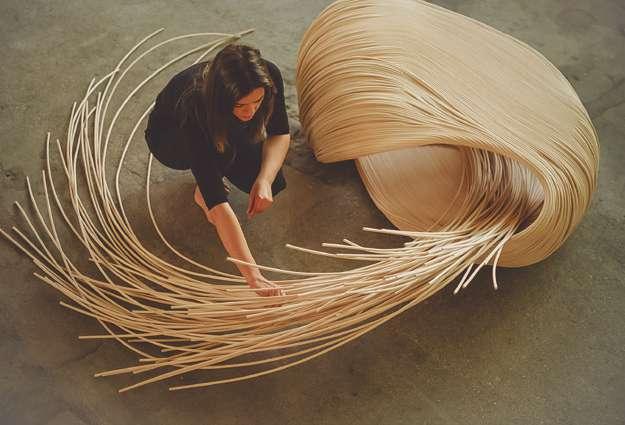
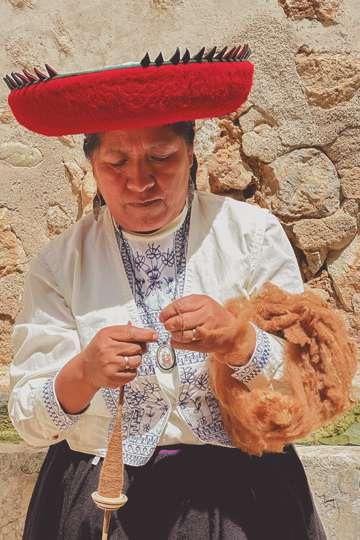
36
XTANT
ARTESANÍA PATRIMONIAL
“XTANT es una organización sin ánimo de lucro con sede en Madrid y Mallorca que trabaja para fomentar la excelencia y preservar el conocimiento indígena inspirando a la próxima generación a través de experiencias transformadoras en la educación y la venta al por menor, utilizando cinco pilares de trabajo: conciencia, belleza, artesanía, tiempo y comunidad”. Así es como se define a sí mismo XTANT, un proyecto que trasciende fronteras, disciplinas y generaciones, y clama por un cambio en los sectores tradicionales de la moda y el diseño.
Impulsado por la diseñadora y activista Kavita Parmar y la consultora especializada en lujo sostenible Marcella Echavarría, XTANT reunió, en mayo de 2023, a artesanos, artistas, coleccionistas, galeristas, diseñadores, arquitectos, investigadores y estudiantes de alrededor del mundo en la finca de Raixa en la cuarta edición de sus encuentros. La experiencia giró en torno a un programa educativo que propuso talleres, charlas y debates sobre temas tan actuales en la Era Digital como la artesanía textil, el activismo, los nuevos materiales, la agricultura regenerativa o el futuro que nos depara la inteligencia artificial.
La semana, además, se complementó con exposiciones, conferencias y la instalación de un mercado galería abierto al público que intervino cuatro edificios históricos de Palma: Can Vivot, Can Oms, Can Balaguer y Can Marqués.
Con el propósito de abrir un espacio para la conversación y preservar el patrimonio artesanal, XTANT se nutre de voces expertas y el conocimiento aupando la calidad, poniendo en el centro al ser humano y reivindicando la cultura de la belleza.
El proyecto, que celebra la artesanía, comparte conocimientos y honra el arte de la fibra, ha logrado afianzar una comunidad más que notable en todo el planeta a la que se han unido figuras de la artesanía, el diseño y el arte como la artista mallorquina Adriana Meunié, el diseñador Álvaro Catalán de Ocón, Nilda Callañaupa Álvarez -fundadora del Centro de Textiles Tradicionales de Cusco- o Alicia Gautier y Guillaume Thiebaut del estudio Mèmori.
Es tiempo de replantearse qué consumimos y con qué condiciones se produce lo que consumimos. Es tiempo de asumir el impacto ambiental que conllevan nuestras decisiones y de encaminarnos hacia un nuevo paradigma que ponga en valor el lenguaje textil. Tiempo de colaborar y tejer juntos un futuro más justo, más humano, más solidario. ¿Y qué escenario mejor que Mallorca, abierta al mundo y capaz de conservar sus tradiciones, contemporánea y enraizada, rural y moderna, para hospedar un encuentro como este?
XTANT ERBE KUNSTHANDWERK
“XTANT, Nonprofit-Organisation mit Sitz in Madrid und auf Mallorca, setzt sich für Spitzenleistung und Bewahrung althergebrachten Wissens ein und baut zur Inspiration der nächsten Generation mit Erlebnisangeboten in Bildung und Einzelhandel auf fünf Säulen: Bewusstsein, Schönheit, Kunsthandwerk, Zeit und Gemeinschaft.” So definiert man sich auch selbst bei XTANT, als ein über Grenzen, Disziplinen und Generationen hinausgehendes Projekt und als Weckruf zum Wandel bei Mode und Design der Gegenwart.
Auf Anregung der Designerin und Aktivistin Kavita Parmar und der auf nachhaltigen Luxus spezialisierten Beraterin Marcella Echavarría trafen sich im Mai 2023 bei XTANT Kunsthandwerker, Künstler, Sammler, Galeristen, Designer, Architekten, Forscher und Studenten aus aller Welt zum 4. Treffen auf dem Landgut Raixa. Im Mittelpunkt stand dabei ein Bildungsprogramm mit Workshops, Vorträgen und Gesprächsrunden zu im digitalen Zeitalter so interessanten Themen wie textile Handwerkskunst, Aktivismus, neue Materialien, regenerative Landwirtschaft und von künstlicher Intelligenz geprägte Zukunft.
Die Woche bereicherten Ausstellungen, Konferenzen und ein Galerie-Markt für die Öffentlichkeit in vier geschichtsträchtigen Bauwerken Palmas: Can Vivot, Can Oms, Can Balaguer und Can Marqués. Um Raum für Gespräche zu schaffen und kunsthandwerkliches Erbe zu bewahren, setzt XTANT auf Meinung und Wissen von Fachleuten. So werden Qualität gefördert, Menschen in den Mittelpunkt gestellt und die Kultur des Schönen gepflegt.
Dem Projekt, einer Ehrerbietung an Kunsthandwerk, Weitergabe von Können und meisterhafte Textilkunst, schloss sich bereits eine beachtliche Anhängerschaft überall auf der Welt an, darunter namhafte Persönlichkeiten aus Kunsthandwerk, Design und Kunst wie die mallorquinische Künstlerin Adriana Meunié, der Designer Álvaro Catalán de Ocón, die Gründerin des Zentrums traditioneller Textilkunst Cusco, Nilda Callañaupa Álvarez, oder Alicia Gautier und Guillaume Thiebaut vom Studio Mèmori.
Es ist Zeit zu hinterfragen, was wir konsumieren und unter welchen Bedingungen das von uns Konsumierte hergestellt wird. Es ist Zeit, Auswirkungen unserer Entscheidungen auf die Umwelt zu überdenken und zu neuer Wertschätzung textiler Ausdrucksform zu finden. Es ist Zeit, gemeinsam an einer gerechteren, menschlicheren und solidarischen Zukunft zu weben. Und wo könnte man besser so ein Treffen ausrichten als auf Mallorca, weltoffen und traditionsbewusst, zeitgemäß und bodenständig, ländlich und urban zugleich?
www.xtant.io
37 ART & DESIGN
CASTELL DE BELLVER
THE GUARDIAN OF PALMA BAY
Four towers flank Spain’s only circular castle, giving us the best views over Palma Bay from 112 meters up. Bellver Castle was originally built in 1300 by order of Jaime II, King of Majorca, to be a royal residence. James II, Sancho, James III of Majorca and King John I of Aragon both resided here.
Its architectural elements include the exterior façade’s twin windows, typical of Palma’s medieval architecture, composed of two semicircular arches separated by a column, and the main tower. This 30m high ‘torre de l’homenatge’ is the only tower not attached to the castle, split into four chambers joined together by a spiral staircase. Conceived as the last stronghold of resistance, it can only be accessed by crossing a sustained bridge from the castle terrace.
Combining palatial and defensive virtues, the castle became a military prison in 1717. Gaspar Melchor de Jovellanos was imprisoned here, along with numerous French soldiers and officers after the Battle of Bailén and 800 Republicans during the Spanish Civil War. Currently owned by Palma City Council, this iconic two-level castle is a museum that houses the city’s history under Roman, Muslim and Christian rule, and the Despuig Collection, in two permanent exhibitions. Its unique courtyard also hosts numerous cultural events throughout the year.
The lush 126-hectare forest surrounding the castle is another reason to visit this fortress, located less then 3 km from the city. The walking tour begins at Plaça Gomila, with a stone staircase known as Sa Pujada. Halfway there is the chapel of San Alonso Rodríguez, built between 1883 and 1885 on the site where, according to popular tradition, the Virgin Mary appeared to the holy porter of Mount Sion in 1572.
Bellver Castle is an architectural, artistic and cultural treasure that preserves Balearic Island history. Everything that has happened here has been observed from its highest tower. Its name says it all. In ancient Catalan, ‘bell ver’ means‘ good view ’.
38 HERITAGE



40


41
CASTELL DE BELLVER
EL GUARDIÁN DE LA BAHÍA DE PALMA
Cuatro torres flanquean el único castillo circular de España y nos regala, a 112 metros sobre el nivel del mar, las mejores vistas sobre la bahía de la ciudad. Es el Castillo de Bellver, construido en 1300 por orden de Jaime II, rey de Mallorca, y concebido en su origen como residencia real. De hecho, aquí vivieron, durante más o menos tiempo, Jaime II, Sancho, Jaime III de Mallorca y el rey Juan I de Aragón.
Entre sus elementos arquitectónicos, en el exterior destacan las ventanas geminadas de la fachada, típicas de la arquitectura medieval de Palma, compuestas por dos arcos de medio punto separados por una columna, y la torre mayor o torre de l’homenatge. Ésta, de treinta y tres metros de altura, es la única que no está adherida al castillo y se distribuye en cuatro cámaras que se comunican a través de una escalera de caracol. Concebida como último reducto de resistencia, solo se puede acceder a ella al cruzar, desde la terraza del castillo, un puente sostenido.
Combinando virtudes palaciegas y defensivas, en 1717 el castillo se convirtió en una prisión militar. Aquí estuvo preso Gaspar Melchor de Jovellanos, numerosos soldados y oficiales franceses tras la Batalla de Bailén y 800 republicanos durante la Guerra Civil Española. En la actualidad, propiedad del Ayuntamiento de Palma, este castillo emblemático de dos plantas es en museo que alberga la historia de la ciudad bajo el dominio romano, musulmán y cristiano, y la Colección Despuig en dos exposiciones permanentes. Además, en su singular patio se celebran numerosos eventos culturales durante todo el año.
El frondoso bosque que abraza el castillo –y que ocupa una superficie de 126 hectáreas- es otro motivo por el cual acercarse hasta esta fortificación situada a menos de tres kilómetros del centro de la ciudad. El recorrido a pie empieza en la plaza Gomila, con una escalinata de piedra conocida como Sa Pujada. A medio camino se encuentra la capilla de San Alonso Rodríguez, construida entre 1883 y 1885 en el lugar donde, según cuenta la tradición popular, la Virgen María se le apareció al santo portero de Monte Sión en el año 1572.
El Castillo de Bellver es un tesoro arquitectónico, artístico y cultural que guarda la historia de las Islas Baleares. Todo lo que ha sucedido aquí, se ha podido observar desde su torre más alta. Su nombre lo dice todo. Del catalán antiguo, ‘bell ver’ significa ‘buena vista’.
CASTELL DE BELLVER
DER WÄCHTER ÜBER DIE BUCHT VON PALMA
In 112 Metern über dem Meeresspiegel hat man auf Spaniens einziger kreisrunder Burg mit vier Türmen allerbesten Blick auf die Bucht der Stadt. Das Castell de Bellver wurde im Jahr 1300 auf Befehl von Jaime II., König von Mallorca, als ursprünglich königliche Residenz errichtet. Und tatsächlich residierten hier unterschiedlich lang die Könige Jaime II., Sancho, Jaime III. von Mallorca und Juan I. von Aragón.
Blickfang unter den architektonischen Elementen an der Außenseite sind das für mittelalterliche Architektur in Palma typische Zwillingsfenster mit zwei durch eine Säule getrennten Rundbögen und der Hauptturm, Torre de l’homenatge. Dieser 33 m hohe und als einziger nicht in die Festungsanlage eingefügte Turm unterteilt sich in vier Kammern, die durch eine Wendeltreppe verbunden sind. Als allerletzte Bastion des Widerstands gedacht, ist er nur über eine Brücke zu erreichen, die von der Terrasse der Burg aus über einen Graben führt.
Aus der Burg, gleichermaßen Palast wie auch Festung, wurde 1717 ein Militärgefängnis. In Haft saßen hier Gaspar Melchor de Jovellanos, zahlreiche französische Soldaten und Offiziere nach der Schlacht von Bailén und 800 Republikaner in der Zeit des Spanischen Bürgerkriegs. Heute ist die Burg, Wahrzeichen der Stadt und Eigentum des Rathauses Palma, ein Museum auf zwei Etagen zur Geschichte der Stadt unter römischer, maurischer und christlicher Herrschaft mit zwei Dauerausstellungen der Sammlung Despuig. Im einzigartigen Innenhof finden außerdem das ganze Jahr über zahlreiche kulturelle Veranstaltungen statt.
Auch der dichte Wald, der auf 126 Hektar Land die Burg umgibt, ist ein guter Grund für den Besuch der nur drei Kilometer vom Stadtzentrum entfernt liegenden Festung. Der Weg zu Fuß hinauf zur Burg beginnt am Plaza Gomila und führt über die als Sa Pujada bekannte Steintreppe. Auf halbem Weg steht die zwischen 1883 und 1885 errichteteKapelle San Alonso Rodríguez an genau dem Ort, wo dem Volksmund nach im Jahr 1572 dem Pförtner von Monte Sión die Jungfrau Maria erschien.
Die Burg Bellver ist in architektonischer, künstlerischer und kultureller Hinsicht ein Schatz, der die Geschichte der Balearen bewahrt. Alles, was geschah, konnte von ihrem höchsten Turm aus beobachtet werden. Und ihr Name sagt alles. Im alten Katalanisch bedeutet ‘bell ver’ ‘schöne Aussicht’.
HERITAGE
42

MALLORCA COUNTRY CLUB
DISCOVER THIS HIDDEN PARADISE IN SANTA PONÇA
Immerse yourself in an oasis of luxury and serenity at the Mallorca Country Club, located in the charming town of Santa Ponça, in the heart of Calvià. This exclusive club is a perfect combination of Mediterranean elegance and world-class facilities, offering members a unique experience.
The Mallorca Country Club is the perfect place for those looking to escape the daily grind and immerse themselves in tranquillity and well-being. With its stunning architectural design, the club blends seamlessly with the island’s natural beauty, creating an environment that invites relaxation and enjoyment.
The club’s first-class facilities leave nothing to the imagination. Active guests can enjoy state-of-the-art tennis courts, as this is the only club in southern Europe with all 3 surfaces: clay, hard court and natural grass, 3 paddle courts, 1 pickleball court and croquet. The club also has a private members lounge with a work area, gym and yoga studio.
Mallorca Country Club isn’t just a sporting paradise. It’s also a top-notch culinary destination. The club’s restaurant offers an incomparable dining experience, with a menu offering local and international dishes prepared by renowned chefs. Enjoy a romantic sunset dinner or relax with friends at the bar, sipping exquisite cocktails.
Becoming a member of the Mallorca Country Club is not just a lifestyle choice - it’s also an investment in well-being and happiness. With exceptional services, top-notch facilities and an unbeatable setting, the club is an exclusive retreat for those seeking the very best.
The Mallorca Country Club in Santa Ponça, Calvià is much more than a club. It is a destination that redefines luxury and elegance on this idyllic island. Discover a world of pleasure in a corner of paradise, where Mediterranean charm meets first-class services, offering an unforgettable experience.
www.mallorcacountryclub.es
44 ADVERTORIAL

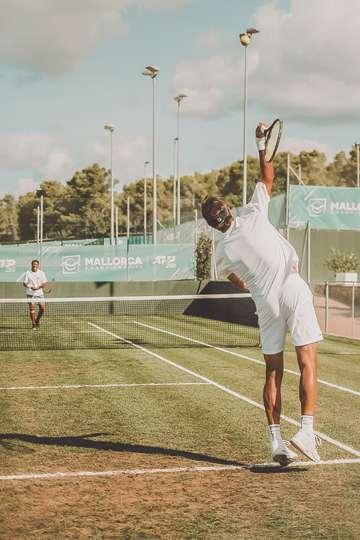
45
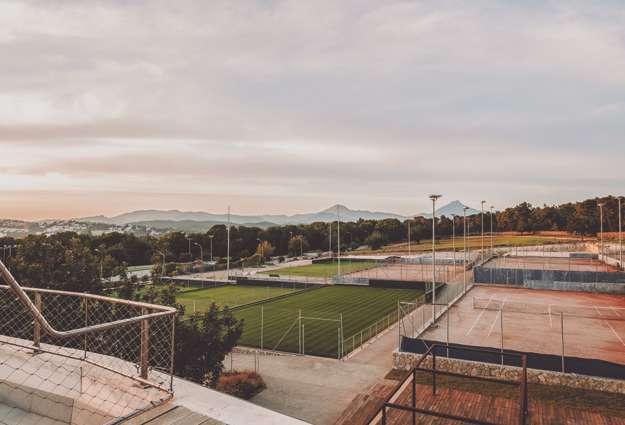

46
MALLORCA COUNTRY CLUB
DESCUBRE EL PARAÍSO OCULTO DE SANTA PONÇA
Sumérgete en un oasis de lujo y serenidad en el Mallorca Country Club, ubicado en la encantadora localidad de Santa Ponça, en el corazón de Calvià. Este exclusivo club combina a la perfección la elegancia mediterránea con instalaciones de clase mundial, ofreciendo a sus miembros una experiencia única que va más allá de lo convencional.
El Mallorca Country Club es el lugar perfecto para aquellos que buscan escapar del bullicio diario y sumergirse en un ambiente de tranquilidad y bienestar. Con su diseño arquitectónico impresionante, el club se integra armoniosamente con la belleza natural de la isla, creando un entorno que invita a la relajación y el disfrute.
Las instalaciones de primera clase del club no dejan nada que desear. Los amantes del deporte pueden disfrutar de canchas de tenis de última generación, siendo el único club del sur de Europa con las 3 superficies de tenis: tierra batida, pista dura y césped natural, 3 pistas de pádel, 1 pista de pickelball y como novedad: croquet. Además, el club cuenta con un private lounge para sus socios con zona de trabajo, gimnasio y sala de yoga.
Pero el Mallorca Country Club no es solo un paraíso para los amantes del deporte; también es un destino culinario de primera categoría. El restaurante del club ofrece una experiencia gastronómica incomparable, con un menú que combina sabores locales e internacionales preparados por chefs de renombre. Disfruta de una cena romántica con vistas al atardecer o relájate con amigos en el bar mientras saboreas cócteles exquisitos.
Convertirse en miembro del Mallorca Country Club no solo es una elección de estilo de vida, sino también una inversión en bienestar y felicidad. Con servicios excepcionales, instalaciones de primera categoría y un entorno incomparable, el club se erige como un refugio exclusivo para aquellos que buscan lo mejor de lo mejor.
En resumen, el Mallorca Country Club es mucho más que un club; es un destino que redefine el lujo y la elegancia en la idílica isla de Mallorca. Descubre un mundo de placeres en este rincón paradisíaco, donde el encanto mediterráneo se combina con servicios de primer nivel para ofrecerte una experiencia inolvidable.
MALLORCA COUNTRY CLUB
EIN VERSTECKTES PARADIES IN SANTA PONÇA
Entdecken Sie Mallorca Country Club, eine luxuriöse Oase beschaulicher Ruhe im reizvollen Ort Santa Ponça in der Gemeinde Calvià. In diesem exklusiven Club verbinden sich mediterrane Eleganz und Einrichtungen von Weltformat perfekt zu einem einzigartigen Erlebnis für Mitglieder, das weit über Herkömmliches hinausgeht.
Mallorca Country Club ist genau der richtige Ort für alle, die in behaglich ruhigem Ambiente dem Alltagsstress entkommen wollen. Mit grandiosem architektonischem Design schmiegt sich der Club in die herrliche Landschaft der Insel und bietet eine Umgebung zum genussvollen Entspannen.
Die erstklassigen Einrichtungen im Mallorca Country Club lassen keine Wünsche offen. Für Sportbegeisterte gibt es topmoderne Tennisplätze (der Club ist der einzige in Südeuropa mit drei Untergründen: Sandplatz, Hartplatz und Naturrasen), drei Pádel-Plätze, einen Pickleball-Platz und als Neuheit Krocket. Außerdem bietet der Club seinen Mitgliedern eine private Lounge mit Arbeitsbereich, Fitnessstudio und Yoga-Raum.
Aber der Mallorca Country Club ist nicht nur ein Paradies für alle, die Sport lieben, sondern auch eine erstklassige Gastro-Adresse. Im Club-Restaurant erwartet Sie mit von renommierten Köchen zubereiteten Gerichten, die regionale und internationale Aromen verbinden, ein kulinarisches Erlebnis ohnegleichen. Gönnen Sie sich ein romantisches Abendessen in der Abenddämmerung oder Entspannung pur mit Freunden bei exquisiten Cocktails an der Bar.
Eine Mitgliedschaft im Mallorca Country Club ist nicht nur eine Frage der Lebensart, sondern auch eine Investition in Wohlbefinden und Glücklichsein. Außergewöhnliche Serviceleistungen, erstklassige Einrichtungen und unübertroffene Umgebung machen den Club zum exklusiven Rückzugsort für alle, die Wert auf das Allerbeste legen.
In einem Satz, Mallorca Country Club in Santa Ponça, Calvià, ist viel mehr als nur ein Club, es ist ein Ort, an dem Luxus und Eleganz auf der malerischen Insel Mallorca neu definiert werden. Entdecken Sie eine Welt genussvollen Vergnügens für unvergesslich schöne Erlebnisse an diesem bezaubernden Ort, wo sich mediterranes Flair und erstklassiger Service ergänzen.
www.mallorcacountryclub.es
47 ADVERTORIAL
CAMI DE CAVALLS
DISCOVER A DIFFERENT MINORCA
Aunique way to discover every aspect of Minorca. A route where the gastronomy, culture and history of a Biosphere Reserve paradise meet. This journey begins and ends wherever and whenever you want. All you need for this adventure is respect for the wonderful natural setting.
Camí de Cavalls is composed of a 20-section map that tells the story of Minorca’s past through the landscape. The first begins in island capital Maó, ending in Es Grau. The second leads from Es Grau to Favaritx and the third, from the lighthouse to the dark rocks of Arenal d’En Castell. You then have a flat part running along the coast to Son Saura beach, one of Minorca’s largest dune systems.
From Cala Tirant to Biniamel·la, a stop at the Cavalleria lighthouse is a must: admire the Mediterranean Sea from 80 meters up. Walk along one of the steepest stretches and discover the S’Enclusa watch tower and Cala Pregonda, one of Minorca’s most emblematic beaches, before reaching Els Alocs. Crystalline waters and reddish rocks draw the landscape until you reach Algaiarens, a farm that harbors the secrets of the island’s Muslim era.
Take in the scent of heather, rosemary and chamomile between here and Cala Morell, indicating that we are close to the route’s ninth stage, with the strong Tramontana winds. Punta Nati is the Cavalls route mid-point, leading to the beautiful Ciutadella. The next section takes us on a pleasant seafront journey to Cala Turqueta: admire the southern Minorca’s characteristic wide and deep ravines, until you get to Cala Galdana.
The route between Sant Tomás and Son Bou takes us temporarily back to flatter ground, as we head to Cala de Porter. It’s worth the effort: the island’s largest Talayotic town is just two km away. Torre d’en Galmés. The final section takes us to Binissafúller and then to Punta Prima. Stop at Binibéquer Vell, a labyrinthine village of white houses. Weave between pastures and holm oaks and leave Es Castell behind to get back to Maó. The route is unique, showing all of Minorca’s must-sees.
48 TRAVEL EXPERIENCES

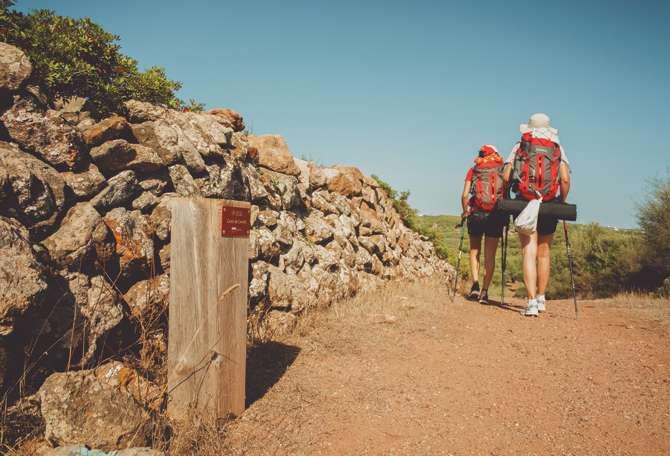
49


50
CAMI DE CAVALLS
DESCUBRE UNA MENORCA DIFERENTE
Existe una forma única de descubrir todas las facetas de Menorca. Una ruta en la que la gastronomía, la cultura y la historia de un paraíso declarado Reserva de Biosfera se encuentran. Una de sus singularidades es que este viaje empieza y acaba donde y cuando tú quieras. Lo único indispensable para emprender esta aventura es respetar su maravilloso entorno natural.
Veinte tramos configuran Camí de Cavalls, un mapa que narra el pasado de Menorca en su paisaje. El primer tramo empieza en Maó, la capital de la isla, y acaba en Es Grau; el segundo lleva desde Es Grau hasta Favaritx y el tercero, desde el faro hasta las oscuras rocas de Arenal d’En Castell. Desde aquí empieza una etapa llana que bordea el litoral hasta la playa de Son Saura, uno de los sistemas dunares más grandes de Menorca.
Desde Cala Tirant a Biniamel·la, la parada en el faro de Cavalleria es imprescindible: a 80 metros de altura se puede admirar el Mar Mediterráneo. Caminando por uno de los tramos más abruptos, descubriremos la atalaya de S’Enclusa y Cala Pregonda, una de las playas más emblemáticas de Menorca, antes de llegar hasta Els Alocs. A partir de aquí, las aguas cristalinas y las rocas rojizas dibujan el paisaje hasta llegar a Algaiarens, una explotación agraria que guarda los secretos de la época musulmana.
La ruta, desde aquí hasta Cala Morell, huele a brezo, romero y manzanilla, un indicativo de que hemos llegado a las puertas de la novena etapa, moldeada por la rabiosa incidencia del viento de tramontana. Punta Nati señala el ecuador de la ruta de Cavalls y conduce hasta la preciosa Ciutadella. El siguiente tramo nos regala un agradable paseo a orillas del mar hasta llegar a cala en Turqueta: es el momento de admirar los barrancos que caracterizan el paisaje de la parte central del sur de Menorca, anchos y profundos, hasta llegar a cala Galdana.
El recorrido entre Sant Tomás y Son Bou nos devuelve a la llanura, pero no por mucho tiempo, pues nos dirigimos a cala en Porter. El esfuerzo merece la pena: a escasos dos kilómetros, encontraremos el poblado talayótico más grande de la isla: Torre d’en Galmés. El tramo final nos conduce hasta Binissafúller y, después, a Punta Prima, donde merece la pena detenerse en Binibéquer Vell, un laberíntico pueblo de casitas blancas. Entre pastos y encinares y, tras dejar atrás Es Castell, llegamos de nuevo a Maó. La ruta es única; Menorca, imprescindible.
CAMÍ DE CAVALLS
DAS ANDERE MENORCA ENTDECKEN
Es gibt eine einmalige Art, Menorca rundum zu erkunden. Einen Weg, der Gastronomie, Kultur und Geschichte des zum Biosphärenreservat erklärten Paradieses vereint. Einzigartig ist allein schon, dass dieser Weg beginnt und endet, wo und wann auch immer Sie wollen. Ihr einziges Muss bei diesem Abenteuer ist strikte Achtung der herrlichen Landschaft.
Aus 20 Abschnitten besteht der Camí de Cavalls, ein Spiegelbild der Vergangenheit Menorcas im Landschaftsbild. Der erste Abschnitt beginnt in Maó, der Inselhauptstadt, und endet in Es Grau, der zweite führt von Es Grau nach Favaritx und der dritte vom Leuchtturm zu den Felsen von Arenal d’En Castell. Weiter geht der Weg durch flaches Land entlang der Küste bis zum Strand Son Saura, einem der größten Dünengebiete Menorcas.
Zwischen Cala Tirant und Biniamel·la sollte man unbedingt am Leuchtturm von Cavalleria anhalten und den herrlichen Blick aufs Mittelmeer aus 80 Metern Höhe bewundern. Auf einem der schroffsten Abschnitte gelangt man zum Wachturm S’Enclusa, zur Cala Pregonda, einem der Kult-Strände Menorcas, und schließlich nach Els Alocs. Glasklares Wasser und rötlich schimmernde Felsen prägen ab hier die Landschaft bis Algaiarens, einem Landgut, das noch die Geheimnisse maurischer Zeiten birgt.
Ab hier bis zur Cala Morell liegt ein Duft nach Heidekraut, Rosmarin und Kamille über dem Weg, Hinweis darauf, dass vor uns das neunte, vom gnadenlosen Tramontana-Wind geformte Wegstück liegt. Von Punta Nati, Scheitelpunkt des Camí de Cavalls, geht es in die herrliche Stadt Ciutadella. Auf der nächsten Strecke erwartet uns ein gemächlicher Spaziergang an der Küste entlang bis zur Bucht Cala en Turqueta. Weite und tiefe Schluchten, absolut sehenswert, ziehen sich durch diese Landschaft im mittleren, südlichen Teil Menorcas bis zur Cala Galdana.
Der Weg von Sant Tomás nach Son Bou führt uns kurz zurück in die Ebene und dann weiter nach Cala en Porter. Lohn der Mühe ist die knapp zwei Kilometer entfernte Talayot-Siedlung, die größte der Insel, Torre d’en Galmés. Das letzte Wegstück führt durch Binissafúller nach Punta Prima. Für Binibéquer Vell, ein kleines, labyrinthartiges Dorf mit weißen Häusern, sollte man sich unbedingt Zeit nehmen. Auf dem Weg vorbei an Weiden, durch Steineichenwälder und durch Es Castell kommt man wieder in Maó an. Ein Weg ohnegleichen, Menorca, ein Muss.
51 TRAVEL EXPERIENCES
SABATES PLA
INSPIRED BY NATURE
Almost 22% of Majorca’s surface is occupied by the Pla, a region of flat fields and small towns like Algaida, Costitx and Petra, which retain the island’s architecture and a quiet and simple pace of life. This is where Irene Peukes designs her shoes. Inspired by natural materials, craftsmen’s know-how and pursuant simplicity, Peukes creates modern, handcrafted and sustainable jute shoes.
The result of this relaxed, respectful and silent vision of fashion are Illetes, Bonanova and Tramuntana, three delicately handmade unisex models with jute braids and a cotton lining, joined to a natural textile and crepe sole. She does not need to use other materials to create inherently Mediterranean shoes.
They are aesthetically simple and captivating, but the process behind every pair created by Peukes on the island is brought to life by a community of female Bangladeshi artisans with local jute, fundamental for the country’s small farmers
Coordinated by Caritas Bangladesh, in compliance with strict Fair-Trade Code of Practice, Irene travels to the Asian country to work alongside the artisans and to supervise the finished product. She then returns to the island, where the unique soft sole. Here both parts are joined together offering a careful, contemporary finish.
As well as these three emblematic Pla models, the firm has launched two sandal designs, Formentor and Llevant, using wooden soles and cotton ribbons. These also combine artisanal know-how. Here female Guatemalan carpenters manufacture the anatomical pine soles, and local workers attach the ribbons by hand.
Pla’s textile garments are also produced in Guatemala. This capsule collection includes hand-woven cotton dresses, blouses and accessories. Guate va vest, created in 2008, has a dual purpose: support the community of craftsmen and design so that an entire garment can be created from one piece of cotton, avoiding waste and residue. Craftsmanship, fair trade and respect.
www.pla.org.es
52 STYLE


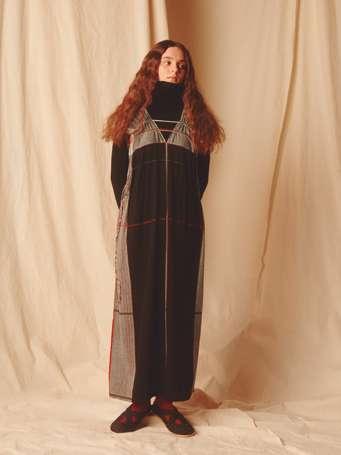
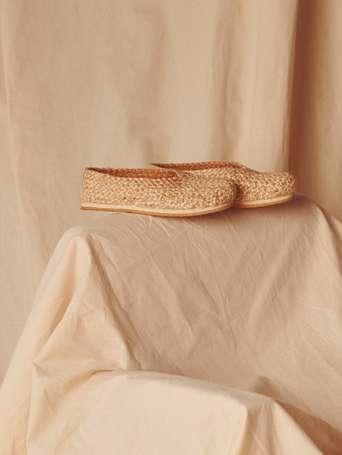
54
SABATES PLA
INSPIRADAS EN LA NATURALEZA
Casi el 22% de la superficie de Mallorca está ocupada por el Pla, una comarca de campos llanos y pequeños pueblos como Algaida, Costitx y Petra, que conservan la arquitectura isleña y un ritmo de vida tranquilo y sencillo. Aquí es donde Irene Peukes diseña sus zapatos. Inspirándose en los materiales naturales, el saber hacer artesano y la sencillez que la rodean, Peukes crea zapatos de yute que ensamblan el diseño actual con la producción artesanal y una perspectiva sostenible.
El resultado de esta visión relajada y respetuosa de la moda son Illetes, Bonanova y Tramuntana, tres modelos unisex que se confeccionan a mano con delicadeza con trenzas de yute y un forro de algodón, y se unen a una suela de textil y crepé natural. No necesita recurrir a otros materiales para crear pares de zapatos que desprenden aire mediterráneo.
Los zapatos son estéticamente sencillos y cautivadores, pero el proceso que hay detrás de cada par que Peukes idea en la isla los hacen realidad una comunidad de mujeres artesanas de Bangladesh con yute local, imprescindible para los pequeños agricultores del país.
Bajo la coordinación de Cáritas Bangladesh siguiendo el estricto Código de Prácticas de Comercio Justo, Irene viaja al país asiático para trabajar mano a mano con las artesanas y supervisar los acabados. Después vuelve a la isla, donde se crea la particular suela suau y donde ambas partes se juntan en un acabado cuidado y contemporáneo.
Además de estos tres modelos emblemáticos de Pla, la firma ha lanzado dos diseños de sandalias, Formentor y Llevant, a partir de suelas de madera y cintas de algodón. Éstas también combinan el saber hacer artesanal. En este caso, el de mujeres guatemaltecas, el de un carpintero que fabrica las suelas anatómicas de madera de pino y el de trabajadores locales que ensamblan a mano las cintas a la suela.
También en Guatemala se producen las prendas textiles de Pla, una colección a modo de cápsula que propone vestidos, blusas y complementos de algodón tejidos a mano. El propósito de Guate va vest, una idea que nació en 2008, es doble: apoyar a la comunidad de artesanas y diseñar de forma que de una pieza de algodón se cree toda la prenda y evitar, así, generar cualquier desperdicio o residuo. Artesanía, comercio justo y respeto.
SABATES PLA
VON NATUR INSPIRIERT
Fast 22% der Fläche Mallorcas nimmt Pla ein, eine ebene Region mit Feldern und kleinen Dörfern wie Algaida, Costitx und Petra, in denen die Architektur der Insel und beschaulich einfache Lebensart bewahrt blieb. Hier entwirft Irene Peukes ihre Schuhe. Inspiriert von Materialien der Natur, handwerklichem Können und der Schlichtheit um sie herum kreiert Peukes Schuhe aus Jute, die zeitgemäßes Design, Handarbeit und Nachhaltigkeit vereinen.
Ergebnis dieser unaufgeregten, achtsamen und dezenten Auffassung von Mode sind Illetes, Bonanova und Tramuntana, drei sorgfältig von Hand mit Jutegeflecht und Baumwollfutter gefertigte Unisex-Modelle mit Sohlen aus Textilfaser und Naturkrepp. Mehr als diese Materialien braucht es nicht, um ein Paar Schuhe mit mediterranem Flair zu fertigen.
Hinter dem Fertigungsverfahren der ästhetisch schlicht gehaltenen, bezaubernden Schuhe, die Peukes auf der Insel kreiert, steht eine Gemeinschaft von Kunsthandwerkerinnen in Bangladesch und der Einsatz hiesiger Jute, unverzichtbare Einnahmequelle für die Kleinbauern des Landes.
Unter Koordination von Caritas Bangladesch und strikter Einhaltung der Fairtrade-Vorgaben reist Irene in das Land Asiens, um gemeinsam mit den Kunsthandwerkerinnen zu arbeiten und die Fertigung zu überprüfen. Auf der Insel entsteht dann die einzigartige Suau-Sohle und beide Teile werden sorgfältig zusammengefügt.
Neben diesen drei für Pla so typischen Modellen brachte das Unternehmen zwei Sandalen-Designs mit Holzsohle und Baumwollbändern auf den Markt, Formentor und Llevant. Ebenfalls Ausdruck handwerklichen Könnens. In diesem Fall das von Frauen aus Guatemala, eines Tischlers, der die anatomischen Sohlen aus Pinienholz herstellt, und hiesiger Arbeiter, die von Hand die Bänder an der Sohle anbringen.
Ebenfalls in Guatemala wird Kleidung von Pla gefertigt, eine Capsule Collection mit handgewebten Kleidern, Blusen und Accessoires aus Baumwolle. Guate va vest steht für eine 2008 geborene Idee mit zwei Zielen: Unterstützung der Gemeinschaft der Kunsthandwerker und ein Design, bei dem das Kleidungsstück aus einem einzigen Stück Baumwolle gefertigt wird, um so Vergeudung und Reste zu vermeiden. Handwerkskunst, Fairtrade und Wertschätzung.
www.pla.org.es
55 SIGNATURE
SLOW LIVING
RECONNECT WITH WELLNESS
Living in the present instead of getting by in a permanent hurry, keeping an eye on sustainability and being firmly in control of time and technology (rather than letting it control us) is now a way of life adopted by more people, and recommended by physical and mental health experts. Caught up in immediacy with one eye always on the clock, we have stopped paying attention to the beauty of everyday life and simple pleasures.
The slow living movement invites us to rethink our priorities, to rediscover what really matters. A good cup of coffee, reading, a walk in the mountains or shopping in a local store are small acts that reconnect us with the present, and with our well-being.
What we buy (and what we decide to stop buying) is closely connected with this philosophy. Strolling leisurely through the local market, chatting with producers and sourcing products that respect people and the environment is one way of living slower and more consciously. There are also more and more businesses that promote sustainable consumption, including NU Market, a bulk-buying store, KM 0 vegetables and zero waste utensils, also serving organic coffee in central Santa Catalina.
Nourishing ourselves with healthy, carefully prepared food is also synonymous of slow living. Luckily, Palma’s artisanal bakeries like Forn de Barri in Fornalutx, S’Era in Sineu, Laroti in Campos and Uco Bakery work with quality flour, without needing to use additives or chemicals in their processes.
The connection with nature is closely connected with this idea of living slower, and Majorca is rather privileged for this. On an island where nature is never far away, it is always a good time to go hiking in the Serra de Tramuntana or to stroll through a beautiful garden like the Jardí Botànic de Sóller, the Alfàbia gardens or the posesión de Raixa gardens.
In Majorca’s villages, the day-to-day rhythm influences this change of pace that many aspire to. Treat yourself to a walk through Fornalutx, Costitx or Porreres and you will see that a more serene, calm and conscious way of living is indeed possible.
56 ADVERTORIAL
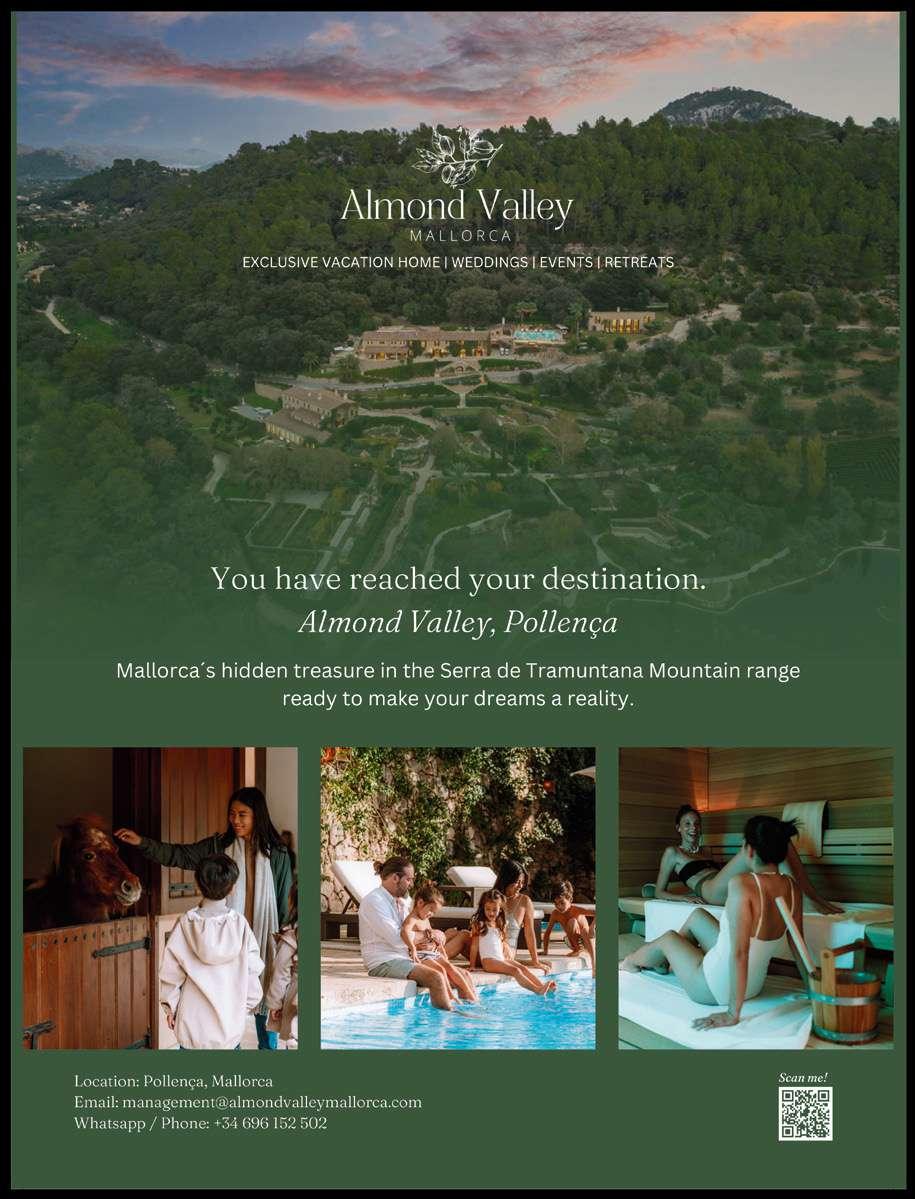
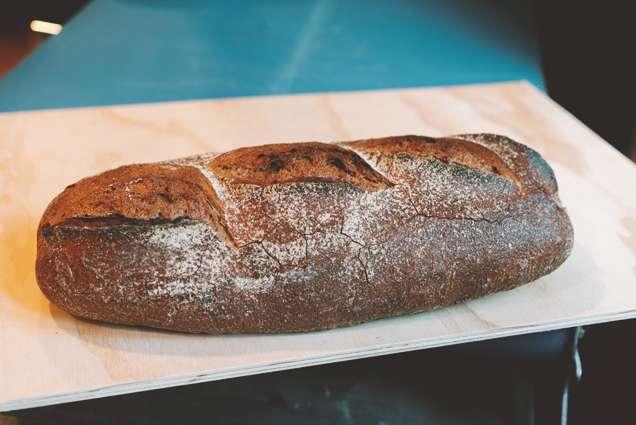

58
Photo: Forn de Barri
Photo: NU Market
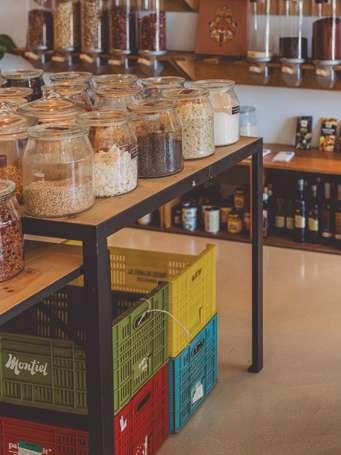

59
Photo: NU Market
Photo: UCO Bakery
SLOW LIVING
RECONECTAR CON EL BIENESTAR
Vivir el presente en lugar de sobrevivir con prisas, con la vista puesta en la sostenibilidad y en un día a día en el que somos nosotros quienes controlamos el tiempo y la tecnología -y no al revés- se está convirtiendo en una forma de vida que cada vez más personas adoptan y expertos en salud física y mental no paran de recomendar constantemente. Absortos en la inmediatez y sometidos al reloj, hemos dejado de prestar atención a la belleza de lo cotidiano y a los placeres sencillos.
El movimiento slow living nos invita a replantearnos nuestras prioridades para reencontrarnos con lo que de verdad importa. Una taza de buen café, una lectura, un paseo por el monte o hacer la compra en una tienda de proximidad son pequeños gestos que nos reconectan con el aquí y el ahora, con el bienestar.
Lo que compramos -y lo que decidimos dejar de comprartiene mucho que ver con esta filosofía. Pasear sin prisa por el mercado de nuestro barrio, charlar con los productores y abastecernos de productos respetuosos con las personas y el medioambiente es una forma de vivir más despacio y más consciente. Además, cada vez encontramos más negocios que reivindican un consumo sostenible, como NU Market, una tienda de productos a granel, verduras KM 0 y utensilios zero waste que también sirve café ecológico en el corazón de Santa Catalina.
Nutrirnos con alimentos saludables y elaborados con mimo también es fomentar el slow living. Por suerte, en la isla encontramos panaderías artesanales que trabajan con harinas de calidad y sin necesidad de añadir aditivos ni químicos al proceso, como Forn de Barri en Fornalutx, S’Era en Sineu, Laroti en Campos o Uco Bakery en Palma.
La conexión con la naturaleza tiene mucho que ver con esta idea de vivir a otro ritmo y Mallorca es un lugar privilegiado en este sentido. En una isla en la que la naturaleza nunca queda lejos, siempre es un buen momento para salir de excursión por la Serra de Tramuntana o regalarse un paseo por alguno de los jardines más bellos, como el Jardí Botànic de Sóller, los jardines de Alfàbia o los jardines de la posesión de Raixa.
El ritmo que se respira en el día a día de los pueblos de la isla tiene algo que decir en este cambio de ritmo al que muchos aspiran. Así que regálate un paseo por Fornalutx, Costitx o Porreres y comprobarás que sí, otra forma de vivir -más serena, más calmada y más consciente- es posible.
SLOW LIVING
ZURÜCK ZUM WOHLBEFINDEN
Gegenwart erleben statt hastig zu überleben, mit Augenmerk auf Nachhaltigkeit und einen Alltag, in dem wir selbst Zeit und Technologie im Griff haben und nicht umgekehrt, steht für eine Lebensart, die immer mehr Menschen übernehmen und die Fachleute für Gesundheit von Körper und Geist stets aufs Neue empfehlen. Von Hektik aufgefressen und dem Diktat der Uhr unterworfen haben wir verlernt, Schönheit des Alltäglichen und Vergnügen des Einfachen wahrzunehmen.
Slow Living weist uns den Weg, durch Überdenken unserer Prioritäten herauszufinden, was uns wirklich wichtig ist. Eine Tasse guten Kaffees, ein Buch, ein Ausflug in die Berge oder Einkaufen in einem Tante-Emma-Laden sind kleine Gesten, die uns wieder mit dem Hier und Jetzt, mit Wohlbefinden verbinden.
Was wir kaufen und was wir nicht mehr kaufen, hat viel mit dieser Einstellung zu tun. Ohne Eile über den Markt in unserem Viertel zu bummeln, ein kleiner Schwatz mit Anbietern und sich mit Erzeugnissen einzudecken, die Mensch und Umwelt achten, gehört ebenfalls zu einer entschleunigten, achtsameren Lebensart. Und auch immer mehr Geschäfte setzen sich für nachhaltigen Konsum ein, z.B. NU Market in Santa Catalina mit einem Angebot loser Waren, 0-Kilometer-Gemüse, Zero-Waste-Produkten und Bio-Kaffee.
Ebenso fördert die Ernährung mit gesunden Lebensmitteln aus sorgsamer Erzeugung Slow Living. Zum Glück gibt es auf der Insel Handwerksbäckereien, in denen man mit hochwertigen Mehlen arbeitet, die beim Backverfahren keinerlei chemische Zusatzstoffe erfordern, wie Forn de Barri in Fornalutx, S’Era in Sineu, Laroti in Campos oder Uco Bakery in Palma.
Einklang mit der Natur hat viel mit dieser anderen Lebensart zu tun und Mallorca ist dafür ein wirklich privilegierter Ort. Auf einer Insel, auf der man der Natur immer nah ist, kann man sich stets Zeit für einen Ausflug in die Serra de Tramuntana nehmen oder für einen Spaziergang durch herrliche Gartenanlagen wie Jardí Botànic in Sóller, Alfàbia oder auf dem Landgut Raixa.
Auch das gemächliche Alltagsleben in den Dörfern der Insel bietet diese von vielen ersehnte andere Lebensart. Also gönnen Sie sich einen Bummel durch Fornalutx, Costitx oder Porreres und Sie werden sehen, dass ein anderes Leben mit mehr Gelassenheit, innerer Ruhe und Achtsamkeit möglich ist.
60 ADVERTORIAL

AL ORIGEN PASSION FOR WOOD
Majorcan brand Al Origen pays tribute to wood in its original state, free from modifications, restoring its natural beauty using traditional processes and craftsmanship that respects the environment and people.
Following a philosophy in danger of disappearing due to mass production processes, a team of carpenters and designers who are ‘passionate about wood, its craft and benefits, touch and aroma, patina and colors’ give this natural resource a second use, and life from their Palma studio.
The result of their laborious, delicate work are tables, furniture, cabinets, doors, kitchens, decorative objects and even floors that, transmit the ancestral beauty of wood, preserving the traces of the passage of time and the passion they pour into their work.
The three island showrooms (Al Origen and Al Origen Kitchen’s in Carrer Despuig 62 in the Santa Catalina neighborhood and Al Origen Santa Ponsa) showcases their exquisite savoir faire, reflected in each project. This includes their custom kitchens, made from reclaimed old wood fronts and combined with state-of-the-art hardware and appliances from leading brands.
Al Origen also incorporates hand-held handles, knobs and closures made by hand by local craftsmen with different materials like brass and iron, and interior finishes with handmade ceramic pieces and natural fabrics.
Their creations have their own character and can be adapted to both rustic and contemporary homes with the aesthetic strength of the past yet with a modern design. Exciting craftsmanship using the essence and beauty of living wood that is installed in our homes once separated from the earth in the form of rooms and pieces of quality, unique and durable furniture.
www.al-origen.com
62 ART & DESIGN
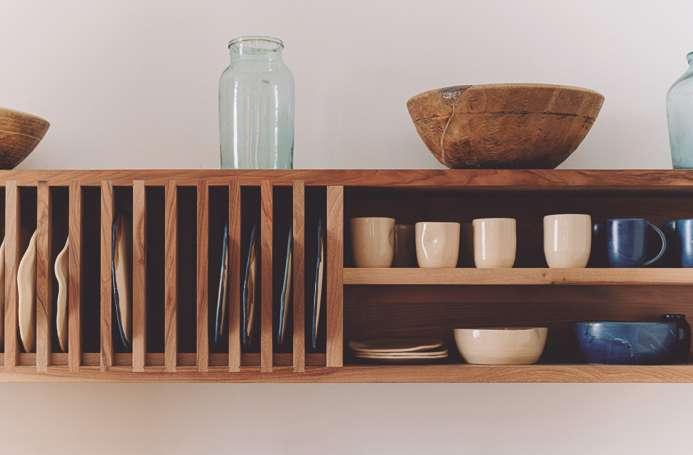

63
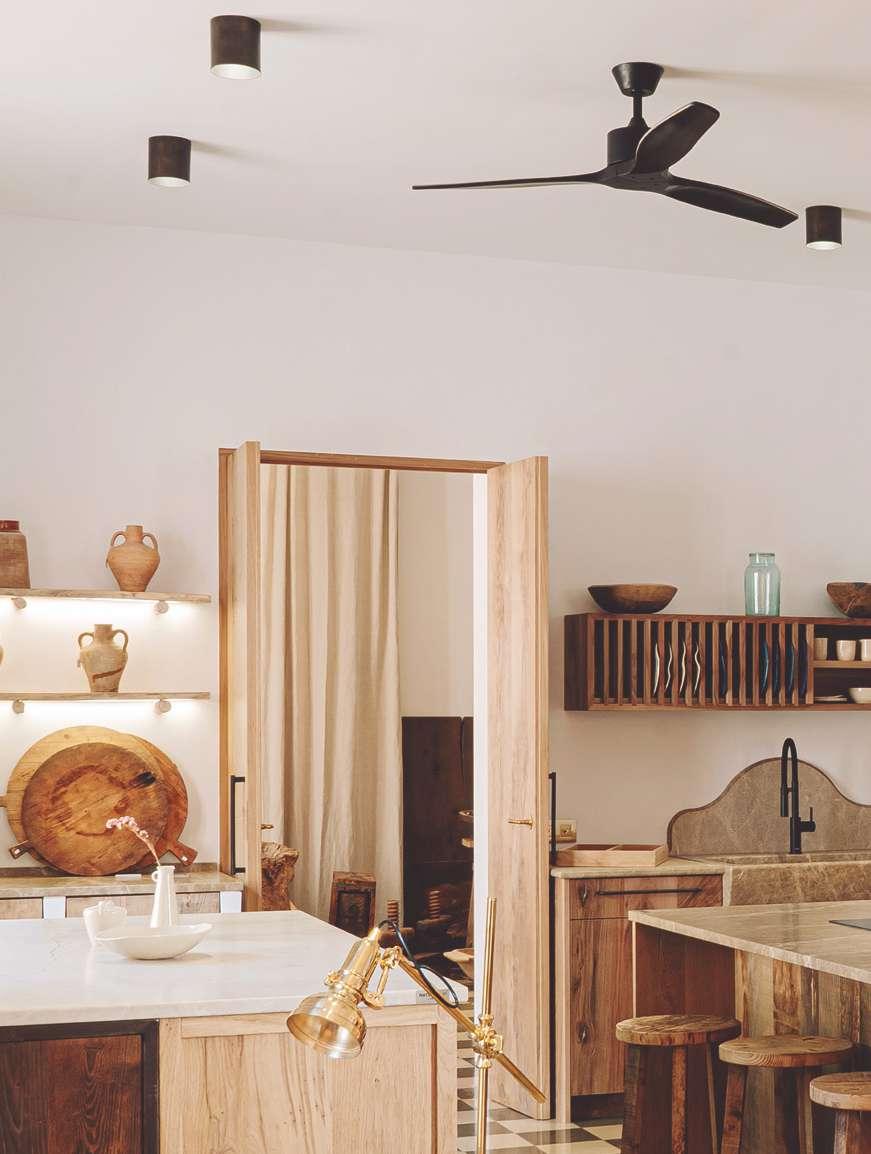

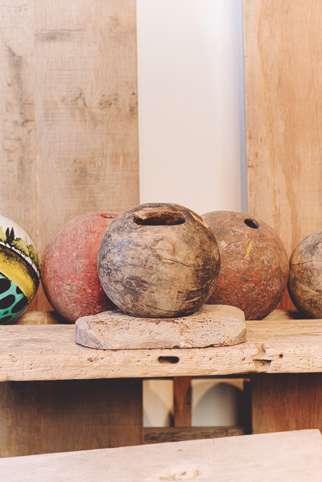

66
AL ORIGEN
PASIÓN POR LA MADERA
La marca mallorquina Al Origen rinde tributo a la madera en su estado original –sin artificios ni alteraciones- y recupera su belleza natural en una vuelta al origen de los procesos y a la artesanía respetuosa con el entorno y las personas.
Siguiendo una filosofía que ha estado a punto de desaparecer a causa de los procesos de fabricación en serie, en su taller de Palma, un equipo de carpinteros y diseñadores ‘apasionados de la madera, de su oficio y beneficio, de su tacto y su aroma, de su pátina y sus colores’ -como a ellos mismos les gusta definirse- recuperan este recurso natural para darle un segundo uso, una nueva vida.
El resultado de su laborioso y siempre delicado trabajo son mesas, muebles, armarios, puertas, cocinas, objetos decorativos e incluso suelos que, sin lugar a dudas, logran transmitir la belleza ancestral de la madera que conserva las huellas del paso del tiempo y la pasión con la que trabajan con este material.
En los tres showrooms que actualmente pueden visitarse en la isla (Al Origen y Al Origen Kitchen’s en carrer Despuig 62 en el barrio de Santa Catalina y Al Origen Santa Ponsa), uno descubre que su exquisito savoir faire, que se plasma en cada proyecto que la firma afronta. Entre ellos, destacan sus cocinas a medida, fabricadas a partir de frentes de madera antigua recuperada y combinadas con herrajes de última generación y electrodomésticos de primeras marcas del sector.
Además, en colaboración con artesanos locales, Al Origen incorpora a sus diseños manetas, pomos y cierres a medida fabricados a mano con diferentes materiales como el latón y el hierro, y acabados interiores con piezas de cerámica artesanal y telas naturales.
Con carácter propio, sus creaciones se adaptan tanto a hogares de ambiente rústico como contemporáneo con la fuerza estética del pasado pero con un diseño actual. Artesanía que emociona a través de la esencia y la belleza de la madera viva que, una vez separada de la tierra, se instala en nuestras casas en forma de estancias y piezas de mobiliario de calidad, duraderas e irrepetibles.
AL ORIGEN
LEIDENSCHAFT FÜR HOLZ
Bei der mallorquinischen Marke Al Origen erweist man Holz im ursprünglichen Erscheinungsbild höchste Ehrerbietung und bringt seine natürliche Schönheit mit der Rückkehr zu althergebrachten, auf Mensch und Umwelt bedachten handwerklichen Verfahren bestens zur Geltung.
‘Aus Leidenschaft zu Holz, dessen Vorzügen und Verarbeitung, Haptik und Duft, Patina und Farbtönen’, wie sie selbst gern zu sagen pflegen, folgen Tischler und Designer in ihrer Werkstatt in Palma einer Philosophie, die aufgrund der Massenproduktion fast schon verloren ging, und geben diesem natürlichen Rohstoff eine zweite Verwendung, ein neues Leben.
Das Ergebnis ihrer aufwendigen, akribischen Arbeit sind Tische, Möbel, Schränke, Türen, Küchen, dekorative Gegenstände bis hin zu Fußböden, die unfehlbar die ursprüngliche, vom Lauf der Zeit geprägte Schönheit von Holz und ihre eigene Hingabe bei seiner Bearbeitung widerspiegeln.
In den gegenwärtig drei Showrooms auf der Insel (Al Origen und Al Origen Kitchen’s in der Carrer Despuig 62 im Viertel Santa Catalina und Al Origen Santa Ponsa) erkennt man unschwer das meisterhafte Können, das bei jedem Projekt des Unternehmens zum Ausdruck kommt. Besonders bemerkenswert sind die maßgefertigten Küchen aus wiederaufgearbeiteten, rustikalen Holzfronten, kombiniert mit topmodernen Armaturen und hochwertigen Elektrogeräten führender Marken der Branche.
In Zusammenarbeit mit hiesigen Kunsthandwerkern verwendet man für die Designs von Al Origen handgefertigte Griffe, Knäufe und Schlösser aus verschiedenen Materialien wie Messing und Eisen und Innenausstattungen mit Keramikteilen und Naturstoffen.
Mit ihrem ganz eigenen Stil aus kraftvoller Optik der Vergangenheit und Zeitgeist-Design passen diese Kreationen bestens zu Haushalten im rustikalen wie auch im modernen Stil. Kunsthandwerk, das durch Art und Schönheit lebendig wirkenden Holzes besticht, das einmal dem Boden entrissen in unseren Häusern als wertvolle, langlebige und einzigartige Einrichtung und Möbelstücke weiterlebt.
www.al-origen.com
67 ART & DESIGN
PALMA’S INTERNATIONAL BOAT SHOW
40 YEARS OF NAUTICAL GLAMOUR
Celebrating its 40th anniversary, the Palma International Boat Show (PIBS) and Superyacht Village (SYV) are poised to captivate Palma de Mallorca from April 25th to 28th, 2024, heralding the grand opening of the Mediterranean season. Nestled in the iconic Marina Moll Vell, within sight of Palma’s majestic La Seu Cathedral and walking distance of the iconic Paseo del Borne street, with its designer boutiques, hotels, and restaurants, the summer season starter events serve as a pivotal rendezvous for yacht buyers, charterers, and enthusiasts. It’s also a moment for industry professionals to converge in the heart of the Balearic Islands.
For prospective buyers and charterers, the Palma Superyacht Village stands out as a unique opportunity. Beyond being a showcase, it serves as the exclusive pre-season event where significant transactions are brokered. This distinction becomes particularly crucial during the traditionally bustling sales period, allowing buyers to meticulously inspect multiple yachts, make offers, conduct surveys, sea trials, and ensure their vessels are primed for the cruising season to begin. It’s more than just a show; it’s a gateway to the sea, ensuring yacht enthusiasts can set sail promptly, maximizing the value of their precious downtime.
This edition of Superyacht Village features around 80 luxury yachts, each exceeding 24 meters, creating an extravagant display for potential buyers and charter clients. The show’s global appeal is palpable through its diverse network of exhibitors, industry professionals, and visitors. The Palma Superyacht Village transcends the traditional boat display, incorporating the Refit & Repair zone and the Yachting Ventures Innovation Corner to cater to forward-thinking industry professionals. Additionally, the inaugural Mallorca Yachting Summit provides a platform for insightful discussions.
Sustainability takes centre stage at PIBS and SYV, emphasizing the measurement of the carbon footprint, efficient waste management, and responsible water consumption. These initiatives align with the evolving values of the yachting community, transforming the event beyond showcase into a leading force for change in the industry.
Set against the picturesque backdrop of Palma de Mallorca, the 2024 show promises an immersive experience blending tradition, technology, sustainability, and the allure of the Mediterranean. Exclusive F&B areas such as the Tast Out Gastro Bar and Fosh Oasis elevate the event into a luxurious lifestyle experience. This cements the Palma International Boat Show and Superyacht Village as an indispensable part of the yachting calendar. A true celebration of nautical excellence in its 40th year, the Palma International Boat Show and Superyacht Village offer an unrivalled yachting experience at the cusp of the Mediterranean summer season for All to enjoy.
68 ADVERTORIAL


69


70
SALÓN NÁUTICO
INTERNACIONAL DE PALMA
40 AÑOS DE GLAMOUR NÁUTICO
La temporada estival mediterránea arranca en Palma del 25 al 28 de abril con la 40 edición del Salón Náutico Internacional de Palma (PIBS) y Superyacht Village (SYV). Celebrado en la emblemática Marina Moll Vell, cerca de la majestuosa Catedral de La Seu de Palma y de la emblemática calle Paseo del Borne, sus boutiques de diseño, hoteles y restaurantes, se trata de una cita imprescindible para los compradores de yates, charters y entusiastas. También es una ocasión para que los profesionales de la industria coincidan en el corazón de las Islas Baleares.
Para posibles compradores y fletadores, el Palma Superyacht Village es una oportunidad verdaderamente única. Más allá de ser un escaparate, es un evento exclusivo de pretemporada en el que se negocian grandes transacciones. Un evento que resulta especialmente crucial durante el periodo de ventas, que suele ser muy ajetreado, ya que permite a los compradores inspeccionar meticulosamente varios yates, hacer ofertas, realizar estudios, pruebas de navegación y asegurarse de que sus embarcaciones están preparadas para el comienzo de la temporada. Es más que un espectáculo; es una puerta al mar, que garantiza a los aficionados a los yates poder zarpar con prontitud, maximizando el valor de su valioso tiempo de ocio.
Esta edición de Superyacht Village cuenta con alrededor de 80 yates de lujo, cada uno de más de 24 metros, creando una extraordinaria exhibición para posibles compradores y clientes de charter. El atractivo global de la feria es palpable a través de su diversa red de expositores, profesionales de la industria y visitantes. El Palma Superyacht Village trasciende el tradicional salón náutico, incorporando la zona Refit & Repair y el Yachting Ventures Innovation Corner para atender a profesionales de la industria con visión de futuro. Además, el Mallorca Yachting Summit inaugural ofrece una plataforma para enriquecedores debates.
La sostenibilidad es protagonista en PIBS y SYV, haciendo hincapié en la medición de la huella de carbono, la gestión eficiente de residuos y el consumo responsable de agua. Estas iniciativas se alinean con los valores cambiantes de la comunidad náutica, transformando el evento más allá del escaparate en una fuerza líder para el cambio en la industria.
Con Palma de Mallorca como telón de fondo, la edición 2024 ofrece una experiencia inmersiva que combina tradición, tecnología, sostenibilidad y el atractivo del Mediterráneo. Áreas exclusivas de restauración como el Tast Out Gastro Bar y Fosh Oasis elevan el evento a una lujosa experiencia de estilo de vida, consolidando al Salón Náutico Internacional de Palma y el Superyacht Village como parte indispensable del calendario náutico. Una verdadera celebración de la excelencia náutica en sus 40 años, el Salón Náutico Internacional de Palma y Superyacht Village ofrecen una experiencia náutica inigualable a las puertas del verano para el disfrute de todos.
PALMA INTERNATIONAL BOAT SHOW
40 JAHRE NAUTIK VOM FEINSTEN
Das 40. Jubiläum von Palma International Boat Show (PIBS) und Superyacht Village (SYV) wird vom 25. bis zum 28. April 2024 alle Blicke auf sich ziehen und eine großartige Mittelmeer-Saison eröffnen. Am Marina Moll Vell mit Kultstatus, gut sichtbar von Palmas erhabener Kathedrale La Seu aus und nicht weit vom renommierten Paseo del Borne mit Designer-Boutiquen, Hotels und Restaurants entfernt, sind die Events zum Start der Sommersaison Anziehungspunkt für Käufer, Charterer und Liebhaber von Yachten und auch bester Moment für Treffen mit Fachleuten der Branche auf den Balearen.
Für interessierte Käufer und Charterer ist Palma Superyacht Village eine einmalige Gelegenheit als Schaufenster und mit exklusiven Events vor Saisonstart für wichtige Geschäftsabschlüsse. Diese Besonderheit ist zur traditionell üblichen Zeit für Verkauf und Erwerb von Yachten maßgeblich, denn sie ermöglicht das genaue Inspizieren mehrerer Yachten durch Käufer, Unterbreiten von Angeboten, Besichtigungen, Probefahrten und Sicherstellen, dass die Boote bestens für die beginnende Kreuzfahrtsaison gerüstet sind. Mehr als nur Show öffnet sich hier ein Tor zum Meer, von dem aus Yacht-Begeisterte sofort in See stechen und ihre kostbare Zeit optimal nutzen können.
Bei dieser Auflage von Superyacht Village mit mehr als 80 Luxusyachten, jede länger als 24 Meter, erschließt sich potentiellen Käufern und Charterern ein außergewöhnliches Panorama internationaler Attraktivität durch das große Netzwerk von Ausstellern, Fachleuten und Besuchern. Mit Refit & Repair-Bereich und Yachting Ventures Innovation Corner für zukunftsorientierte Branchen-Profis geht Palma Superyacht Village weit über jede herkömmliche Bootsmesse hinaus und mit der ersten Mallorca Yachting Summit gibt es eine Plattform für interessante Gesprächsrunden.
Um Nachhaltigkeit dreht sich alles bei PIBS und SYV mit besonderem Augenmerk auf Messung des CO₂-Fußabdrucks, effizientes Abfallmanagement und verantwortungsbewussten Wasserverbrauch. Diese Initiativen im Einklang mit sich weiterentwickelnden Werten der Yachting-Community machen das Event zum Paradebeispiel führender Kräfte für Veränderungen in der Branche.
Mit der malerischen Stadt Palma de Mallorca im Hintergrund verspricht die Show 2024 ein faszinierendes Erlebnis, das Traditionsliebe, Technik, Nachhaltigkeit und mediterranes Flair vereint und mit exklusiven Angeboten für Speis und Trank wie Tast Out Gastro Bar und Fosh Oasis wird das Event zum luxuriösen Lifestyle-Erlebnis. All das macht Palma International Boat Show und Superyacht Village zum unverzichtbaren Muss im Yachting-Kalender. Palma International Boat Show und Superyacht Village bieten zu ihrem 40. Jubiläum ein wahres Fest nautischer Spitzenleistung und zu Beginn der Sommersaison am Mittelmeer ein genussvolles Yacht-Erlebnis ohnegleichen für alle.
71 ADVERTORIAL

TASSABENE
MODERN TAILORING TRUE TO THE ESSENCE OF TRADITION
Nina Coll is the creative director behind the unique and exclusive outfits that Trassabene creates for each of its clients. She, together with her partners Josep Garí (founding partner), Miguel Carrió and Pau Real (CEOs of the brand), have created a new way of understanding tailoring in Mallorca. In this interview, they open the doors to the world of tailoring, an ancient craft that is almost an art, capable of creating suits that feel like a second skin.
Nina Coll es la directora creativa que se esconde detrás de los trajes que Trassabene crea de manera única y exclusiva para cada uno de sus clientes. Ella, junto a sus socios Josep Garí (socio fundador), Miguel Carrió y Pau Real (CEOs de la marca), han creado una nueva forma de entender la sastrería en Mallorca. En esta entrevista, nos abren las puertas al mundo de la sastrería, un oficio milenario y cercano al arte, capaz de crear trajes que sientan como una segunda piel.
Nina Coll, Kreativdirektorin exklusiver, für jeden Kunden einzigartiger Anzüge von Tassabene, steht mit ihren Partnern, Josep Garí (Gründungspartner), Miguel Carrió und Pau Real (CEOs der Marke) für ein neues Verständnis von Schneiderkunst auf Mallorca. Mit diesem Interview eröffnen sie uns die Welt der Schneiderei, jahrtausendealtes Handwerk, fast schon Kunst, zur Fertigung von Anzügen, die wie eine zweite Haut sitzen.
72 SIGNATURE

What is Tassabene’s story?
It all started at a summer dinner with friends. Two of us shared the same passion for fashion and tailoring, with very different styles though, and that’s where the idea of fusing classic tailoring with a more edgy style started.
It was in 2021 that we started testing with family and friends and discovered that there was more interest on the island than we thought. That’s when we realised that the world of bespoke tailoring was wider than we had imagined, and that’s what made it fun, not having a clue what we were getting into.
How many hours are invested in making a tailor-made suit?
What would be Tassabene’s hallmark?
Without a doubt, we are committed to a more modern tailoring without losing the traditional essence. There are no age ranges or specific profiles. There is room for the lawyer who wears a suit every day, for the formal groom and for the ‘more fashionable’ man who combines a houndstooth blazer in mustard tones with jeans.
Why are there fewer and fewer tailors?
Being a tailor is very vocational, and the worst thing is that there are few left, as you have said, and those who are left either give their knowledge to the next generation or decide it dies with them.
There is an anecdote that exemplifies this, and that is when our creative director was finishing her degree; at that time, there was still one tailor on the island who was completely vocational. One morning before going to university, she knocked on his door to ask for an unpaid internship, and the tailor’s answer was a resounding no. He was not interested.
Weeks. There is a process of getting to know and understanding the customer, their tastes and needs that can vary depending on the suit and the customer. It is a very thorough job. instagram.com/tassabene

73 SIGNATURE


¿Cuál es la historia de Tassabene?
Pues todo surge en una cena de verano entre amigos. Dos de nosotros compartíamos la misma pasión por la moda y la sastrería, aunque con estilos muy diferentes y ahí empezó la idea de fusionar sastrería clásica con un estilo más cañero.
Fue en 2021 cuando empezamos a hacer pruebas con la familia y amigos y descubrimos que en la isla el interés era mayor del que pensábamos. Ahí nos dimos cuenta de que el mundo de la sastrería a medida era más amplio de lo que imaginábamos y eso fue lo que nos divirtió, el no tener ni idea de donde nos estábamos metiendo.
¿Cuántas horas se invierten en hacer un traje a medida?
Semanas. Hay un proceso de conocimiento y entendimiento del cliente, sus gustos y sus necesidades que puede variar en función del traje y el cliente. Es un trabajo muy minucioso.
¿Cuál sería el sello de distinción de Tassabene?
Sin duda apostamos por una sastrería más moderna sin perder la esencia tradicional. No hay rangos de edad ni perfiles concretos. Hay cabida para el abogado que lleva traje a diario, para el novio protocolario y para el hombre ‘más moda’ que combina americana pata de gallo en tonos mostaza con unos Jeans.
¿Por qué cada vez hay menos sastres?
Ser sastre es muy vocacional y lo peor de todo es que quedan pocos como bien has dicho, y los que quedan o regalan sus conocimientos a la siguiente generación o deciden llevárselo todo a la tumba.
Hay una anécdota que lo ejemplifica, y es cuando nuestra directora creativa estaba terminando la carrera, en ese momento en la isla quedaba el último de los sastres completamente de vocación. Una mañana antes de entrar a la universidad fue a llamar a su puerta para pedirle prácticas no remuneradas y la respuesta del sastre fue un rotundo no.
instagram.com/tassabene
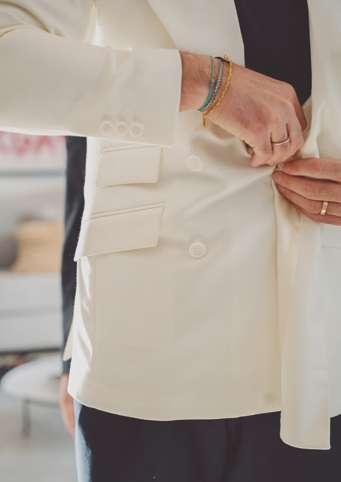
74 SIGNATURE

Woher kommt Tassabene?
Alles begann bei einem Abendessen im Sommer mit Freunden, zwei von uns mit der gleichen Begeisterung für Mode und Schneiderei, allerdings für sehr verschiedene Stilrichtungen. So nahm die Idee Gestalt an, klassisches Schneiderhandwerk mit ausgefallenem Stil zu vereinen.
2021 testeten wir erstmals bei Verwandten und Freunden und stellten fest, dass das Interesse auf der Insel größer als gedacht, dass die Welt der Maßschneiderei weiter als vorgestellt war. Genau darin lag für uns der Reiz, dass wir so gar keine Ahnung hatten, worauf wir uns da einließen.
Wie viele Stunden braucht man für einen maßgefertigten Anzug?
Wochen. Es ist ein Vorgang zum Kennenlernen und Verstehen des Kunden, seines Geschmacks und seiner Ansprüche, die je nach Anzug und Kunde unterschiedlich sind, eine sehr aufwändige Arbeit.
Was ist das Alleinstellungsmerkmal von Tassabene?
Wir setzen in jedem Fall auf zeitgemäßes Schneiderhandwerk und Treue zur Tradition. Es gibt keine Altersgrenze oder konkrete Profile. Für den Anwalt, der täglich Anzug trägt, für den Bräutigam an seinem großen Tag und für den modebewussten Herrn, der Hahnentritt-Blazer in Senftönen mit Jeans kombiniert.
Warum gibt es immer weniger Schneider?
Schneider zu sein hat viel mit Berufung zu tun. Das Schlimme ist, wie gesagt, dass es immer weniger gibt und die wenigen geben ihr Können an die nächste Generation weiter oder beschließen, es mit ins Grab zu nehmen.
Eine Anekdote belegt das sehr gut. Zu dem Zeitpunkt, als unsere Kreativdirektorin ihr Studium beendete, gab es auf der Insel nur noch einen Schneider aus Berufung. Eines Morgens auf dem Weg zur Universität klopfte sie an seine Tür und bat um ein unbezahltes Praktikum. Die Antwort des Schneiders war ein eindeutiges Nein.
instagram.com/tassabene

75 SIGNATURE
WORLD CUISINE
A GASTRONOMIC JOURNEY
Good food unites foodies around the world because it becomes an experience. Every mouthful is capable of stimulating our senses, transporting us to another part of the world, or evoking memories - like gold dust for gastronomy lovers. That’s why we always want to know more about culinary traditions: the subtle nuances between Indian spices, sushi varieties from different Japanese regions, the ideal quesadilla ingredients or the exact formula for French pastry. We are naturally curious, and always on the lookout for new restaurants. For us, the words sashimi, taco, macaron or tikka masala rhyme with pleasure.
Majorca has its own much-loved gastronomic traditions that we love and respect, but we are always attentive and willing to discover alternatives from Japan, Mexico, Tunisia, or India, among others. If you wish to discover dishes and recipes from around the world, here are some must-visit restaurants, bringing their gastronomic traditions to our Mediterranean island. Get ready to be surprised by new flavours that will take you on a journey without leaving your chair. Just book a table and get ready to enjoy your gastronomic journey.

76 GASTRO
Photo: Manataco
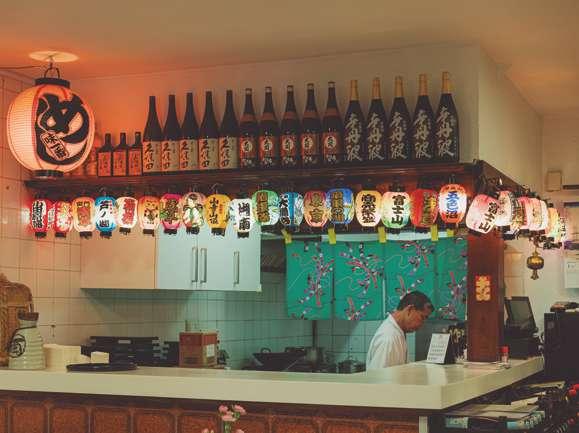
COCINAS DEL MUNDO
UN VIAJE GASTRONÓMICO
La buena comida une a los foodies de todo el mundo porque la viven –o mejor dicho, la vivimos- como una experiencia. Cada bocado capaz de hacer vibrar nuestros sentidos, de transportarnos a otro lugar del planeta, de evocar recuerdos… es oro puro para los que amamos la gastronomía. Por eso siempre queremos saber más sobre las tradiciones culinarias: los sutiles matices entre las especias de la India, las variedades de sushi de las diferentes regiones de Japón, los ingredientes idóneos para cocinar la mejor quesadilla o la fórmula exacta de la repostería francesa. Somos curiosos por naturaleza, siempre estamos buscando nuevos restaurantes. Para nosotros, las palabras sashimi, taco, macaron o tikka masala son sinónimo de placer.
En Mallorca se cuece una tradición gastronómica que amamos y respetamos a partes iguales, pero siempre nos mantenemos atentos y dispuestos a descubrir nuevas propuestas culinarias, de aquí y de allá, de Japón hasta México, de Túnez hasta la India. Con el propósito de que tú también descubras platos y recetas típicas de diferentes partes del globo, hemos reunido algunos de los restaurantes imprescindibles que han acercado tradiciones gastronómicas lejanas hasta esta isla del Mediterráneo. Atrévete a dejarte sorprender por nuevos sabores que te llevarán de viaje sin levantarte de la silla. Esta es una travesía gastronómica para la que solo necesitas reservar mesa y estar dispuesto a disfrutar.
KÜCHEN AUS ALLER WELT
EIN KULINARISCHER STREIFZUG
Gutes Essen verbindet Foodies überall auf der Welt, denn für sie, besser gesagt, für uns ist es ein Erlebnis. Jeder Bissen, der all unsere Sinne betört, uns an andere Orte der Welt versetzt, Erinnerungen beschwört… ist reines Gold für uns, die wir Gastronomie lieben. Daher wollen wir auch immer mehr über kulinarische Traditionen erfahren, über die feinen Nuancen indischer Gewürze, über Varianten von Sushi aus verschiedenen Regionen Japans, über die richtigen Zutaten für beste Quesadillas oder das genaue Rezept für französisches Feingebäck. Von Natur aus neugierig sind wir immer auf der Suche nach neuen Restaurants. Wörter wie Sashimi, Taco, Macaron oder Tikka Masala sind für uns gleichbedeutend mit Hochgenuss.
Auf Mallorca kocht man auf traditionsreiche Art, die wir gleichermaßen lieben und achten, aber wir sind auch stets offen und bereit für neue kulinarische Angebote von hier und von da, von Japan bis Mexiko, von Tunesien bis Indien. Damit auch Sie in den Genuss typischer Gerichte und Rezepte aus aller Welt kommen, haben wir für Sie einige der Muss-Restaurants zusammengestellt, die kulinarische Traditionen aus fernen Ländern zu uns auf die Insel bringen. Gönnen Sie sich eine Reise zu überraschend neuen Geschmackswelten. Sie brauchen dafür noch nicht mal vom Stuhl aufzustehen. Sie brauchen nur eine Tischreservierung und Ihre Vorfreude auf Hochgenuss.
77 GASTRO
Photo: Hanaita
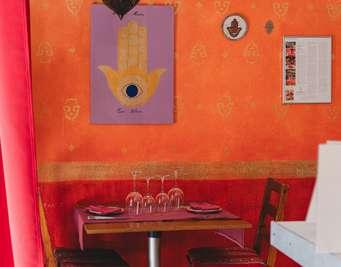

A MA MAISON
PALMA, MALLORCA
Located in Palma’s cosmopolitan Santa Catalina neighbourhood, A ma Maison serves a variety of French-Tunisian dishes known for their flavours (lamb is a speciality) and are prepared upon demand by owner Saloua Sfar. Preparing the dishes from scratch makes it possible to adapt them to any dietary requirements or intolerances: vegan, gluten/sugar-free. A Ma Maison stands out for its friendly atmosphere and service as well as its excellent food.
KRISHNÁ
POLLENÇA, MALLORCA
Since opening their first restaurant in 2011, Krishná has offered authentic, top-quality, homemade Indian food and an experience that takes you straight to the streets of India. Its menu is a perfect blend of flavors, aromas and textures, from its popular curries to soft and creamy vegetarian dishes. They currently have 2 restaurants, one in the famous Carrer de Sant Magí in the Santa Catalina neighbourhood and the second in Portals Nous.
Situado en el cosmopolita barrio de Santa Catalina Palma Mallorca, A ma Maison sirve una variedad de platos francotunecinos que destacan por sus sabores (el cordero es un plato imprescindible) y que se preparan al momento por su dueña, Saloua Sfar. El hecho de que los platos se preparen desde cero permite adaptarlos a cualquier requisito, veganos, sin gluten o adaptarlos a cualquier intolerancia. Justo a su excelente oferta gastronómica, A Ma Maison destaca también por su ambiente y servicio creando una atmosfera muy acogedora.
Desde que abrieron su primer restaurante en 2011, desde Krishná se han dedicado a ofrecer comida india casera y original enfocada en la calidad y la autenticidad ofreciendo una experiencia capaz de transportarte a las calles de la India. Su carta es una mezcla perfecta de sabores, aromas y texturas donde destacan desde sus populares currys hasta los suaves y cremosos platos vegetarianos. Actualmente cuentan con 2 locales, uno en una de las calles más famosas del barrio de Santa Catalina, San Magín, y el segundo en Portals Nous.
Das A Ma Maison in Palmas weltoffenen Viertel Santa Catalina besticht durch Geschmacksvielfalt einer Fülle französischtunesischer Gerichte (Lamm sollte man unbedingt probieren), die von der Inhaberin, Saloua Sfar, im Moment zubereitet werden. Das Zubereiten jedes einzelnen Gerichts von Grund auf ermöglicht es, Anforderungen jeder Art, vegan, gluten- oder zuckerfrei, und jede Unverträglichkeit, zu berücksichtigen. Zum erstklassigen gastronomischen Angebot gesellt sich im A Ma Maison besonders behagliches Ambiente und bester Service.
Seit der Eröffnung des ersten Restaurants 2011 bietet man bei Krishná indische Hausmacherkost nach Originalrezepten mit Höchstmaß an Qualität und Unverfälschtheit. Ein Erlebnis, bei dem Sie sich in die Straßen Indiens versetzt fühlen. Die Speisekarte ist der perfekte Mix aus Geschmacksvielfalt, Aromen und Texturen, von beliebten Currys bis hin zu mild cremigen vegetarischen Gerichten. Gegenwärtig gibt es 2 Restaurants, eins in einer der berühmtesten Straßen des Viertels Santa Catalina, San Magín, und das andere in Portals Nous.
78 GASTRO
Calle Soler, 18A. Palma +34 971 91 96 97 Carrer de Sant Magí, 11. Palma +34 612 21 78 76
HANAITA
PALMZ, MALLORCA
This unique restaurant has been one of Palma’s gastronomic references for over 30 years and is considered one of Palma’s best Japanese restaurants. Unlike the modern restaurants that dominate the city’s urban landscape, Hanaita remains true to its traditional Japanese roots. Enter this humble restaurant through classic Japanese curtains and feel instantly transported to another world. Its menu offers a variety of authentic, carefully prepared and presented Japanese dishes, that will take you on a culinary Japanese road trip.
Este singular restaurante es un referente gastronómico de la ciudad desde hace más de 30 años y está considerado uno de los mejores restaurantes japoneses de Palma. A diferencia de los modernos restaurantes que dominan el paisaje urbano de Palma, Hanaita se mantiene fiel a su estética tradicional japonesa. Al entrar en este humilde restaurante a través de las clásicas cortinas japonesas, uno se siente inevitablemente transportado a otro mundo. Su carta ofrece una variedad de auténticos platos japoneses, cuidadosamente preparados y presentados que te embarcarán en un viaje culinario a Japón.
Dieses einmalige Restaurant, seit mehr als 30 Jahren gastronomischer Fixpunkt der Stadt, gilt als eins der besten japanischen Restaurants in Palma. Im Gegensatz zu anderen, modern minimalistisch eingerichteten Japanern, die Palmas Stadtbild prägen, ist man im Hanaita seiner traditionell japanischen Ästhetik treu geblieben. Wenn man dieses eher schlichte Restaurant durch die klassisch japanischen Vorhänge betritt, landet man unweigerlich in einer anderen Welt. Auf der Speisekarte steht eine Fülle unverfälscht japanischer Gerichte, sorgsam zubereitet und präsentiert, eine kulinarische Reise nach Japan.
MANATACO
PALMA, MALLORCA
If you’re passionate about tacos and Mexican food culture, look no further. Located in the central Plaza Chopin and surrounded by spectacular art galleries, Manataco exudes a Mexican vibe through its authentic and carefully prepared recipes from Mexico City.
The famous taco al pastor, enchiladas, quesadillas, antojitos, home-made chili sauces and drinks as spicy as you dare - discover the best food and beverages that this great country has to offer.
Si eres un apasionado de los tacos y de toda la cultura gastronómica mexicana, este es tu lugar. Ubicado en la céntrica plaza Chopin y rodeado por las más espectaculares galerías de arte, en Manataco vas a poder sentir México en la piel a través de auténticas recetas de Ciudad de México que se encargan de ejecutar con maestría.
El famoso taco al pastor, las quesadillas, antojitos, salsas caseras de chiles y los tragos más picosos que puedas probar, aquí podrás descubrir todo lo que este gran país ofrece tanto para comer como para beber.
Wenn Sie Tacos und die gesamte gastronomische Kultur Mexikos lieben, sind Sie hier genau richtig. Im Manataco am zentral gelegenen Plaza Chopin mit grandiosen Kunstgalerien in der Nachbarschaft werden Sie sich wie in Mexiko fühlen, denn die nach Rezepten aus Mexiko-City meisterhaft zubereiteten Gerichte sind unverfälscht.
Der berühmte Taco al pastor, Quesadillas, Antojitos, hausgemachte Chilisaucen und die pikantesten Drinks. Hier können Sie alles entdecken, was dieses großartige Land an Speis und Trank zu bieten hat.
45 20 13

22 79 74
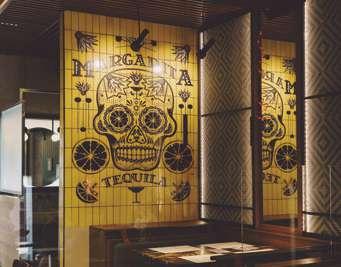
79 GASTRO
Plaça de la Navegació, 8. Palma +34 971
Carrer de Ca’n Puigdorfila, 2. Palma +34 971
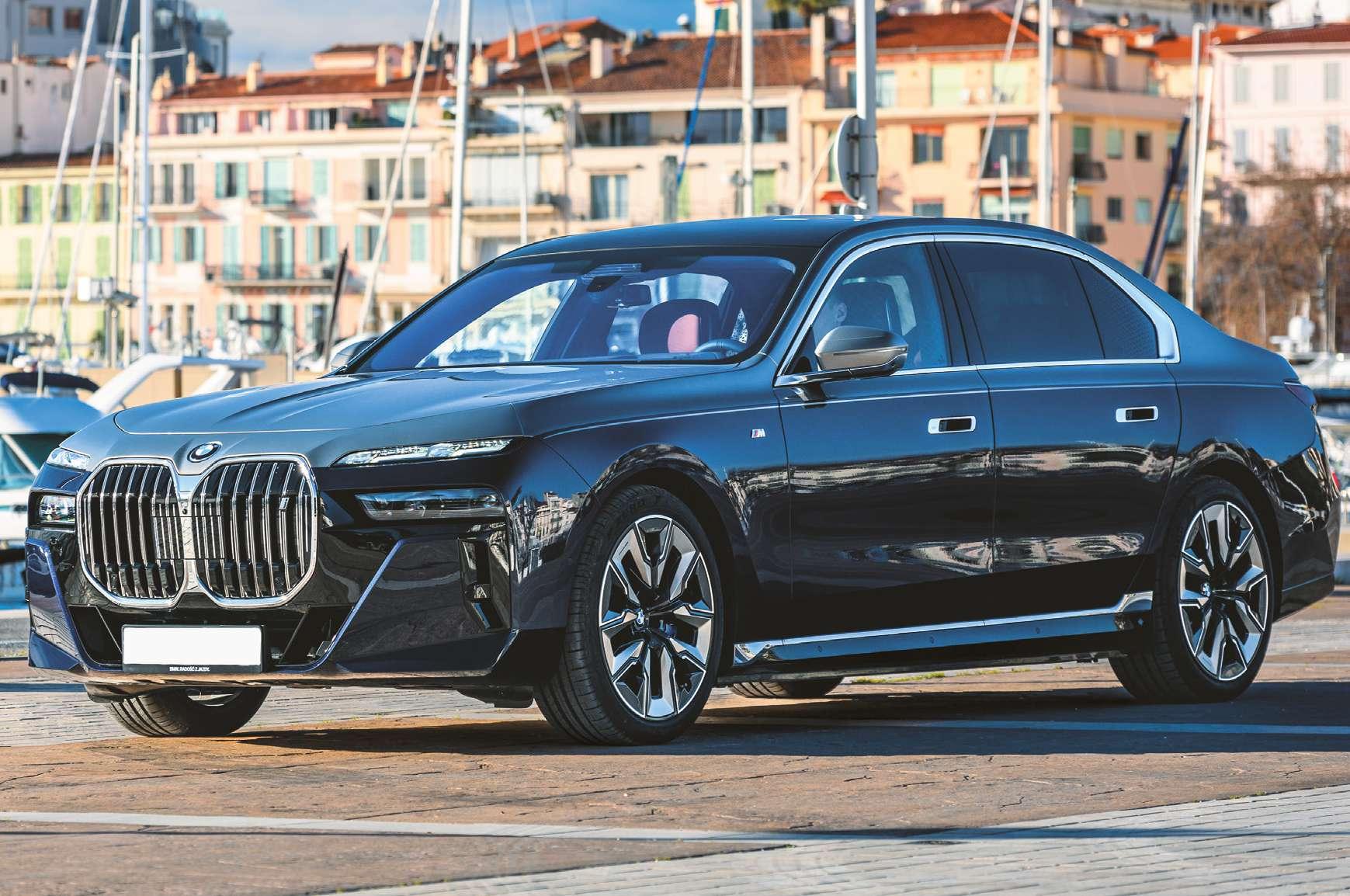
A luxury at Gremi Boneters, 47 | Polígon Son Castelló 07009 Palma, Mallorca | Baleares | España (Spain) Tel/Ph +34 971 430 443 | info@amarques.net

your fingertips
ARQUINESIA PERFUMES
THE PERFUME OF MINORCA’S HIDDEN BEAUTY SPOTS
The aroma of the sea, the perfume of oranges or the essence of figs are part of Balearic olfactory memory. These smells rooted in our nature, emerging from an unmistakably Mediterranean environment. This Balearic perfume comes from Arquinesia, a project founded after numerous trips to the Mediterranean and a deep love for this archipelago.
The moments, landscapes and atmospheres experienced during these trips to the islands resulted in a collection of unique fragrances that, transport you straight back there. Each Arquinesia fragrance has its own story, and has the power to make you experience, feel, and travel. As you enter the beautiful shop, away from everyday noise but still in downtown Palma, you take in a charming atmosphere harmonized by each of the brand’s fragrances, telling the story of the island’s natural history:
The waves of Sea Breeze, eucalyptus, bergamot and ozone tones, take us to Secret Garden, a haven of lush floral splendour smelling currants, grapefruit, rose and jasmine. The fruit of the earth reminds us of the unstoppable changing of the seasons, from soft winter to the regrowth in spring, from the sweetness of summer to cozy autumn, through Fig’s base chord of sandalwood and fig tree wood.
Scent of history is expressed in Orient, an ode to the senses, magnificent, stately, different and recognizable via its exquisite combination of cardamom, patchouli, cedar and amber. Cardamom is calm, fine and romantic, while Silencio is made up of thyme, geranium, cyperus and fir. The unmistakable and refreshing aroma of the orange blossom comes from Serra de Tramuntana, Majorca’s beating heart, reminding us of sunny days in any of the island’s natural spaces.
The places we love, our memories, the events that have had an impact and the scenarios that we have encountered for the first time all have an aroma. An aroma full of emotions, which are sometimes difficult to describe, but always unforgettable. Arquinesia can bottle it, perfuming our bodies and homes with infinite emotions.
www.arquinesia.com
82 STYLE


83


84
ARQUINESIA PERFUMES
EL PERFUME DE LOS RINCONES DE MALLORCA
El aroma del mar, el perfume de la naranja o la esencia del higo forman parte de la memoria olfativa de las Islas Baleares. Olores arraigados a nuestra naturaleza que se desprenden de un entorno inequívocamente mediterráneo. Este perfume tan balear fue el germen de Arquinesia, un proyecto que nació de numerosos viajes al Mediterráneo y de un profundo amor por este archipiélago, y ahora cabe en un frasco.
Los momentos, los paisajes y las atmósferas vividas en estas incursiones a las islas desembocaron en una colección de fragancias únicas que, sí, transportan a través del sentido olfativo hasta este lugar. Cada fragancia de Arquinesia tiene su propia historia y, gracias a ellas, uno experimenta, siente, viaja. Al entrar en su preciosa tienda -alejada del ruido cotidiano que nos rodea pero a la vez en el corazón de Palma- se respira un ambiente encantador armonizado por las fragancias de la marca, que parecen narrar, una a una, la historia natural de esta tierra:
Las olas de Sea Breeze -con notas de eucalipto, bergamota y ozono- nos transportan hasta Secret garden, un remanso de esplendor floral exuberante que huele a grosella, pomelo, rosa y jazmín; el fruto de la tierra nos recuerda el imparable paso de las estaciones –del suave infierno hasta la maduración de la primavera, del dulzor del verano hasta el acogedor otoño- a través del acorde base de sándalo y madera de higuera de Fig.
Desde Oriente se expresa Scent of history, una oda a los sentidos, magnífica, señorial, diferente y reconocible gracias a una exquisita combinación de cardamomo, pachulí, cedro y ámbar. Calmadas, finas y románticas son las notas de cardamomo, tomillo, geranio, cipriol y abeto que conforman Silencio. Y, por supuesto, desde la Serra de Tramuntana, el pulmón de Mallorca, llega el aroma inconfundible y refrescante del azahar de Orange, que nos recuerda cómo es vivir un día soleado en cualquier paraje natural de esta isla.
Los lugares que amamos, nuestros recuerdos, los acontecimientos que nos han marcado y los escenarios que hemos pisado por primera vez y han dejado huella en nosotros tienen aroma. Un aroma plagado de emociones, a veces difícil de describir, pero imborrable en nuestra memoria. Arquinesia ha sabido condensarlo en un frasco para vestir nuestro cuerpo -y nuestras casas- con emociones infinitas.
ARQUINESIA PERFUMES
DAS PARFÜM DER DÜFTE MALLORCAS
Geruch nach Meer, Duft von Orangen oder Aroma von Feigen gehören zum olfaktorischen Gedächtnis auf den Baleareninseln. Düfte aus unserer Natur und unverkennbar mediterran. Diese so balearischen Düfte waren Ausgangspunkt für Arquinesia, ein Projekt, das auf zahlreichen Reisen ans Mittelmeer und aus tiefster Liebe zu dieser Inselgruppe entstand und nun in Flakons bewahrt ist.
Bei Streifzügen auf den Inseln erlebte Momente, Landschaften und Stimmungen, eingefangen in einer Kollektion einzigartiger Duftnoten, versetzen uns über diesen Duft wieder an genau diese Orte zurück. Jede Duftnote von Arquinesia hat ihre eigene Geschichte und lässt uns erleben, fühlen, reisen. Schon beim Betreten des herrlichen Geschäfts, weit weg vom Alltagslärm und mitten in Palma, schwelgt man in einer betörenden Atmosphäre, abgerundet von den Düften der Marke, die einer nach dem anderen die Geschichte der Natur dieser Gegend zu erzählen scheinen:
Die Wellen von Sea Breeze mit Noten von Eukalyptus, Bergamotte und Ozon, Secret Garden, ein Strauß opulenter Blütenpracht mit dem Duft nach Johannisbeere, Grapefruit, Rose und Jasmin, und Fruto de la Tierra erinnert uns mit einem Grundton Sandel- und Feigenholz an den unweigerlichen Verlauf der Jahreszeiten, vom milden Winter bis zum Blühen des Frühlings und von der süßen Reife des Sommers bis zur herbstlichen Behaglichkeit.
Aus dem Orient kommt Scent of History, eine Ode an die Sinne, grandios, erhaben, anders und unverkennbar dank einer exquisiten Kombination von Kardamom, Patchouli, Zedernholz und Amber. Ausgewogen, fein und romantisch sind die Duftnoten von Kardamom, Thymian, Geranie, Zypresse und Tanne bei Silencio. Und natürlich, aus der Serra de Tramuntana, Mallorcas grüner Lunge, kommt der unverwechselbare, erfrischende Duft der Orangenblüte, der uns an den Genuss eines sonnigen Tages irgendwo in der Landschaft dieser Insel erinnert.
Orte, die wir lieben, unsere Erinnerungen, Ereignisse, die uns prägten, und Plätze, die wir zum ersten Mal betraten und die uns berührten, haben einen Duft. Ein Duft, der Gefühle auslöst, manchmal schwer zu beschreiben, aber unauslöschlich in unserem Gedächtnis. Bei Arquinesia gelingt es, Düfte in einem Flakon einzufangen, die uns selbst und unser Zuhause mit unendlich vielen Gefühlen erfüllen.
www.arquinesia.com
STYLE
85
FUNDACIÓ MIRÓ
THE LEGACY OF A UNIQUE ARTIST
Joan Miró Ferrà (Barcelona, 1893) has lifelong links to Majorca. During his childhood and youth, he travelled frequently to the island to visit his grandmother in Sóller and married Majorcan Pilar Juncosa in 1929. He eventually settled on the island in 1956, until his death in 1983.
The island landscape and light always inspired him. Here he found a haven of peace where he could live and create paintings, sculptures, graphics, drawings, ceramics and tapestries.
The Fundació Pilar i Joan Miró is located in the same place that the artist worked at for almost thirty years. It is now a cultural institution, exhibiting the Catalan artist’s work from an interdisciplinary angle. Located in three essential historical buildings, the Foundation occupies the Sert Workshop (Miró’s first Majorcan studio), Son Boter (a typical Majorcan house) and the Moneo building, designed by Rafael Moneo and inaugurated in 1992.
The Taller Sert studio, designed by the architect and former professor Josep Lluís Sert to allow the artist to work, is a combination of imposing concrete and Mediterranean materials like stone and clay. The workshop now preserves Miró’s creative halo and is home to his oils, watercolors and brushes.
Son Moner is more in-keeping with traditional island architecture. Behind its XVIII century façade are the charcoal strokes that Miró painted on the walls, now a space open to creativity, welcoming artistic creation and graphic editing.
The Moneo building emerged as a response to the need to exhibit Joan Miró’s collection, creating a living space that is now foundation HQ. It now houses exhibitions, a library, an auditorium, offices, a shop and a cafeteria.
Joan Miró’s legacy remains in these three buildings in a museum collection that houses paintings, drawings, annotations, sculptures and almost 2000 graphic pieces. An immense collection that testifies to the legacy of an essential twentieth-century artist who found light, silence and inspiration on this island.
86 ART & DESIGN

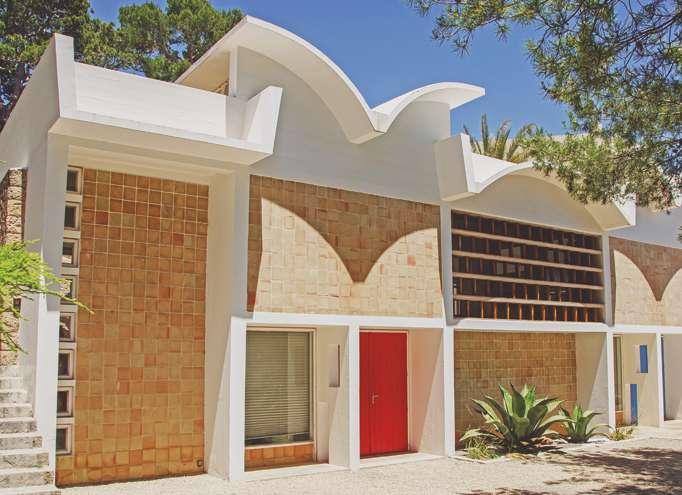
87
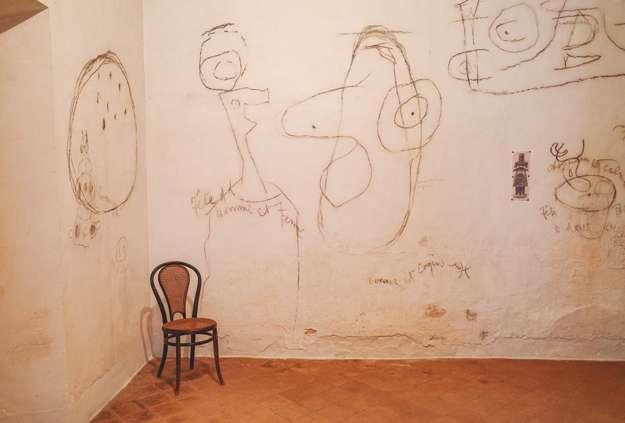
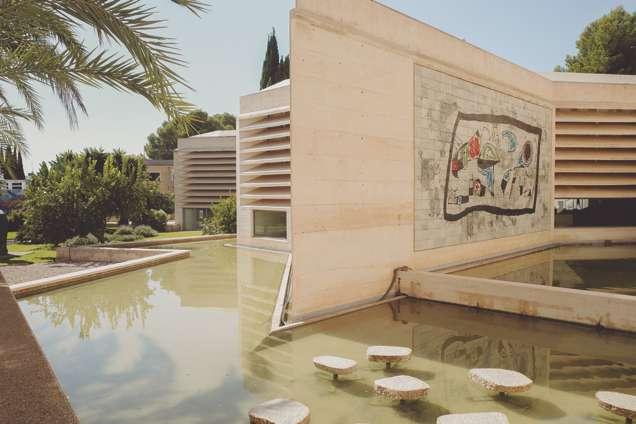
88 TEMATICA
FUNDACIÓ MIRÓ
EL LEGADO DE UN ARTISTA ÚNICO
Joan Miró Ferrà (Barcelona, 1893) estuvo toda su vida vinculado a la isla de Mallorca. Durante su infancia y su juventud viajaba frecuentemente a la mayor de las Baleares para visitar a su abuela en Sóller; en 1929 se casó con la mallorquina Pilar Juncosa y, finalmente, en 1956, se asentó en la isla hasta su muerte, en 1983.
El paisaje isleño y su particular luz fueron siempre fuente de inspiración para el artista que aquí encontró un refugio de paz en el que vivir y crear una vasta obra que abrazó la pintura, la escultura, la obra gráfica, el dibujo, la cerámica y la tapicería.
En el mismo lugar en el que el artista trabajó durante casi treinta años se encuentra hoy la Fundació Pilar i Joan Miró, una institución cultural que acerca al público la obra del artista catalán desde un enfoque interdisciplinar. Ubicada en tres edificios imprescindibles en la historia de la arquitectura de la isla, la Fundació ocupa el Taller Sert -el primer estudio de Miró en Mallorca-, Son Boter -una casa típicamente mallorquina- y el edificio Moneo, diseñado por Rafael Moneo e inaugurado en 1992.
El estudio Taller Sert -diseñado por el arquitecto Josep Lluís Sert ex profeso para que el artista pudiera trabajarcombina una imponente estructura de hormigón con materiales propios del Mediterráneo como la piedra y la argila. Hoy, el taller conserva el halo creativo de Miró y en él conviven sus óleos, acuarelas y pinceles.
Son Moner presenta una apariencia mucho más reconocible en la arquitectura tradicional isleña. Tras su fachada -que data del siglo XVIII- se pueden contemplar los trazos de carboncillo que Miró pintó en las paredes y se ha convertido en un espacio abierto a la creatividad que acoge la creación artística y la edición gráfica.
El edificio Moneo surgió como respuesta a la necesidad de mostrar la colección de Joan Miró y de crear un espacio vivo que se ha acabado convirtiendo en la sede de la fundación. Así, en la actualidad, alberga exposiciones, una biblioteca, un auditorio, oficinas, una tienda y una cafetería a disposición de los visitantes.
El legado de Joan Miró permanece en estos tres edificios en un fondo museográfico que alberga pinturas, dibujos, anotaciones, esculturas y casi 2.000 piezas de obra gráfica. Una colección inmensa que testimonia el legado de un artista imprescindible del siglo XX que encontró, en esta isla, la luz, el silencio, la inspiración.
FUNDACIÓ MIRÓ
ERBE EINES KÜNSTLERS OHNEGLEICHEN
Joan Miró Ferrà (Barcelona, 1893) war zeit seines Lebens
mit Mallorca verbunden. In Kindheit und Jugend reiste er regelmäßig auf die Insel, um seine Großmutter in Sóller zu besuchen. 1929 heiratete er die Mallorquinerin Pilar Juncosa und schließlich lebte er ab 1956 bis zu seinem Tod 1983 auf der Insel.
Die Landschaft der Insel und ihr ganz besonderes Licht waren für den Künstler stets Quelle der Inspiration. Hier fand er seinen Rückzugsort zum Leben und Arbeiten. Sein immenses Lebenswerk umfasst Malerei, Bildhauerei, Grafiken, Zeichnungen, Keramikarbeiten und Wandteppiche.
Am selben Ort, an dem der Künstler fast dreißig Jahr lang arbeitete, befindet sich heute die Stiftung Pilar i Joan Miró, eine Kultureinrichtung, in der das Werk des katalanischen Künstlers mit interdisziplinärem Ansatz der Öffentlichkeit zugänglich ist. In drei für die Architekturgeschichte der Insel bedeutenden Gebäuden befinden sich Taller Sert, das erste Atelier Mirós auf Mallorca, Son Boter, ein typisch mallorquinisches Haus, und das Gebäude Moneo, von Rafael Moneo entworfen und 1992 eingeweiht.
Das Atelier Taller Sert, von dem Architekten Josep Lluís Sert eigens für die Arbeit des Künstlers entworfen, verbindet eine imposante Betonstruktur mit so mediterranen Materialien wie Naturstein und Ton. Noch heute atmet das Atelier mit seinen Ölbildern, Aquarellen und Pinseln die kreative Aura Mirós.
Son Moner ist schon vom Aussehen her unschwer als Teil traditioneller Architektur der Insel zu erkennen. Hinter der Fassade aus dem 18. Jahrhundert sind an den Wänden noch die von Miró mit Kohle gemalten Striche zu sehen. Ein die Kreativität beflügelnder Raum, wie geschaffen für künstlerisches Schaffen und grafisches Gestalten.
Das Gebäude Moneo entstand als Ausstellungsraum für die Sammlung von Joan Miró und ist Raum für Begegnung und Sitz der Stiftung. So beherbergt es heute Ausstellungen, eine Bibliothek, ein Auditorium, Büros, ein Geschäft und ein Café für Besucher.
Nachlass und Vermächtnis von Joan Miró bleiben in diesen drei Gebäuden als Museumssammlung bewahrt, Gemälde, Zeichnungen, Aufzeichnungen, Skulpturen und fast 2000 grafische Arbeiten. Eine immense Sammlung, das Vermächtnis eines Maßstäbe setzenden Künstlers des 20. Jahrhunderts, der auf dieser Insel Licht, Stille und Inspiration fand.
89 ART & DESIGN
72 HOURS IN MAJORCA IN WINTER
MANY REASONS TO VISIT THE ISLAND
M
ajorca: much more than just sun and sand. It also has culture, tradition, landscape and gastronomy. From north to south and from east to west, the largest Balearic Island offers endless winter plans, to discover in just 72 hours.
M
allorca es mucho más que sol y playa. Es cultura, tradición, paisaje, gastronomía. De norte a sur y de este a oeste, la mayor de las Islas Baleares ofrece un sinfín de planes por descubrir, en 72 horas, también en invierno.
Viel
mehr als nur Sonne und Strand. Mallorca ist Kultur, Tradition, Landschaft, Gastronomie. Von Nord nach Süd, von Ost nach West, auf der größten Baleareninsel gibt es unendlich viel zu entdecken, in 72 Stunden und selbst im Winter.
90 ESCAPE
 Photo: Llubí
Photo: Llubí

DAY 1 / DIA 1 / TAG 1
We suggest starting the first day with wine tasting. Thanks to its strong wine tradition, tasting local wines in a winery is a great way to kick off a winter trip to the island. That’s why we suggest visiting Majorca’s oldest winery, Bodegas Ribas, in Consell. This extraordinary building has managed to adapt architecturally to its surroundings and to the old winery, at the foot of the Serra de Tramuntana. Here they make excellent wines, combining respect for tradition with innovation.
Another essential historical winery is located in Santa Maria: Founded in 1880, Jaume de Puntiró produces an extensive range of natural and organic wines following traditional techniques. Get closer to the island’s wine culture with a guided tour of its vineyards and a tasting session in the Plaça Nova winery, which retains the features of a former winery.
El primer día, te proponemos empezar con una cata de vinos. Gracias a su fuerte tradición vinícola, acercarse a una bodega de la isla para saborear los vinos locales es un plan estupendo para inaugurar una escapada invernal a la isla. Por eso, te proponemos una visita a Bodegas Ribas, ubicada en Consell, considerada la más antigua de Mallorca. En un extraordinario edificio que ha sabido adaptarse arquitectónicamente a su entorno y a la antigua bodega, donde elaboran vinos excelsos que complementan el respeto por las tradiciones con la innovación.
Otra bodega imprescindible -con mucha historia- se encuentra en Santa Maria: Jaume de Puntiró, fundada en 1880, produce una extensa gama de vinos naturales y ecológicos siguiendo técnicas artesanales. Un recorrido guiado por sus viñas y una cata en su celler de la Plaça Nova -que conserva la estética de los cellers de toda la vida- es una forma ideal de acercarse a la cultura del vino de la isla.
Für den ersten Tag schlagen wir eine Weinprobe vor. Traditionsreicher Weinbau macht den Besuch eines Weinguts mit Verkostung hiesiger Weine zum vorzüglichen Plan für Ihre winterliche Auszeit auf der Insel. Unser Vorschlag dazu, das wohl älteste Weingut Mallorcas, Bodegas Ribas in Consell. Am Fuße der Serra de Tramuntana, in einem ungewöhnlichen, architektonisch perfekt an Umgebung und die alte Weinkellerei angepassten Bauwerk, entstehen erlesene Weine, Liebe zur Tradition verbunden mit Innovation.
Geschichtsträchtig ist auch das Weingut in Santa Maria Jaume de Puntiró, 1880 gegründet, mit großer Auswahl an Natur- und Bio-Weinen, hergestellt in handwerklichen Verfahren.
Ein Rundgang in Begleitung über Weinberge und die Verkostung im Weinkeller am Plaça Nova mit urigem Ambiente altehrwürdiger Cellers ist die beste Art, Weinkultur der Insel zu erleben.
92 ESCAPE
Photo: Bodegas Ribas

ESCAPE
The second day in Palma is full of art and culture options. More and more contemporary art galleries have popped up (Pelaires, Gallery Red, Kewenig) as well as must-see museums like the Fundació Pilar i Joan Miró, the Majorca Museum (which houses pieces dating from prehistoric times to the nineteenth century) and Es Baluard. This modern and contemporary art museum houses a collection of works by Anglada-Camarasa, Joan Miró, Picasso, Joaquín Sorolla, Rebecca Horn, Bernardi Roig, Jaume Plensa and Miquel Barceló, and other outstanding artists. From its terrace, you can admire the views of Palma Bay and have lunch in the new restaurant, scheduled to open in Spring 2024.
El segundo día viene repleto de arte y es que Palma ofrece muchas opciones para los amantes de la cultura. Cada vez son más las galerías de arte contemporáneo que habitan la ciudad -Pelaires, Gallery Red, Kewenigademás de museos imprescindibles como la Fundació Pilar i Joan Miró, el Museu de Mallorca -que alberga piezas de épocas prehistóricas hasta el siglo XIX- y, por supuesto, Es Baluard. Este museo, dedicado al arte moderno y contemporáneo, cuenta con una colección formada por obras de Anglada-Camarasa, Joan Miró, Picasso, Joaquín Sorolla, Rebecca Horn, Bernardi Roig, Jaume Plensa y Miquel Barceló, entre otros artistas destacados. Además, desde su terraza, podrás admirar las vistas a la bahía de Palma y comer algo en su nuevo restaurante, cuya apertura está prevista para la primavera de 2024.
Den zweiten Tag widmen wir der Kunst, denn für Kunstbegeisterte gibt es in Palma Angebote in Hülle und Fülle. Immer mehr Galerien zeitgenössischer Kunst wie Pelaires, Gallery Red und Kewenig und dazu bedeutende Museen wie Fundació Pilar i Joan Miró, Museu de Mallorca mit Ausstellungsstücken aus der Frühgeschichte bis ins 19. Jahrhundert und natürlich Es Baluard.
Zu sehen sind im Museum für moderne, zeitgenössische Kunst Werke von Anglada-Camarasa, Joan Miró, Picasso, Joaquín Sorolla, Rebecca Horn, Bernardi Roig, Jaume Plensa und Miquel Barceló, neben anderen namhaften Künstlern. Außerdem ist die Terrasse ideal zum Bewundern des Ausblicks auf die Bucht von Palma und für eine kleine Mahlzeit zwischendurch im neuen Restaurant, dessen Eröffnung für Frühling 2024 geplant ist.
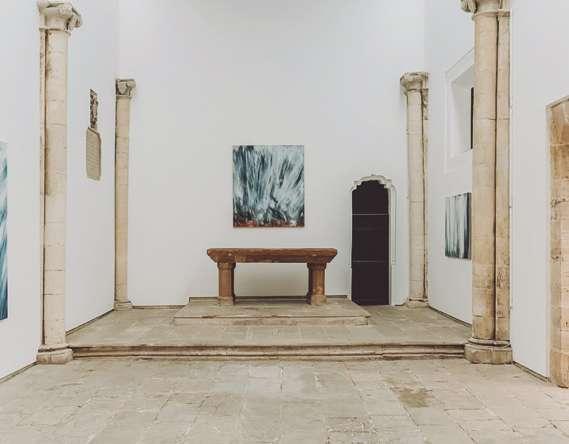
94
DAY 2 / DIA 2 / TAG 2
Photo: Kewenig
ESCAPE
DAY 3 / DIA 3 / TAG 3
On the third and final day, we suggest a tour through the ‘other’ Majorca. Majorca with no coastline, but plenty of charm. Llubí, Petra, Porreres and Vilafranca de Bonany are some of the towns in the Pla region. Visit them to discover the island’s traditions. In Llubí there is an annual honey fayre, while in Algaida you can visit the Gordiola glass factory. Take in the old mills as you travel between towns, now part of the island’s agricultural landscape.
Para el tercer y último día, te proponemos una ruta por la otra Mallorca. La que no tiene costa, pero sí mucho encanto. Llubí, Petra, Porreres y Vilafranca de Bonany son algunos de los pueblos que conforman la comarca del Pla y acercarse a ellos es aproximarse a las tradiciones de la isla. En Llubí, por ejemplo, cada año se celebra una feria dedicada a la miel, en Algaida podemos visitar la fábrica de vidrio Gordiola y en la ruta, de pueblo en pueblo, te sorprenderán los molinos de antaño que forman parte del paisaje agrícola de la isla.
Das andere Mallorca steht am dritten und letzten Tag auf unserem Plan. Wo es zwar keine Küste gibt, aber dafür ganz besonders Reizvolles. Llubí, Petra, Porreres und Vilafranca de Bonany sind einige der Dörfer der Region
Es Pla und ihr Besuch ist eine Annäherung an die Traditionen der Insel. In Llubí findet jedes Jahr eine HonigMesse statt, in Algaida gibt es die Glasfabrik Gordiola zu besichtigen und auf dem Weg, von Dorf zu Dorf, bieten sich überraschende Blicke auf uralte Mühlen, die zum bäuerlichen Landschaftsbild der Insel gehören.
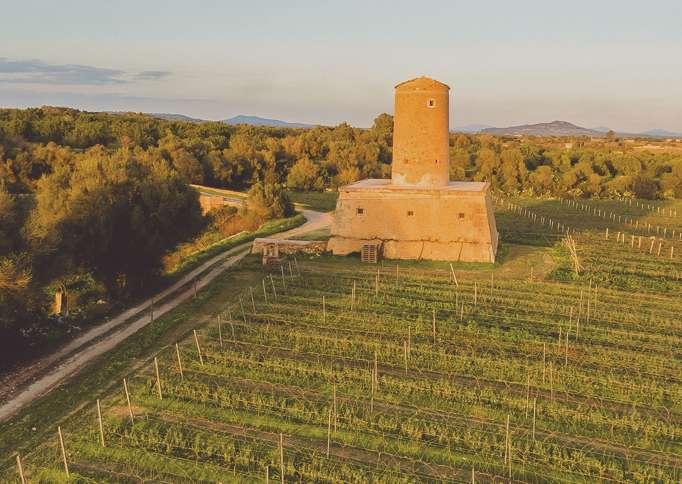
95
Photo: Moli des Porques, Porreres

Before you go, head back Palma, for the sweetest plan of your trip. Founded in 1700, Can Joan de s’Aigo is one of the island’s historic chocolate shops and a comforting stop on a cold winter afternoon. In its Can Sanç store, Baró de Santa Maria del Sepulcre and Porta de Sant Antoni serve the best hot chocolate on the island, perfect with a traditional coca de quarto. We can’t think of a better way to end a trip. A good taste in your mouth, until you come back.
Antes de despedirnos, de vuelta a Palma, el plan más dulce redondea la escapada. Fundado en 1700, Can Joan de s’Aigo es una de las chocolaterías históricas de la isla y parada reconfortante en una tarde fría de invierno. En sus locales de las calles Can Sanç, Baró de Santa Maria del Sepulcre y Porta de Sant Antoni sirven el mejor chocolate caliente de la isla, que podrás acompañar con la tradicional coca de quarto o sus famosas ensaïmadas indiduales. No se nos ocurre mejor forma para terminar esta escapada con buen sabor de boca - hasta que decidas volver.
Als letztes i-Tüpfelchen, wieder zurück in Palma, der süßeste Plan unserer Auszeit. Can Joan de s’Aigo, 1700 gegründet, ist einer der geschichtsträchtigsten Chocolatiers der Insel und ein behaglicher Ort an einem kalten Winternachmittag. In den Cafés in Can Sanç, Baró de Santa Maria del Sepulcre und Porta de Sant Antoni wird die beste heiße Schokolade der Insel serviert. Am besten dazu schmeckt ein Stück traditioneller Coca de Quarto. Uns fällt keine bessere Art ein, Ihnen mit diesem Ende der Auszeit den Mund wässrig zu machen, so sehr, dass Sie beschließen wiederzukommen.
96 ESCAPE
Photo: Cocas de patata, Valldemossa

Some
“Here, you can fly the way you like. No matter whether you fancy champagne or crave rye bread. No matter whether it’s family time or time to catch up with old friends. No matter whether you want to chit-chat with the crew or enjoy the silence. We’re here to help – ready to fly you wherever you like. Whenever you like.”
Kristoffer Sundberg CEO at JoinJet


us
fancy champagne. Others crave rye bread. Fly the way you like with
www.joinjet.com
KEWENIG GALLERY
DIALOGUES BETWEEN DIFFERENT GENERATIONS AND CULTURES
Kewenig aims to accompany, support and promote modern and contemporary artists’ careers with this gallery which dates back to 1986, when its first space opened its doors under the name Jule Kewenig Galerie, with an exhibition by German artist Hendrik Krawen.
At the time, the gallery was located in Frechen, near Cologne, when the city’s art scene was rather extraordinary. The gallery was full of exhibitions by young local and established artists from the Arte Povera movement.
At the beginning of the 2000s, the gallery entered a new chapter, moving to downtown Cologne and in 2004, Kewenig came to Majorca to open his first international gallery, carefully managed by Jule Kewenig. The gallery occupies the Sant Feliu oratory in the heart of Palma, which dates back to the XIII century. It opened with an exhibition by Markus Lüpertz and has since displayed the work of artists from the gallery’s program without losing sight of the vibrant local art scene.
Since settling in Majorca, the gallery has brought the work of contemporary artists such as Portuguese Pedro Cabrita Reis, French Christian Boltanski, Swiss Liliane Tomasko, Chilean creator Sandra Vásquez de la Horra and Majorcan Bernardi Roig, among other current artistic talents, to the island.
After more than 25 years in the Rhineland, Kewenig moved its HQ from Cologne to Berlin and an exhibition by Christian Boltanski in 2013 inaugurated this new space, located in a 1688 building, managed by Justus F. Kewenig after the death of his father, Michael O. Kewenig, in 2017. An electrical substation built in 1901 by the celebrated architect Franz Schwechten has become the gallery’s warehouse and exhibition hall for large-scale installations.
A must-see for contemporary art fans. Until March 15, 2024, the Kewenig headquarters in Palma will show Arzente, an exhibition of paintings on canvas and paper by the artist Raimund Girke, in which the brushstrokes (white, rough and free) extend across the canvas. This is the first time these pieces have been displayed on the island, after two individual exhibitions in Berlin.
kewenig.com
98 ART & DESIGN


99
Photo: Bruno Daureo
Photo: Bruno Daureo

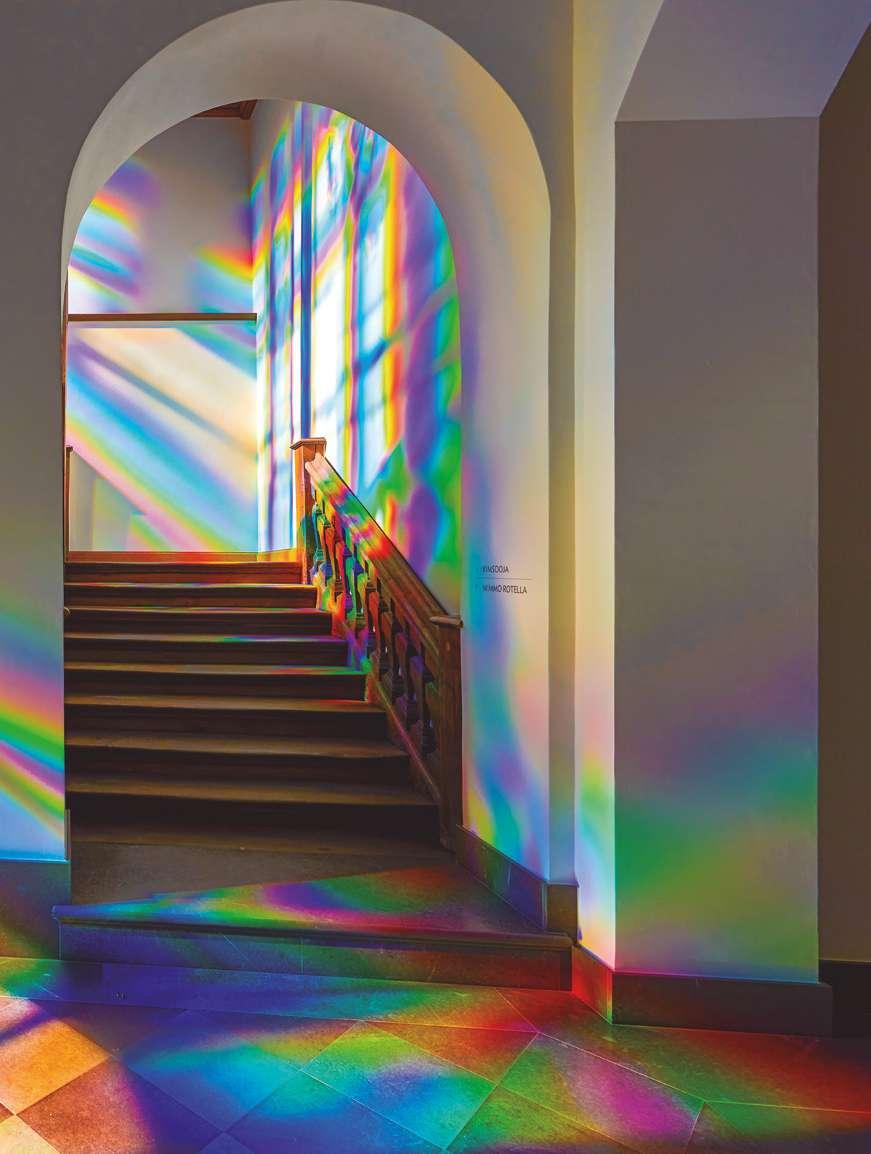 Photo: Bruno Daureo
Photo: Bruno Daureo
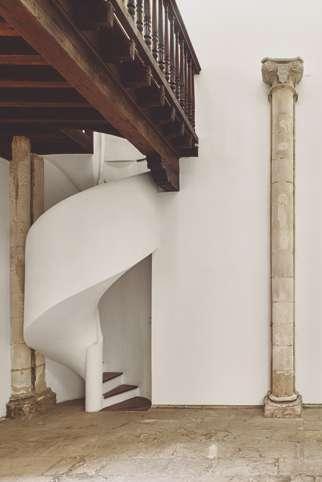
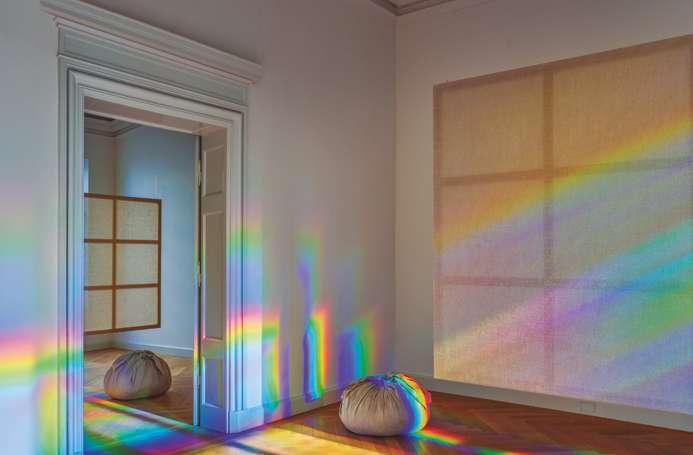
102
Photo: Bruno Daureo
Photo: Bruno Daureo
GALERÍA KEWENIG
DIÁLOGOS ENTRE DIFERENTES GENERACIONES Y CULTURAS
Acompañar, apoyar y promover las carreras de artistas modernos y contemporáneos es el propósito Kewenig, una galería cuya historia se remonta a 1986, cuando su primer espacio -que abrió sus puertas con el nombre de Jule Kewenig Galerie- inauguró su primera muestra, una exposición del artista alemán Hendrik Krawen.
Por entonces, la galería se encontraba en Frechen, cerca de Colonia, en una década en la que la escena artística de la ciudad experimentaba un extraordinario momento, que nutrió la galería con exposiciones de jóvenes artistas locales y nombres consagrados procedentes del movimiento Arte Povera.
A comienzos de los 2000 empezó una nueva etapa para la galería, que se trasladó hasta el centro de Colonia y en 2004, Kewenig aterrizó en Mallorca donde abrió su primer espacio internacional bajo la cuidada dirección de Jule Kewenig. La galería, que ocupa el oratorio de Sant Feliu, un edificio que data del siglo XIII en el corazón de Palma, se presentó en la isla con una exposición de Markus Lüpertz y desde entonces ha congregado la obra de artistas del programa de la galería sin perder de vista el vibrante panorama artístico local.
Desde que se instaló en Mallorca, la galería ha acercado hasta la isla la obra de artistas contemporáneos como el portugués Pedro Cabrita Reis, el francés Christian Boltanski, la suiza Liliane Tomasko, la creadora chilena Sandra Vásquez de la Horra y el mallorquín Bernardi Roig, entre otros talentos artísticos actuales.
Tras más de 25 años en Renania, Kewenig trasladó su sede desde Colonia hasta Berlín y en 2013 una exposición de Christian Boltanski inauguró el nuevo espacio en la capital alemana, ubicado en un edificio de 1688 y liderado por Justus F. Kewenig tras el fallecimiento de su padre, Michael O. Kewenig, en 2017. Además, una subestación eléctrica construida en 1901 por el célebre arquitecto Franz Schwechten se ha convertido en el almacén y sala de exposiciones de la galería para instalaciones a gran escala.
Parada obligatoria para los amantes del arte contemporáneo, en la actualidad y hasta el 15 de marzo de 2024, la sede de Kewenig en Palma alberga Arzente, una exposición que reúne, por primera vez en la isla y tras dos muestras individuales en Berlín, las pinturas sobre lienzo y papel del artista Raimund Girke, en las que las pinceladas -blancas, ásperas y libres- se extienden por el lienzo.
GALERIE KEWENIG
DIALOGE ZWISCHEN GENERATIONEN UND KULTUREN
Begleiten, Unterstützen und Fördern moderner, zeitgenössischer Künstler auf ihrem Weg ist das erklärte Ziel bei Kewenig, einer Galerie, deren Geschichte bis ins Jahr 1986 zurückreicht, als man die ersten Räumlichkeiten unter dem Namen Jule Kewenig Galerie mit einer Ausstellung des deutschen Künstlers Hendrik Krawen eröffnete.
Der damaligen Galerie in Frechen, in der Nähe Kölns, war ein besonderer Moment in einem Jahrzehnt des Aufschwungs der Künstlerszene der Stadt beschieden, den man für Ausstellungen junger hiesiger Künstler und etablierter Namen der Bewegung Arte Povera nutzte.
Zu Beginn der 2000er Jahre begann für die Galerie mit dem Umzug in die Kölner Innenstadt eine neue Etappe und 2004 eröffnete Kewenig auf Mallorca unter der engagierten Leitung von Jule Kewenig ihre ersten internationalen Räumlichkeiten. Die Galerie im Oratorí de Sant Feliu, einem Gebäude aus dem 13. Jahrhundert mitten in Palma, stellte sich erstmals der Öffentlichkeit auf der Insel mit einer Ausstellung von Markus Lüpertz vor und präsentiert seitdem das Werk von Künstlern des Galerie-Programms, ohne dabei die spannende hiesige Kunstszene aus dem Auge zu lassen.
Seit der Eröffnung auf Mallorca waren in der Galerie neben anderen zeitgenössischen Künstlern die Werke des Portugiesen Pedro Cabrita Reis, des Franzosen Christian Boltanski, der Schweizerin Liliane Tomasko, der chilenischen Künstlerin Sandra Vásquez de la Horra und des Mallorquiners Bernardi Roig zu sehen.
Nach über 25 Jahren im Rheinland zog Kewenig von Köln nach Berlin und eröffnete 2013 mit einer Ausstellung von Christian Boltanski neue Räumlichkeiten in der deutschen Hauptstadt in einem Haus aus dem Jahr 1688 und unter Leitung von Justus F. Kewenig nach dem Tod seines Vaters, Michael O. Kewenig, im Jahr 2017. Zusätzlich wurde ein 1901 von dem renommierten Architekten Franz Schwechten entworfenes Umspannwerk zu einem Lager- und Ausstellungsraum für großformatige Installationen umgestaltet.
Ein Muss für alle Begeisterten zeitgenössischer Kunst ist die aktuelle, noch bis zum 15. März 2024 laufende Ausstellung Arzente bei Kewenig in Palma. Die Ausstellung bringt zum ersten Mal auf der Insel und nach zwei Einzelausstellungen in Berlin die Gemälde auf Leinwand und Papier des Künstlers Raimund Girke zusammen, Pinselstriche, weiß, kraftvoll rau und frei.
kewenig.com
ART & DESIGN
103
ES VERGER
MUCH MORE THAN A RESTAURANT
Lime walls, wooden beams and shared tables form Es Verger’s unique and essentially rustic appearance. Free from pretensions in both the dining area and the kitchen. Arròs brut, Majorcan soups, snails and its renowned exquisite shoulder of lamb are part of their infallible menu. Nobody gets tired of the culinary proposals from a Majorcan recipe book.
The restaurant’s history began in 1965 when the Crespí Muntaner family began working on the farm. However, neither the carobs, the olives nor the pigs produced enough to live on. Faced with this situation, they set up barracks in Es Pla des Pouet that would be the site of the current restaurant, now run by the third and fourth generation of the family.
One of the most famous excursions on the island starts at the gates of Es Verger, suitable for families and all types of hikers: the climb to Castell de Alaró. The route can be extended if you carry on to the town center.
The pleasant walk surrounded by vegetation takes around 70 minutes, starting from the Es Verger houses to the top of Puig d’Alaró. The castle stands 822 meters up, a fortress dating back to year 902 according to the Arabic chronicle ‘Kitab Tarih Mayurqa’, formerly used for defensive purposes.
Formed of five towers and classified as an Asset of Cultural Interest, legend has it that the round mark seen at the entrance of the gate is the footprint of Jaume I’s horse and that the reddish color of the cliffs, seen at sunset, was made by blood shed in battle.
As well as the castle, the historical richness of the landscape is completed by XIV century castle ruins, several coal and lime kilns, the Mare de Déu del Refugi oratory and a hostelry where you can spend the night.
The climb to Castell d’Alaró is a highly recommendable experience, full of history and nature. Finishing your trip sampling Es Verger’s cuisine, discovering the island’s gastronomical roots. A perfect plan.
+34 971 18 21 26
104 GASTRO

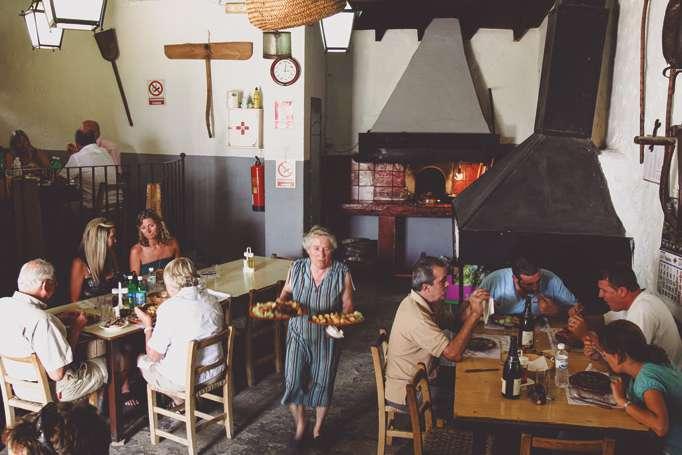
105


106
Photo: We Are yellow
ES VERGER
MUCHO MÁS QUE UN RESTAURANTE
Paredes de cal, vigas de madera en el techo y mesas para compartir con otros comensales conforman el aspecto único y esencialmente rústico del restaurante Es Verger. Un lugar que no entiende de pretensiones, ni en su espacio ni en su cocina. Arròs brut, sopas mallorquinas, caracoles y su exquisita y famosísima paletilla de cordero son su infalible oferta gastronómica. Propuestas culinarias del recetario mallorquín que jamás pasarán de moda.
La historia del restaurante empezó a escribirse en 1965 cuando la familia Crespí Muntaner comenzó a trabajar en la finca. Sin embargo, ni las algarrobas, ni la aceituna ni los cerdos daban lo suficiente para vivir. Ante esta situación, dos años después, montaron una barraca en Es Pla des Pouet que sería el germen del actual restaurante, ahora regentado por la tercera y la cuarta generación de la familia.
Precisamente a las puertas de Es Verger comienza una de las excursiones más famosas de la isla, apta para familias y todo tipo de excursionistas: la subida al Castell de Alaró -aunque el recorrido puede alargarse si se fija la salida en el núcleo urbano del municipio-.
El trayecto, desde las casas de Es Verger, es un paseo agradable rodeado de vegetación de unos setenta minutos hasta alcanzar la cima del Puig d’Alaró. Allí, a 822 metros de altura, se encuentra el castillo, una fortificación cuya historia se remonta al año 902 según la crónica árable ‘Kitab Tarih Mayurqa’, que atestigua su existencia con fines defensivos.
Formado por cinco torres y catalogado como Bien de Interés Cultural, cuenta la leyenda que la marca redonda que se ve en la entrada del portón es la huella de la pisada del caballo de Jaume I y que el color rojizo de los acantilados, que se observa sobre todo al atardecer, es la marca de la sangre derramada durante la batalla de la conquista.
Además del castillo, la riqueza histórica del paisaje la completan las ruinas de las murallas del siglo XIV, varias carboneras y hornos de cal, el oratorio de la Mare de Déu del Refugi y una hospedería en la que se puede pernoctar.
Sin duda, la subida al Castell d’Alaró es una excursión plagada de historia y naturaleza que merece la pena disfrutar. Terminarla degustando la cocina de Es Verger es un viaje a las raíces gastronómicas de la isla. El plan perfecto.
ES VERGER
VIEL MEHR ALS NUR EIN RESTAURANT
Gekalkte Wände, Holzbalken an der Decke und Tische, die man sich mit anderen Gästen teilt, geben dem Restaurant Es Verger dieses so einzigartig besondere Flair. Ein Ort, an dem nichts Anmaßung ist, weder im Raum noch in der Küche. Arròs brut, Schnecken und die weithin berühmte, exquisite Lammschulter bilden das unfehlbare gastronomische Angebot. Kulinarische Angebote aus dem mallorquinischen Kochbuch, die nie aus der Mode kommen.
Die Geschichte des Restaurants begann 1965, als die Familie Crespí Muntaner begann, auf dem Landgut zu arbeiten. Allerdings brachten weder Johannisbrotbäume noch Oliven oder Schweine genug zum Leben ein. Angesichts dieser Situation erbauten sie zwei Jahre später eine Baracke in Es Pla des Pouet, aus dem das heutige, jetzt in dritter und vierter Familiengeneration geführte Restaurant hervorging.
Genau vor den Toren von Es Verger ist Startpunkt für einen der berühmtesten Ausflüge auf der Insel, für Familien und Ausflügler aller Art geeignet, der Aufstieg zum Castell de Alaró. Man kann den Weg auch verlängern, wenn man im Ortskern losgeht.
Der Weg von Es Verger aus ist ein angenehmer Spaziergang von ca. siebzig Minuten durch üppige Pflanzenwelt bis zum Gipfel des Puig d’Alaró. Hier, auf einer Höhe von 822 Metern, steht das Castell, eine zum Zweck der Verteidigung angelegte Festung aus dem Jahr 902, wie die arabische Chronik ‘Kitab Tarih Mayurqa’bezeugt.
Über die Festung mit fünf Türmen, als Kulturgut katalogisiert, besagt die Legende, dass der runde Abdruck am Toreingang der Hufabdruck des Pferdes von Jaume I. sei und dass die rötliche Färbung der Felsen, besonders gut in der Abenddämmerung zu sehen, vom Blut, das während der Schlacht zur Eroberung der Stadt vergossen wurde, herrühre.
Zum geschichtsträchtigen Reichtum zählen neben dem Castell auch die Ruinen der Mauern aus dem 14. Jahrhundert, mehrere Köhlerhütten und Kalköfen, das Oratorió de la Mare de Déu und eine Herberge zum Übernachten.
Der Aufstieg zum Castell d’Alaró ist ohne jeden Zweifel ein wirklich lohnender Ausflug in die Natur und in die Geschichte. Und der Hochgenuss der Gerichte im Es Verger ist eine Reise zu kulinarischen Ursprüngen der Insel.
+34 971 18 21 26
107 GASTRO
CAN PEP REY
WHEN FASHION IS MORE THAN JUST CLOTHING
The Mediterranean sun, light, nature and scent of Ibiza inspire independent fashion house Can Pep Rey’s clean, exclusive and unisex silhouettes, founded in 2014 by Lea Russ and Paul Conradi. They got the name from the Santa Gertrudis estate where the product comes from, and opened a shop, gallery and venue to host the brand’s events.
Protected by strong principles that advocate collaboration, quality and responsibility, this creative couple are surrounded by designers, colleagues and customers who share their commitment to sustainable fashion, operating between Emily Metzger’s showroom in Barcelona’s Gracia neighbourhood and the largest Pityusic Island.
Can Pep Rey have been designing and producing eco-friendly garments for 10 years, promoting clean silhouettes and unique pieces with top quality fabrics from Italy, Spain, Portugal and Japan, convinced that moving towards more conscious fashion is possible. How do they do it? Through pre-orders that minimize stock, recycled materials, eco-friendly fibers, and sustainable packaging. They share this data annually with their fans in their statements.
To contribute towards generating a significant and lasting impact with different social and environmental causes, Can Pep Rey also work tirelessly on their CSR, taking on current local and global fashion and work challenges, and working closely with activists and communities.
This sustainable approach is complemented by creativity, a fundamental pillar. The brand works with artists and stores such as Rose Madone, Object Trouvé or Marlon Wobst, and organizes concerts, exhibitions and workshops in partnership with other creative minds, giving them column inches in their online magazine. To date, renowned personalities such as photographer Hassan Hajjaj, South African art gallery and collective FEDE Arthouse, and chef and gastronomic conceptualist Antonella Tignanelli have all been interviewed.
Essential and timeless, Can Pep Rey garments convey the relaxed and comfortable air lived and breathed in pure Ibiza. Essential and contemporary essentials for everyday life in the Mediterranean, appreciated throughout the world.
www.canpeprey.com
108 STYLE
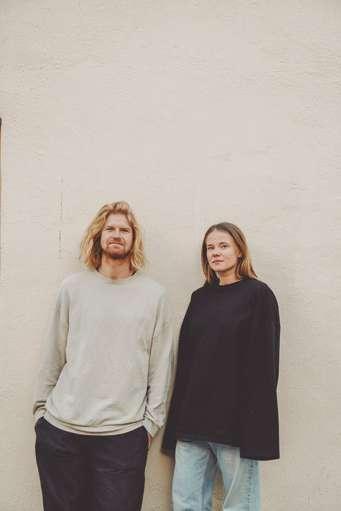

109


110
CAN PEP REY
CUANDO LA MODA ES ALGO MÁS QUE ROPA
El sol del Mediterráneo, la luz, la naturaleza y el aroma de la isla de Ibiza inspiran las siluetas limpias, exclusivas y unisex de Can Pep Rey, una firma de moda independiente fundada en 2014 por Lea Russ y Paul Conradi. De la finca en Santa Gertrudis, el origen del proyecto, tomaron prestado el nombre y desde entonces ésta se ha convertido en tienda, galería y sede de los eventos de la marca.
Amparados por unos principios férreos que abogan por la colaboración, la calidad y la responsabilidad, esta pareja de creativos se rodea de diseñadores, colegas y clientes que, como ellos, se comprometen con una moda más sostenible entre el barrio de Gracia, en Barcelona, donde se encuentra su showroom -diseñado por Emily Metzger- y la mayor de las Pitiusas.
Desde hace una década, Can Pep Rey diseña y produce sus colecciones con la vista puesta en el impacto medioambiental en busca de siluetas limpias y piezas únicas con tejidos de primera calidad, que provienen de Italia, España, Portugal y Japón, convencidos de que el viraje hacia una moda más consciente es posible.
¿Cómo? A través de pedidos anticipados que minimizan el stock, materiales reciclados, fibras ecológicas y envases sostenibles. Datos que, de forma transparente, comparten anualmente en la rendición de cuentas con los amantes de sus prendas.
Además, con el propósito de contribuir a generar un impacto significativo y duradero con diferentes causas sociales y medioambientales, Can Pep Rey trabaja incansablemente en su responsabilidad social corporativa, asumiendo los retos actuales -a escala local y global- tanto en su visión de la moda y el trabajo, como en su estrecha colaboración con activistas y comunidades.
Esta mirada sostenible se alía, en el día a día de la marca, con la creatividad, un pilar fundamental de la firma española que colabora con artistas y tiendas como Rose Madone, Object Trouvé o Marlon Wobst, y organiza conciertos, exposiciones y talleres en una alianza con otros creativos, a quiénes también da voz en su magazine online a través de entrevistas. Hasta la fecha, en sus conversaciones han participado personalidades de renombre como el fotógrafo Hassan Hajjaj, la galería y colectivo de arte sudafricano FEDE Arthouse, y la chef y conceptualista gastronómica Antonella Tignanelli.
Esenciales y atemporales, las prendas de Can Pep Rey transmiten ese aire relajado y confortable que se vive y respira en Ia Ibiza más auténtica. Básicos imprescindibles y contemporáneos para la vida cotidiana en el Mediterráneo que amarás en cualquier parte del mundo.
CAN PEP REY
WENN MODE MEHR ALS NUR KLEIDUNG IST
Mediterrane Sonne, das Licht, Natur und Duft der Insel
Ibiza sind Inspiration für die exklusiven Unisex-Konturen mit gerader Linienführung von Can Pep Rey, einem 2014 von Lea Russ und Paul Conradi gegründeten, unabhängigen Modelabel. Der Name stammt von dem Landgut in Santa Gertrudis, wo das Projekt entstand und jetzt Geschäft, Galerie und Sitz für Events der Marke ist.
Im Viertel Gracia in Barcelona, wo sich ihr von Emily Metzger entworfener Showroom befindet, und auf der größten der Pityusen-Inseln setzt das kreative Paar konsequent auf Prinzipien wie Zusammenarbeit, Qualität und Verantwortungsbewusstsein und hat sich gemeinsam mit Designern, Kollegen und Kunden, die ihre Ansichten teilen, einer nachhaltigeren Mode verschrieben.
Seit einem Jahrzehnt entwirft und fertigt man bei Can Pep Rey Kollektionen mit Augenmerk auf Umweltschutz und immer im Streben nach klaren Konturen und einzigartigen Stücken aus hochwertigen Stoffen aus Italien, Spanien, Portugal und Japan mit der festen Überzeugung, dass eine Wende zu bewussterer Mode möglich ist. Wie? Durch Vorbestellung, um Lagerbestände zu mindern, recycelte Materialien, Bio-Fasern und nachhaltige Verpackung. Die Angaben dazu teilen sie auf transparente Art jährlich mit den Fans ihrer Kleidung.
Mit dem Ziel, maßgeblich und dauerhaft einen Beitrag bei verschiedenen sozialen und ökologischen Belangen zu leisten, arbeitet man bei Can Pep Rey unermüdlich am Verantwortungsbewusstsein als Unternehmen und stellt sich aktuellen Herausforderungen auf regionaler und globaler Ebene, im Hinblick auf ihre Vision von Mode und Arbeit und auch durch enge Zusammenarbeit mit Aktivisten und Gemeinden.
Nachhaltigkeit verbindet sich bei der täglichen Arbeit der Marke mit Kreativität, einem Grundpfeiler des spanischen Unternehmens, bei der Zusammenarbeit mit Künstlern und Geschäften wie Rose Madone, Object Trouvé oder Marlon Wobst. Konzerte, Ausstellungen und Workshops mit anderen Kreativen, die sie auch in ihrem Online-Magazin bei Interviews zu Wort kommen lassen. Bisher gehörten zu den Interviewpartnern so bekannte Persönlichkeiten wie der Fotograf Hassan Hajjaj, das Galerie- und Kunstkollektiv FEDE Arthouse aus Südafrika und Antonella Tignanelli, Chefköchin und Gastro-Konzeptionistin.
Zeitlose Kleidungsstücke von Can Pep Rey, die man einfach haben muss, strahlen diese komfortable Unbekümmertheit aus, wie sie nur auf Ibiza gelebt wird. Zeitgemäße und unverzichtbare Basics für den mediterranen Alltag, die man überall auf der Welt liebt.
www.ccanpeprey.com
111 STYLE

25–28 April 2024
Perfectly timed before the Mediterranean summer season

us
Follow
Palma de Mallorca, Spain
PLAÇA GOMILA
THE RESURGENCE OF A NEIGHBOURHOOD
Plaça Gomila has been the central hub of El Terreno since the XIX century, a neighbourhood where personalities like Gertrude Stein, Jimi Hendrix, Camilo José Cela and Rubén Darío have spent time, attracting artists and bohemians from all over Europe since the 1950s, thanks to its cultural, nocturnal and cosmopolitan vibe. A neighbourhood with its own personality where visitors and lifelong neighbours lived in harmony until a period of degradation began in the 1990s, gradually altering El Terreno.
Plaça Gomila is currently undergoing an unprecedented transformation process to revitalize the neighbourhood through creativity, focusing on innovation, and keeping its neighbours in mind. The Gomila project, an architectural proposal to restore four buildings and build three others with energy efficiency in mind, is managed by the Dutch studio MVRDV and GRAS Reynés Arquitectos and promoted by the Camper group.
The buildings, whose vibrant chromatics pay homage to the neighbourhood’s eclectic spirit, will provide sixty homes with solar panels and cross ventilation, offices, a pool, shared areas, restaurants and shops.
The first phase has already been completed, renovating the Gomila Centre (designed by architect Pere Nicolau who started making his mark in 1979). This also included the renovation of ‘Las Casitas’, a series of sustainable red apartments with a shared roof, the construction of the ‘fabri-casas’, clad in blue ceramic, an apartment building with a communal pool, and the transformation of the green building, offering offices and a terrace overlooking Palma Bay. The next phase includes the renovation of two existing buildings: the yellow Virginia house and a small villa.
The transformation of Plaça Gomila aims to show off the historical neighbourhood at its best. This is where old inhabitants live alongside newcomers, and where lifelong businesses like Meriendas Bestard operate alongside emerging companies like artisanal bakery Contain, run by Esment, and the Brutus restaurant - a contemporary trattoria with a Mediterranean essence. A fresh and exciting project for a place that the writer and painter Santiago Russinyol defined as ‘so delightful, so beautiful, so island’.
www.gras-arquitectos.com
114 ART & DESIGN


115
Photo: Daria Scagliola
Photo: Daria Scagliola

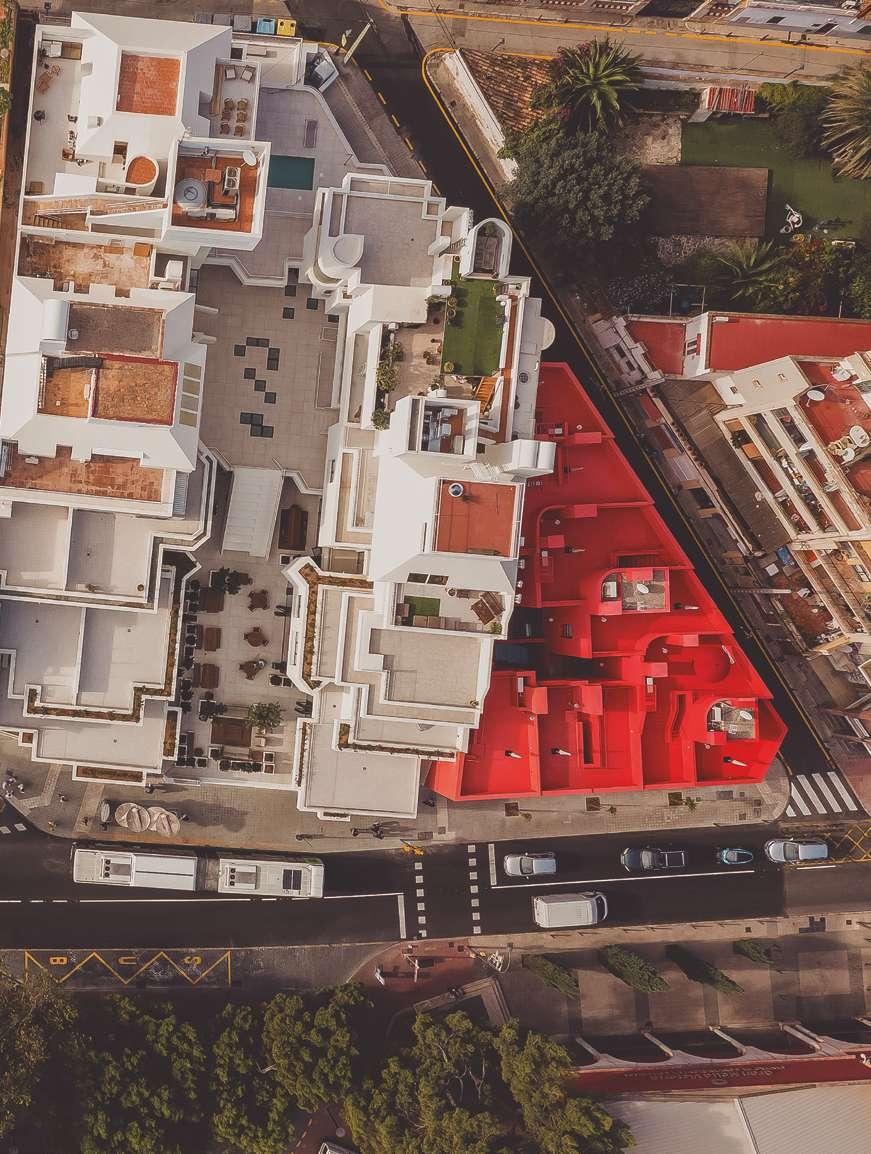 Photo: Daria Scagliola
Photo: Daria Scagliola

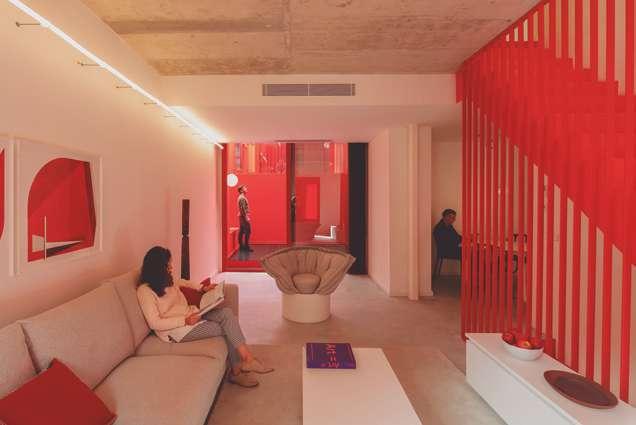
118
Photo: Daria Scagliola
Photo: Daria Scagliola
PLAÇA GOMILA
EL RESURGIR DE UN BARRIO
La plaza Gomila ha sido, desde el siglo XIX, el centro neurálgico de El Terreno, un barrio por el que han pasado personajes como Gertrude Stein, Jimi Hendrix, Camilo José Cela o Rubén Darío y que, a partir de los años cincuenta, atrajo artistas y bohemios de toda Europa gracias a su propuesta cultural, nocturna y cosmopolita. Un barrio con personalidad propia en la que visitantes y vecinos de toda la vida convivían bien hasta que, en la década de los 90, comenzó un período de degradación que cambiaría, paulatinamente, el Terreno.
Ahora, sin embargo, la Plaza Gomila vive un proceso de transformación sin precedentes con el propósito de revitalizar el barrio a través de la creatividad, poniendo el foco en la innovación y sin olvidar a sus vecinos. Es el proyecto Gomila, una propuesta arquitectónica que rehabilita cuatro edificios y construye otros tres bajo los preceptos de la eficiencia energética, y que está siendo capitaneada por el estudio holandés MVRDV y GRAS Reynés Arquitectos e impulsada por el grupo Camper.
Los edificios -cuyo cromatismo vibrante homenajea el espíritu ecléctico del barrio- albergarán sesenta viviendas, con paneles solares y ventilación cruzada, oficinas, una piscina, zonas comunes, restaurantes y comercios.
La primera fase, que ya ha finalizado, se ha ocupado de la renovación del Centro Gomila (un diseño del arquitecto Pere Nicolau de 1979), la reforma de ‘Las Casitas’, una serie de apartamentos sostenibles de color rojo con una azotea común, la construcción de las ‘fabri-casas’, revestidas de cerámica de color azul, un edificio de apartamentos con piscina comunitaria, y la transformación del edificio verde, que albergará oficinas y una terraza con vistas a la bahía de Palma. La siguiente fase incluye la renovación de dos edificaciones ya existentes: la casa Virginia, de color amarillo, y una pequeña villa.
La transformación de la plaza Gomila pretende devolver la mejor cara a un barrio con mucha historia en la que conviven vecinos de siempre con recién llegados, negocios de toda la vida, como Meriendas Bestard, con empresas emergentes, como Contain, una panadería artesanal, la de Esment, con el restaurante Brutus, una trattoria contemporánea con sabor mediterráneo. Un proyecto fresco y emocionante para un lugar que el escritor y pintor Santiago Russinyol definió como ‘un lugar tan delectable, tan bello, tan isla’.
PLAÇA GOMILA
COMEBACK EINES VIERTELS
Plaça Gomila war seit dem 19. Jahrhundert Dreh- und Angelpunkt im El Terreno, einem Viertel, das schon Gertrude Stein, Jimi Hendrix, Camilo José Cela und Rubén Darío sah und das ab den 1950er Jahren mit Kulturangebot, Nachtleben und Weltoffenheit Anziehungspunkt für Künstler und Bohemiens aus ganz Europa war. Ein besonderes Viertel, in dem Besucher und Anwohner bestens miteinander auskamen, bis der in den 1990er Jahren beginnende Niedergang El Terreno immer mehr veränderte.
Jetzt allerdings erlebt Plaça Gomila eine bisher einzigartige Umgestaltung zur Wiederbelebung des Viertels mit Kreativität, Innovation und ohne dabei die Nachbarn des Viertels zu vergessen. Das Projekt Gomila, ein architektonisches Projekt zur Komplettsanierung von vier und zum Neubau drei weiterer Gebäude nach Vorgaben der Energieeffizienz wird vom niederländischen Studio MVRDV und GRAS Reynés Arquitectos geleitet und von der Gruppe Camper gefördert.
In den Gebäuden, deren markante Farbgebung eine Verbeugung vor dem bunt schillernden Flair des Viertels ist, entstehen sechzig Wohnungen mit Solarpaneelen und Querlüftung, Büros, Pool, gemeinschaftlich genutzte Bereiche, Restaurants und Geschäfte.
Die erste, bereits abgeschlossene Phase betraf die Rekonstruktion von Centro Gomila (Design des Architekten Pere Nicolau, 1979), die Modernisierung von ‘Las Casitas’, einige kleine nachhaltige Apartments in roter Farbgebung mit gemeinsamer Dachterrasse, der Neubau der ‘Fabri-Casas’ mit blauer Keramikverkleidung, ein Apartment-Gebäude mit Gemeinschaftspool und die Neugestaltung des grünen Gebäudes mit Büros und Terrasse mit Blick auf die Bucht von Palma. Bei der nächsten Phase steht die Rekonstruktion der beiden schon vorhandenen Gebäude, Casa Virginia im gelben Farbton und einer kleinen Villa, an.
Die Umgestaltung der Plaça Gomila soll dem Viertel mit bewegter Vergangenheit alten Glanz wiedergeben. Wie einst soll es Heimat sein für Alteingesessene und Neuankömmlinge, Unternehmen, die immer schon hier waren wie Meriendas Bestard oder Newcomer wie Contain, eine Handwerksbäckerei unter Leitung von Esment, oder das Restaurant Brutus, eine zeitgemäße Trattoria mit mediterranem Flair. Ein erfrischend anregendes Projekt für einen Ort, über den der Schriftsteller und Maler Santiago Russinyol einst schrieb: ‘ein Ort, so köstlich, so schön, so inselig’.
www.gras-arquitectos.com
119 ART & DESIGN
PEDRA EN SEC
A TRADE LOADED WITH HISTORY
The pedra en sec (dry stone) walls carve the Majorcan landscape from east to west and from north to south. Created in response to an architectural need, they were originally used to prepare the land before it became cultivation terraces, and to prevent erosion. Over the centuries they have become art in itself that margers build stone by stone.
This technique was also used to pave roads, channel water and build barracks to protect mules, cars and even people. In the peculiar case of carboner barracks, small circular buildings and a roof based on trunks and branches, acting as a shelter for field workers if they needed to spend the night there.
The Serra de Tramuntana is home to 18,000 linear km of stone marges. Walls built by fitting stones of different shapes and sizes without using mortar or other construction materials. “The most important thing is to start cleaning the vegetation area and prepare the ground, creating the box. Then select the stones: the smallest on the sides and the largest in the centre. The ends should face inwards, because their fit makes the wall stand upright and keeps it stable. The flatter surface must face outward.”
The technique is explained by Miquel Ángel Sastre, a marger from Alaró who was introduced to the trade aged 19 by a dry-stone construction expert. He now has his own company, Pedra i Camp, and takes on public and private projects using this technique. “The work is hard, but very satisfying. You have to adapt to the weatherthe cold, the wind, the rain and the summer heat - but being in a place like the Serra de Tramuntana, an idyllic setting surrounded by nature, is unbeatable. What’s more, seeing the end result is the greatest reward,” says Miquel Àngel.
To professionally maintain this rural heritage and enhance the craft, and study and promote the importance of stone in the Balearic Islands, the Margers’ Guild was born in 2016. In 2021 they fought to have their craft included in the state catalogue of qualifications. One more step towards ensuring the survival of a historic trade that contributes towards preserving the island’s natural, beautiful and authentic landscape.
Miquel Àngel Sastre - +34 679 61 85 17
120 HERITAGE


121


122
PEDRA EN SEC
UN OFICIO CARGADO DE HISTÓRIA
Los muros de pedra en sec dibujan el paisaje mallorquín de este a oeste y de norte a sur. Nacidos como respuesta a una necesidad arquitectónica -en su origen servían para preparar los terrenos antes de convertirlos en terrazas de cultivo así como para evitar la erosión-, con el paso de los siglos se han convertido en todo un arte que construyen, piedra a piedra, los margers.
Además, esta técnica también era utilizada para pavimentar caminos, canalizar el agua y construir barracas con el propósito de resguardar las mulas, los carros e incluso las personas, en el peculiar caso de las barraques de carboner, pequeñas edificaciones de planta circular y un techo a base de troncos y ramas, que servían de cobijo a los trabajadores del campo si era necesario pernoctar en el lugar.
La Serra de Tramuntana alberga 18.000 km lineales de marges de piedra. Muros construidos a través del encaje de piedras de diferentes formas y tamaños sin utilizar mortero ni otros materiales de construcción. “Lo más importante es empezar limpiando la zona de vegetación y preparar el terreno, creando el cajón. Después, seleccionar las piedras: las más pequeñas en los laterales y las más grandes en el centro. Las colas deben colocarse hacia el interior, porque su encaje es lo que hace que la pared se sostenga y el muro sea estable. La cara más plana queda hacia el exterior”.
Quien explica la técnica es Miquel Ángel Sastre, un marger de Alaró que se introdujo en el oficio a los 19 años de la mano de un maestro de la construcción de pedra en sec. Ahora, con su propia empresa, Pedra i Camp, trabaja en la construcción a través de esta técnica, en obra pública y privada. “El trabajo es arduo, pero muy satisfactorio. Tienes que adaptarte a la climatología -al frío, al viento, a la lluvia y al calor del verano-, pero estar en un lugar como la Serra de Tramuntana, patrimonio de la UNESCO, un entorno idílico rodeado de naturaleza, es incomparable. Además, observar, cuando terminas, el resultado es la mayor recompensa”, afirma Miquel Àngel.
Con el objetivo de mantener de forma profesional este patrimonio rural y poner en valor el oficio, así como estudiar y difundir la importancia de la piedra en las Islas Baleares, en 2016 nació el Gremi de Margers, que luchó en 2021 para que su oficio fuese incluido en el catálogo estatal de calificaciones. Un paso más para asegurar la supervivencia de un oficio histórico que contribuye a conservar el paisaje -natural, bello y genuino- de la isla.
TROCKENSTEINMAUERN
HANDWERK MIT GESCHICHTE
Trockensteinmauern durchziehen Mallorcas Landschaft von Ost nach West und von Nord nach Süd. Aus Notwendigkeit entstanden, einst dienten sie zur Bereitung der Böden für das Anlegen landwirtschaftlich genutzter Terrassen und zum Schutz gegen Bodenerosion, wurden sie im Laufe der Zeit zu einer Art Kunstwerk, das Margers Stein für Stein zusammenfügen.
Diese Technik nutzte man auch zum Pflastern von Wegen, Kanalisieren von Wasser und Errichten kleiner Hütten für Maultiere, Karren und sogar Menschen. Ein Sonderfall sind barraques de carboner, kleine runde Bauwerke mit einem Dach aus Ästen und Zweigen, die Landarbeitern als Unterschlupf bei einer Übernachtung dienten.
In der Serra de Tramuntana gibt es 18.000 km Trockensteinmauern. Mauern aus fest ineinander gefügten Steinen unterschiedlicher Form und Größe ohne Verwendung von Mörtel oder anderen Baumaterialien. “Das Wichtigste am Anfang sind Entfernen der Vegetation, Bereiten des Geländes und Anlegen des Fundaments. Dann werden die Steine ausgesucht: die kleinsten für die Seiten und die größten für die Mitte. Steinspitzen sollten nach innen gelegt werden, denn erst ihr Ineinandergreifen verleiht der Mauer Standfestigkeit und Stabilität. Die flachste Seite sollte immer nach außen zeigen”.
So erklärt die Technik Miquel Ángel Sastre, ein Marger aus Alaró, der im Alter von 19 Jahren von einem pedra en sec-Baumeister das Handwerk erlernte. Heute arbeitet er mit seinem eigenen Unternehmen, Pedra i Camp, nach dieser Technik bei öffentlichen und privaten Bauvorhaben. “Die Arbeit ist hart, aber sehr erfüllend. Das Wetter muss man in Kauf nehmen, Kälte, Wind, Regen und Sommerhitze, aber an einem Ort wie der Serra de Tramuntana zu arbeiten, in herrlicher Umgebung inmitten von Natur ist einfach unvergleichlich. Außerdem ist das Betrachten der fertiggestellten Arbeit die schönste Belohnung”, betont Miquel Àngel.
Im Streben nach fachkundiger Bewahrung dieses ländlichen Erbes, Wertschätzung des Handwerks, Erforschung und Verbreitung der Bedeutung des Steins auf den Balearen wurde 2016 Gremi de Margers gegründet, bei dem man sich dafür einsetzte, dass ihr Handwerk 2021 Aufnahme im Staatlichen Qualifikationskatalog fand. Ein weiterer Schritt, um das Überleben eines althergebrachten Handwerks zu sichern, und ein Beitrag, um das naturnahe, schöne und ursprüngliche Landschaftsbild der Insel zu erhalten.
Miquel Àngel Sastre - +34 679 61 85 17
123 HERITAGE
MARKET GASTRO ROUTE
BUYING AND TASTING LOCAL PRODUCE
Markets are meeting points for neighbours and places where tourists can discover a city, its people and, of course, its gastronomy. Immerse yourself in the emotion, closeness and the confidence of those who have spent a lifetime filling the baskets of their regulars. Good local and seasonal produce are the stars of the show, now joined by more current and traditional, classic and avant-garde gastronomic stops.
The central Mercat de l’Olivar by Plaza de España is a classic example. Its usual vegetable, fruit and fish stalls have been joined by breakfast and snack bars and popular lunch stops like chef Pau Navarro’s Mercat Negre. What does it offer? Market fish and seafood dishes, like bluefin tuna tacos marinated with smoked vinegar and tap de cortí. To recharge your batteries, head to the corner occupied by Arabay Coffee for the best organically certified, Fairtrade coffee.
In the Santa Catalina market, past and current trends coincide in harmony. Traditional Majorcan recipes (vegetable coca, fried cuttlefish and lamb, stuffed eggplants and Majorcan soups, among others) are prepared in the Can Frau kitchens for those who visit this legendary bar every day. For those looking for something more exotic, masterfully made with top-quality products, Chef Pau Socias’ Arume Sushi Bar offers unique interpretations of Japanese cuisine with a Mediterranean perspective.
However, if there is one market in Palma that maintains its nature, it is Pere Garau. A focal point of the city’s most multicultural neighbourhood, this 1943 municipal market retains its essence thanks to its traditional stalls, like the incombustible Ca Na Martina bar, which displays Majorcan gastronomy’s most typical dishes: pica-pica, corn, meatballs, ensaladilla and a lot of casquería.
Due to the closeness of its workers, the quality of the product and the environment, these markets have not been pushed out by large supermarkets and e-commerce. They are the beating heart of our neighborhoods, and a daily tribute to good products, where gastronomy is smelled, tasted and celebrated.
124 GASTRO


125


126
RUTA GASTRO DE MERCADO
COMPRAR Y DEGUSTAR PRODUCTO LOCAL
Los mercados son puntos de encuentro para los vecinos y lugares clave en los que conocer tanto una ciudad como a sus gentes y, por supuesto, su gastronomía. En su interior se respira emoción, cercanía y la confianza de quien lleva toda una vida llenando las cestas de su clientela habitual. El buen producto, local, de proximidad y de temporada es siempre el protagonista, que ahora convive con cada vez más paradas gastronómicas –actuales y tradicionales, clásicas y de vanguardia-.
El céntrico Mercat de l’Olivar, a un paso de Plaza de España, es buena muestra de ello. A sus puestos de siempre, sobre todo de hortalizas, frutas, carne y pescado, se han unido paraditas en las que desayunar, picotear o disfrutar de un suculento almuerzo como Mercat Negre, del chef Pau Navarro. ¿Su oferta? Platillos elaborados con pescado y marisco adquiridos en el propio mercado como los tacos de atún rojo marinado con vinagre ahumado y tap de cortí. Para recobrar fuerzas, no hay dudas: el mejor café se sirve en la esquina que ocupa Arabay Coffee, con certificado ecológico y sello Fairtrade.
En el mercado de Santa Catalina, las propuestas de ayer y hoy también cohabitan como buenos vecinos. En la cocina de Can Frau se preparan platos del recetario tradicional mallorquín (coca de verdura, frito de sepia y de cordero, berenjenas rellenas y sopas mallorquinas, entre otros) para el deleite de los que no faltan a su cita diaria con este mítico bar. Y para los que buscan algo más exótico pero elaborado con producto de alta calidad y ejecución magistral, Arume Sushi Bar, del chef Pau Socias, que interpreta como nadie la cocina nipona desde una mirada mediterránea.
Sin embargo, si hay un mercado en Palma que mantiene intacta su idiosincrasia, éste es el de Pere Garau. Punto neurálgico del barrio más multicultural de la ciudad, este mercado municipal fundado en 1943 conserva su esencia gracias a sus paradas de siempre, como el incombustible bar Ca Na Martina que exhibe, en su vitrina, los platos más típicos de nuestra gastronomía que conforman el variat mallorquí: pica-pica, callos, albóndigos, ensaladilla rusa y mucha casquería.
Por la cercanía de sus trabajadores, por la calidad del producto y por el ambiente que se crea a diario en ellos, los mercados sobreviven a las grandes superficies y al comercio electrónico. Como un homenaje cotidiano al buen producto, en ellos late el corazón de nuestros barrios y se huele, se saborea y se celebra la gastronomía.
MARKT-ROUTE
PRODUKTE VON HIER KAUFEN UND PROBIEREN
Märkte sind Orte, wo man Nachbarn trifft, und Anziehungspunkte zum Kennenlernen einer Stadt, ihrer Einwohner und natürlich der Gastronomie. Hier spürt man Nähe und das Vertrauen zu Anbietern, bei denen Stammkunden ihr ganzes Leben lang schon ihre Einkaufskörbe füllen. Zu hochwertigen, regionalen, jahreszeitlichen Produkten aus nächster Umgebung, immer im Mittelpunkt, kommen immer mehr Gastro-Angebote, trendig, bodenständig, klassisch oder innovativ.
Der nahe Plaza de España gelegene Mercat de l’Olivar ist ein gutes Beispiel dafür. Zu herkömmlichen Ständen, vor allem mit Gemüse, Obst und Fisch, kamen neue, an denen man frühstücken und sich eine Kleinigkeit zwischendurch oder ein opulentes Mittagessen gönnen kann wie bei Mercat Negre von Chefkoch Pau Navarro. Sein Angebot? Gerichte aus Fisch und Meeresfrüchten direkt vom Markt wie Tacos aus rotem Thun, mit geräuchertem Essig mariniert, und tap de cortí. Um wieder in Schwung zu kommen, der beste Kaffee, mit Bio- und Fairtrade-Siegel, wird bei Arabay Coffee serviert.
Auch in der Markthalle in Santa Catalina sind Angebote von gestern und heute beste Nachbarn. Die bei Can Frau zubereiteten, traditionell mallorquinischen Gerichte wie Gemüse-Coca, gebratener Tintenfisch und Lamm, gefüllte Auberginen und Sopa Mallorquina sind Gaumenfreuden für alle, die sich den täglichen Besuch dieser legendären Bar nicht nehmen lassen. Und für alle auf der Suche nach etwas Exotischerem, meisterhaft aus hochwertigen Zutaten zubereitet, gibt es Arume Sushi Bar von Chefkoch Pau Socias, der wie kein anderer japanische Küche mit mediterranen Anleihen interpretiert.
Wenn es eine Markthalle in Palma gibt, die ihre Eigenart bewahrt hat, dann die von Pere Garau. In dieser städtischen Markthalle aus dem Jahr 1943, Dreh- und Angelpunkt des wohl multikulturellsten Stadtviertels, herrscht noch immer ursprüngliches Flair mit so unverwüstlichen Bars wie Ca Na Martina. Die typischsten Gerichte unserer Gastronomie bietet das Variat mallorquí: Pica-Pica, Kutteln, Fleischbällchen, Russischer Salat und viele Innereien.
Der Grund, warum die Markthallen gegen große Supermärkte und Online-Handel bestehen, liegt in der Kundennähe der Anbieter, der Produktqualität und in der täglich neu geschaffenen besonderen Atmosphäre. Als tägliche Wertschätzung guter Produkte schlägt hier mit Hochgenuss, Duft und Geschmacksvielfalt das Herz unserer Stadtviertel.
127 GASTRO
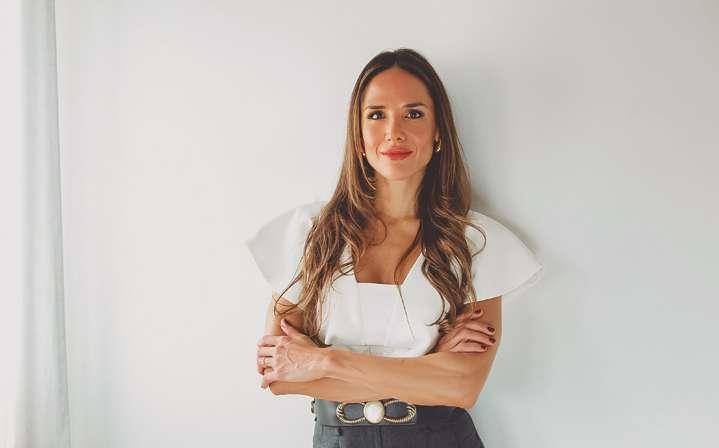
SDI BUSINESS COACHING
CHALLENGING STEREOTYPES
Sabrina Díaz Ibarra, the creative force behind SDI Business Coaching, stands as a driver of positive change in the business world. With her innovative approach and gender lens, Sabrina proposes a revolution in how we think about roles in business, transforming lives and businesses alike.
Her story, shaped by a personal search for her purpose, led her to challenge work paradigms and move from being a renowned lawyer to a professional coach with over ten years of experience with global companies and mentoring executive management.
Sabrina Díaz Ibarra, la fuerza creativa que impulsa SDI Business Coaching, se posiciona como un motor de cambio positivo en el mundo de los negocios. Con su enfoque innovador y mirada de género, Sabrina propone una revolución en la manera de pensar los roles dentro de la empresa, y así transformar vidas y negocios.
Su historia, marcada por una búsqueda personal de su propio propósito, la llevó a desafiar los paradigmas laborales y pasar de abogada reconocida a coach profesional con más de 10 años de experiencia con empresas globales y mentoring de altos mandos.
Sabrina Díaz Ibarra, Impulsgeberin bei SDI Business Coaching und treibende Kraft für positive Veränderung der Geschäftswelt setzt mit innovativem Ansatz und geschlechtsspezifischer Sicht auf neue Rollen in Unternehmen und verändert so Leben und Geschäft.
Bei ihrer Suche nach eigener Bestimmung hinterfragte sie Muster der Arbeitswelt und wurde als renommierte Anwältin zur Profi-Coachin mit mehr als 10 Jahren Erfahrung in globalen Unternehmen bei der Betreuung von Spitzen-Führungskräften.
128 SIGNATURE
How do you see the role of women in the business world?
Women have made significant progress in the business world. And we have done so together. In the age of individualism, we do it as a team, weaving networks. We are conquering spaces, holding positions and increasingly participating at the negotiating tables with a voice of our own. There is still a long way to go if we consider that analyses suggest that it will take 132 years to close what is known as the “gender gap”. But we have to acknowledge where we started and where we are today. That gap has narrowed but still exists in certain leadership roles and STEM fields.
How can women be encouraged to stand up and make their careers count?
How can we ask them to make their careers count when we have yet to own our success? This is where the impostor syndrome, a widespread psychological phenomenon in women, kicks in. Despite having obvious achievements and proven skills, it makes us feel a deep sense of undeserving of our success. 75% experience it at least once in their life. We attribute our achievements to luck or external factors, rather than recognising our own abilities and efforts. In my experience, in order to raise our hand, we need to have clear goals but, fundamentally, a foundation of self-confidence.
Why does society make a woman feel guilty when she is fulfilling her purpose and desires?
We are still burdened with traditional models of motherhood and family care. In terms of work, motherhood is still conceived of as an incompatible world. Any mother who wants to return to work sometimes feels “I don’t have to be here” because, culturally, she is expected to be with her child. And if she is at work, “she is not being a good mother”. Why does this woman feel at fault when what she is doing is fulfilling her life purpose? It is time to update the models and work on a genuine work-life balance that allows women to integrate their roles.
How can women reach their full potential?
I believe that the first 21 km of the marathon are about responsibility and work. I call them “personal cages”, constraints that, once unlocked, connect us to our full potential. There are also organisational cages (barriers), such as social and cultural ones. But we have to run the first kilometres ourselves, challenging limiting thoughts, developing a mindset of continuous growth and learning, and focusing on our strengths, which will ultimately make the difference.

129 SIGNATURE
¿Cómo ves el papel de la mujer en el mundo de los negocios?
Las mujeres logramos avances importantes en el mundo empresarial. Y ese avance ha sido en conjunto. En la era del individualismo, lo logramos en equipo, tejiendo redes. Conquistamos espacios, ocupamos sillas y participamos cada vez más en las mesas de negociación con una voz propia. El camino todavía es largo, si contemplamos que los análisis hablan de 132 años para cerrar lo que se conoce como “brecha de género”. Pero hay que reconocer de dónde partimos y dónde estamos hoy. Esa brecha se ha reducido, pero sigue existiendo en ciertos roles de liderazgo y ciertos campos de STEM.
¿Cómo se puede alentar a las mujeres para que levanten la mano y hagan valer sus carreras profesionales?
¿Cómo pedirles que hagan valer sus carreras cuando todavía no terminamos de apropiarnos de nuestro éxito? Aquí juega el síndrome del impostor, un fenómeno psicológico muy común en mujeres. A pesar de tener logros evidentes y habilidades comprobadas, nos hace sentir una profunda sensación de no merecer nuestro éxito. El 75% lo experimenta al menos una vez en la vida. Le atribuimos nuestros logros a la suerte o a factores externos, en lugar de reconocer nuestras propias capacidades y esfuerzos. En mi experiencia, para levantar la mano necesitamos tener metas claras pero, fundamentalmente, una base de autoconfianza.
¿Por qué la sociedad hace que una mujer se sienta culpable cuando lo que está haciendo es cumplir con su propósito y deseos?
Todavía cargamos con modelos tradicionales sobre la maternidad y el cuidado familiar. La maternidad, en términos laborales, aún se concibe como si fuera un mundo incompatible. Cualquier mujer madre que quiera volver al trabajo siente por momentos “no tengo que estar aquí” porque culturalmente se espera que esté con su hijo. Y si está en su trabajo, “no está siendo una buena madre”. ¿Por qué esa mujer se siente en falta cuando lo que está haciendo es cumplir con su propósito de vida? Creo que es momento de actualizar los modelos y trabajar en una conciliación real que permita a las mujeres integrar sus roles.
¿Cómo puede la mujer alcanzar su máximo potencial?
Soy de las que cree que los primeros 21km de la maratón son responsabilidad y trabajo personal. Yo las llamo “jaulas personales”, condicionantes que una vez desbloqueados nos conectan con nuestro máximo potencial. También están las jaulas (barreras) organizacionales, como las sociales y culturales. Pero los primeros kilómetros los tenemos que hacer nosotras mismas, desafiando pensamientos limitantes, desarrollando una mentalidad de crecimiento y aprendizaje continuo, y poniendo foco en nuestras fortalezas, que son las que marcarán la diferencia.
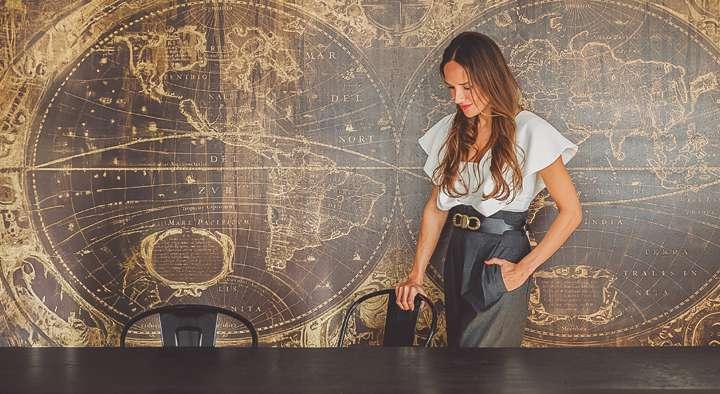
130 SIGNATURE

Wie sehen Sie die Rolle der Frauen in der Geschäftswelt?
Wir Frauen erzielten in der Unternehmenswelt große Fortschritte und das gemeinsam. In einer Zeit des Individualismus gelang es uns als Team, Netzwerke zu schaffen, Räume zu erobern, Plätze einzunehmen und zunehmend an Verhandlungstischen mit eigener Sprache aufzutreten. Ein weiter Weg liegt noch vor uns, wenn man bedenkt, dass in Analysen von 132 Jahren die Rede ist, bis die sogenannte “Geschlechterkluft” sich schließt. Aber wir müssen anerkennen, wo wir begannen und wo wir heute stehen. Die Kluft ist kleiner geworden, existiert aber immer noch in bestimmten Führungspositionen und MINT-Bereichen.
Wie ermutigt man Frauen, sich zu behaupten und ihre berufliche Karriere zur Geltung zu bringen?
Wie können wir das von ihnen verlangen, wenn wir uns selbst unsere eigenen Erfolge nicht zuschreiben können? Hier greift das Hochstapler-Syndrom, ein unter Frauen häufiges psychologisches Phänomen. Trotz offenkundiger Erfolge und unter Beweis gestellter Fähigkeiten fühlen wir tief in uns, dass uns unser Erfolg nicht zusteht. 75% der Frauen erfahren dies mindestens einmal im Leben. Unsere Erfolge schreiben wir eher Glück oder äußeren Umständen zu, als sie als Ergebnis eigenen Könnens und Mühe zu werten. Um sich zu behaupten, brauchen wir meiner Erfahrung nach klare Ziele, aber vor allem ein Fundament aus Selbstvertrauen.
Warum verursacht die Gesellschaft bei Frauen das Gefühl von Schuld, wenn sie ihre eigenen Ziele und Wünsche erfüllen?
Wir sind noch immer mit althergebrachten Mustern zu Mutterschaft und Sorge für die Familie belastet. Mutterschaft wird immer noch als mit der Arbeitswelt unvereinbar wahrgenommen. Jede Mutter, die ins Arbeitsleben zurückkehrt, kennt dieses Gefühl: “Ich muss nicht hier sein”, denn aus kultureller Sicht wird von ihr erwartet, sich um ihr Kind zu kümmern. Und eine berufstätige Frau gilt oft als “keine gute Mutter”. Aber warum sollte sich diese Frau als unzulänglich empfinden, wenn sie doch ihr Lebensziel verfolgt? Ich glaube, es ist an der Zeit, Modelle neu zu denken und eine echte Vereinbarkeit der Rollen von Frauen zu schaffen.
Wie kann eine Frau ihr Potenzial voll ausschöpfen?
Ich bin wie einige andere der Meinung, dass die ersten 21 km eines Marathons persönliche Verantwortung und Leistung sind. Ich nenne sie “persönliche Käfige”, sie konditionieren uns, aber einmal ihnen entkommen ist der Weg zum höchsten Potenzial frei. Dazu kommen organisationsbedingte Käfige (Barrieren) wie soziale und kulturelle. Aber die ersten Kilometer müssen wir selbst laufen, uns einschränkende Gedanken hinterfragen, Einstellung zu Wachstum und ständigem Lernen entwickeln und uns auf unsere Stärken konzentrieren, die am Ende den Unterschied ausmachen.
131 SIGNATURE
BIZNAGA & ARTISTEO
PROJECTS BURSTING WITH PERSONALITY
At Carrer de la Pelleteria no 5, in the heart of the Calatrava district, botany and art, creativity and interior design, connection and entrepreneurship come together. This is where personal projects Biznaga Atelier and Artisteo Taller share space, values and the same way of understanding and being in the world, promoted by two artistic women.
Architect and interior designer María champions Artisteo Taller, quitting her old job to create her own drawing school. In this rather unique school, you’re encouraged to let go, connect with yourself and dare to experiment, rather than perfecting your technique.
She offers adult drawing courses using charcoal, watercolour, acrylic, Chinese ink, graphite and even oil, taking them on a journey to explore their creative talents and have fun painting, developing their own artistic voice. There is no pressure or unattainable goals, because the Artisteo workshop is all about play and enjoyment.
Elena promotes green. Settling in Palma after living in France and the Netherlands, she opened a unique workshop to share her passion for botany through courses, consultancy and facilities for individuals and companies. A former industrial designer, Valencian-born Elena found a way to live and transmit a slow lifestyle through the plants, and this is now her job.
Elena teaches courses in her workshop that transcend learning how to care for and recognize plants. She aims to open a calm place to help people let go of the stressful daily routine and reconnect with nature. Her interior design service also transforms spaces via the design and inclusion of plants in homes and offices to make the places we inhabit greener, permanently seeking beauty and harmony.
María and Elena have united their passions, botany and art, in one space to offer learning through play, experimentation and connection with oneself and others. Two inspiring projects that transmit knowledge and remind us that creativity and nature can make daily life more beautiful.
www.biznagaatelier.com / www.artisteotaller.com
132 ART & DESIGN
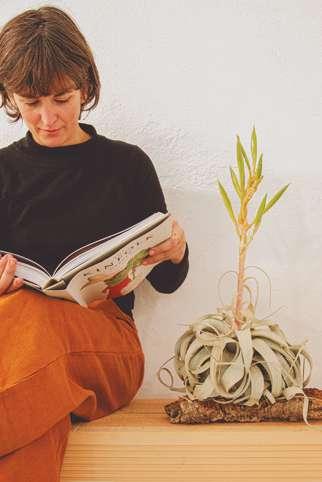
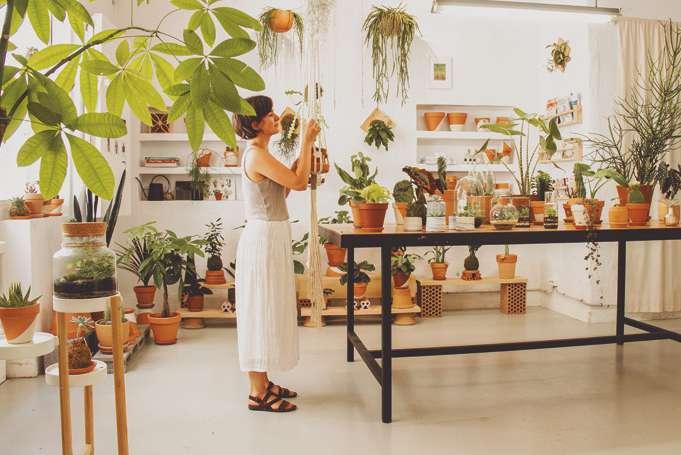
133
Photo: The Apartment Man
Photo: The Apartment Man
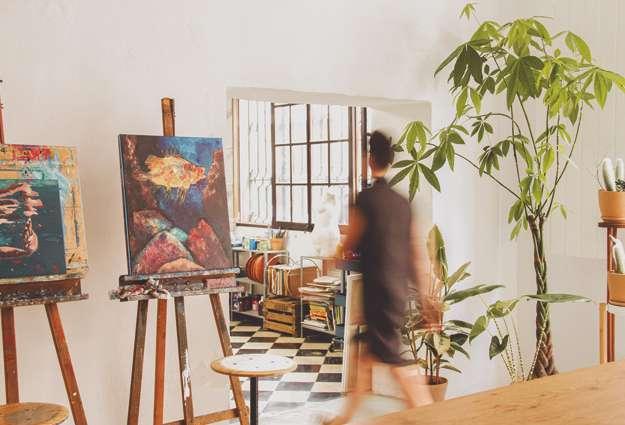

134
Photo: The Apartment Man
Photo: The Apartment Man
BIZNAGA & ARTISTEO
PROYECTOS REPLETOS DE PERSONALIDAD
En el número 5 del carrer de la Pelleteria, en el corazón del barrio de Calatrava, epicentro de la historía de Palma, conviven botánica y arte, creatividad e interiorismo, conexión y emprendimiento. Y todo gracias a Biznaga Atelier y Artisteo Taller, dos proyectos personales impulsados por dos mujeres que comparten espacio, valores y una misma forma de entender y estar en el mundo.
Artisteo Taller es el proyecto de María, una arquitecta y diseñadora de interiores que decidió dejar su antiguo puesto de trabajo para crear su propia escuela de dibujo. Una escuela un tanto peculiar en la que dejarse llevar, conectar con uno mismo y atreverse a experimentar es más importante que perfeccionar la técnica.
Aquí se dibuja con carboncillo, acuarela, acrílico, tinta china, grafito e incluso óleo en cursos dirigidos a adultos que se plantean como un viaje para aquellos que desean explorar sus dotes creativas y disfrutar a través de la pintura, y para alumnos que anhelan desarrollar su propia voz artística. Sin presión ni metas inalcanzables, pues al taller de Artisteo se viene a jugar y, sobre todo, a disfrutar.
El verde lo pone Elena, que después de vivir en Francia y Países Bajos se instaló en Palma, donde abrió un particular atelier con el que comparte su pasión por la botánica a través de cursos, asesorías e instalaciones para particulares y empresas. Diseñadora industrial de formación, esta valenciana encontró en las plantas una manera de practicar y transmitir un estilo de vida slow que ha convertido en su trabajo.
En el atelier, Elena imparte cursos que van mucho más allá de aprender a cuidar y distinguir plantas. El propósito es abrir un espacio de calma en el que desconectar de la estresante rutina del día a día para aliarse con la naturaleza y tocar tierra. Además, su servicio de interiorismo transforma espacios a través del diseño y la instalación de plantas en hogares y oficinas para hacer que los lugares que habitamos sean más verdes, siempre buscando la belleza y la armonía.
María y Elena han unido sus pasiones, la botánica y el arte, en un mismo espacio en el que el aprendizaje es indisociable del juego, la experimentación y la conexión con uno mismo y con los otros. Dos proyectos inspiradores que, además de transmitir conocimientos, nos recuerdan que la creatividad y la naturaleza forman parte de la lista de cosas que hacen más bello nuestro día a día.
BIZNAGA & ARTISTEO
ABSOLUT UNVERKENNBARE PROJEKTE
In der Carrer de la Pelleteria Nummer 5, mitten im Viertel Calatrava, vermischen sich Botanik und Kunst, Kreativität und Interieurdesign, Begegnung und Unternehmertum. Grund dafür sind Biznaga Atelier und Artisteo Taller, zwei persönliche Projekte zweier Frauen, die Räume, Werte, Lebensansichten und Lebensart teilen.
Artisteo Taller ist das Projekt von María, Architektin und Interieurdesignerin, die ihre Arbeitsstelle aufgab, um ihre eigene Malschule zu gründen. Eine etwas eigenwillige Schule, in der loslassen, sich selbst finden und Mut zum Experimentieren wichtiger sind als Perfektionieren der Technik.
Hier wird mit Holzkohle, Aquarell, Acryl, chinesischer Tinte, Bleistift und sogar mit Ölfarbe gearbeitet. Es gibt Kurse für Erwachsene, die auf einer Art Reise ihre kreativen Talente ausloten und sich an Malerei erfreuen wollen, und für Schüler mit der Absicht, ihren eigenen künstlerischen Stil zu entwickeln. Ohne jeden Druck, ohne unerreichbare Ziele. Zum Artisteo-Workshop kommt man, um auf spielerische Art Spaß zu haben.
Für das viele Grün ist Elena verantwortlich, die nach ihrem Leben in Frankreich und den Niederlanden nach Palma zog und ein eigenes Atelier eröffnete, in dem sie ihre Leidenschaft für Pflanzen bei Kursen, Beratungen und Installationen für Privatpersonen und Unternehmen auslebt. In Pflanzen hat die ausgebildete Industriedesignerin aus Valencia ihre Art gefunden, Slow Live zu leben und mit ihrer Arbeit an andere weiterzugeben.
In ihrem Atelier leitet Elena Kurse, die weit über Pflege und Unterscheiden von Pflanzen hinausgehen. Beabsichtigt ist die Schaffung eines Raums der Ruhe, in dem man Alltagsstress draußen lassen, Einklang mit der Natur finden und Erde berühren kann. Immer auf der Suche nach ausgewogener Schönheit macht sie durch Design und PflanzenInstallationen mit ihrem Innenarchitektur-Service unsere Wohnungen und Büros grüner.
María und Elena vereinen ihre Leidenschaften, Botanik und Kunst, in einem Raum, in dem Lernen untrennbar mit Spielen, Experimentieren, Einklang mit uns selbst und Begegnung mit anderen verbunden ist. Zwei inspirierende Projekte, die nicht nur lehrreich sind, sondern uns auch in Erinnerung rufen, dass Kreativität und Natur zu den Dingen gehören, die unser tagtägliches Leben schöner machen.
135 ART & DESIGN
www.biznagaatelier.com / www.artisteotaller.com
WINE BARS
PAIRING NATURAL WINES
Natural wines are in fashion. This additive and stabiliser-free winemaking process instead promotes organic farming practices, and has become more and more popular with winemakers and fans throughout the world. The method is simple: minimize human intervention in the winemaking process, reclaiming freedom and promoting original methods.
At the root of this success is new gastronomical concepts in harmony with this way of understanding winemaking, focusing on sulphur-free wine paired with top-quality culinary delights.
Bar La Sang opened in 2019 in Majorca’s Calle Costa de la Sang, and was a pioneer on the island, offering an extensive wine list, all made using these simple methods The bar moved to Carrer d’Antoni Frontera in 2022, but maintained its essence. 400 natural wines from around the world, including many local varieties like Ve d’Avior, Soca-rel, 4 Kilos and Selva vins, and top meat-based tapas dishes and fresh options made with local ingredients.
La Nouvelle Famille has been working on this concept from Santanyí, recalling former knowledge and valuing closeness and the importance of the seemingly-simple, like specialty coffee, sourdough focaccia and sobrasada with mussels. Marta Expósito and Manuel Paz are the owners and designers of this bar, maintaining the feel of a village bar with an extensive wine list including local options like Son Llebre, Albariño A Pedreira and Cobrana from Leon.
The trend is not just limited to bars. The natural wine boom has resulted in the opening of many independent wine shops where customers can stock up. Palma’s La Viniloteca is the perfect place to buy a great bottle to enjoy at home. CAV Vins is a contemporary shop selling local and national wines with their own production line, Jugo Vins - a must-see for natural wine lovers. Uncork, raise a glass and have fun! Cheers!
136 GASTRO
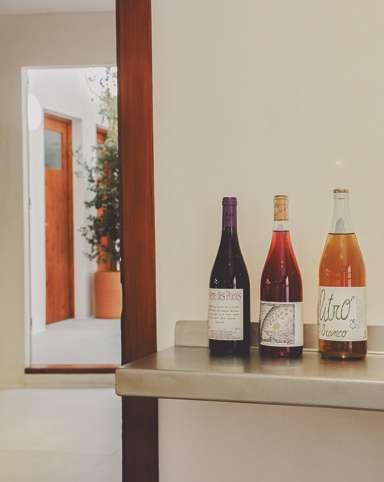

137
Photo: La Nouvelle Famille
Photo: La Nouvelle Famille
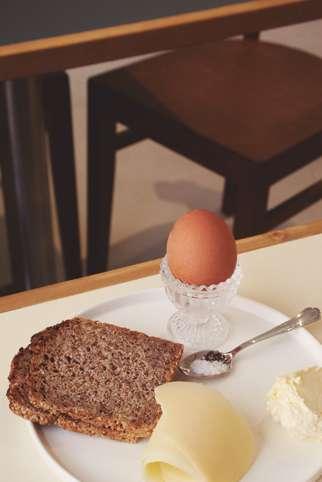

138
Photo: La Nouvelle Famille
Photo: La Nouvelle Famille
WINE BARS
MARIDANDO VINOS NATURALES
Los vinos naturales están de moda. Este fenómeno vitivinícola que prescinde de aditivos y estabilizadores, y sigue los preceptos de la agricultura ecológica toma cada vez más fuerza en las bodegas de todo el mundo y suma adeptos entre los amantes del buen vino. Su método es sencillo: consiste en reducir al mínimo la intervención humana durante el proceso de elaboración en un ejercicio que reclama libertad y regala matices originales.
A raíz de este caso de éxito, nuevos conceptos gastronómicos en sintonía con esta manera de entender la cultura del vino abren sus puertas enfocándose en el vino sin sulfitos y acompañándose de propuestas culinarias que llevan la calidad del producto por bandera.
En Mallorca, Bar La Sang, que alzó su persiana en 2019 en la calle Costa de la Sang, fue pionero en la isla en ofrecer una amplia carta de vinos elaborados con métodos poco intervencionistas. En 2022 se trasladó hasta Carrer d’Antoni Frontera sin perder ni un ápice su esencia: 400 referencias de vinos naturales de alrededor del mundo -entre ellos, muchos mallorquines, como Ve d’Avior, Soca-rel, 4 Kilos y Selva vins-, tapas de charcutería de alto voltaje y platillos frescos a base de producto local.
La Nouvelle Famille trabaja en línea en este mismo concepto desde Santanyí y reivindica el saber hacer de antaño, ese que pone en valor el trato cercano y la importancia de las cosas aparentemente simples, como un café de especialidad, una focaccia de masa madre o una fuente de mejillones con sobrasada. Marta Expósito y Manuel Paz están detrás de la barra y del diseño del local, que conserva la idiosincrasia de una taberna de pueblo y ofrece una amplia carta de vinos, como el mallorquín Son Llebre, el albariño A Pedreira o el castellano leonés Cobrana.
No todo son bares. El auge de los vinos naturales ha venido acompañado, también, de tiendas singulares en las que abastecer la bodega de casa. En Palma, La Viniloteca es el lugar perfecto para comprar una buena botella y llevarse a casa un vinilo, y CAV Vins, en el vibrante barrio de Sa Gerreria, una tienda con estética contemporánea en cuyas estanterías conviven vinos de aquí y de allá con su propia producción, Jugo Vins, se ha convertido en una parada obligatoria para cualquier apasionado del vino natural. Solo queda descorchar, brindar y disfrutar. ¡Salud!
WEINBARS
PAIRING NATÜRLICHER WEINE
Naturweine sind angesagt. Das den Vorgaben ökologischen Anbaus folgende Phänomen der Weinerzeugung ohne Zusatzstoffe oder Stabilisatoren setzt sich auf Weingütern überall auf der Welt immer mehr durch und erfreut sich bei Kennern guter Weine zunehmender Beliebtheit. Die Methode ist simpel und beruht darauf, menschliche Eingriffe beim Herstellungsverfahren so gering wie möglich zu halten. Das erfordert Freiräume und bietet originelle Nuancen.
Die so erfolgreichen Weine ohne Sulfite erschließen neue gastronomische Konzepte im Einklang mit diesem Verständnis von Weinkultur, ergänzen kulinarische Angebote bestens und bringen die Qualität des Produkts voll zur Geltung.
Vorreiter auf der Insel Mallorca war die Bar La Sang, 2019 in der Straße Costa de la Sang eröffnet, mit einer bestens sortierten Karte natürlicher Weine aus organisch-biologischem Anbau. Beim Umzug 2022 in die Carrer d’Antoni Frontera blieb man sich selbst treu: 400 Empfehlungen natürlicher Weine aus aller Welt, darunter viele aus Mallorca wie Ve d’Avior, Soca-rel, 4 Kilos und Selva vins, dazu edle Delikatessen-Tapas und aus hiesigen Produkten frisch zubereitete kleine Gerichte.
Bei Nouvelle Famille in Santanyí greift man das Konzept der Rückbesinnung auf das Können alter Zeiten auf, bei dem so viel Wert auf Nähe zum Gast und die große Bedeutung scheinbar simpler Dinge gelegt wird wie zum Beispiel Spezialitätenkaffee, Focaccia aus Sauerteig oder Muscheln mit Sobrasada. Marta Expósito und Manuel Paz stehen hinter der Theke und für das Design des Lokals, das die Eigenart einer Dorfkneipe bewahrt und auf dessen grandioser Karte Weine wie Son Llebre aus Mallorca, der Albariño A Pedreira oder Cobrana, kastilischer Wein aus León, stehen.
Aber es gibt nicht nur Bars. Der Trend zu Naturweinen bringt auch ganz besondere Geschäfte mit sich, in denen Sie Angebote für Ihren Weinkeller zu Hause finden. Für den Kauf einer Flasche guten Weins und einer LP gleich mit ist La Viniloteca in Palma die ideale Adresse. Ein Muss für alle Liebhaber natürlicher Weine ist auch CAV Vins, ein Geschäft in zeitgemäßer Optik, in dessen Regalen sich Weine von hier und von da mit Weinen eigener Herstellung, Jugo Vins, mischen. Bleibt nur noch Entkorken, Anstoßen und Genießen. Auf Ihr Wohl!
139 GASTRO
TONY MORA
COWBOY BOOTS WITH A MAJORCAN FLAIR
Tony Mora’s boots are made in Alaró, but have trodden the catwalks of Paris, New York and Milan. The timeless design and rabid modernity of each pair of boots from the 1918 Majorcan born brand is a tribute to craftsmanship.
More than a hundred processes are scrupulously followed, from leather selection to meticulous finishes, using hundred-year-old machines and expert hands, to make each pair of cowboy boots unique and perfect.
Although the origin of cowboy boots is somewhat confusing, Tony Mora has been manufacturing globally popular handcrafted boots since opening his factory in 1918. A key feature is the quality of the leather used -100% natural, ranging from classic to exotic (ostrich, crocodile, iguana or python) to split or turned skins, Noubouck and Washed, all unique with an aged feel.
Another determining factor is the Goodyear system, revolutionising footwear in the second half of the 19th century, which is still a firm feature of the manufacturing process. This method consists of covering the upper part of the boot, then moulding it and joining it to the insole, before joining the pieces with a welt. The results: a durable, flexible and comfortable shoe.
Tony Mora’s cowboy boots are versatile and on-trend, with their own identity, building a look from the feet up. The Alaró company also offers a 100% personalized service, letting customers design their own boots, choosing the leather, colour, embroidery, finish and even the height and shape of the heel.
The boots can also be purchased from the stores in Alaró, Puerto de Andratx, Santanyí, Artà or from their website, and worn worldwide. Durable and functional, they combine style and comfort. Boots with lifelong wearability.
www.tonymora.com
140 STYLE

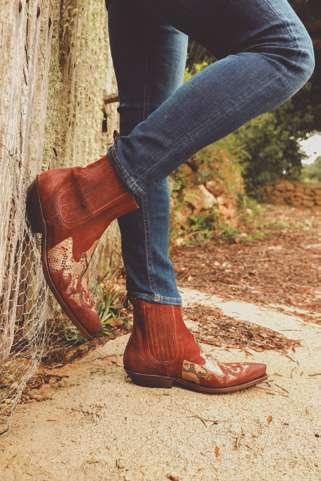
141
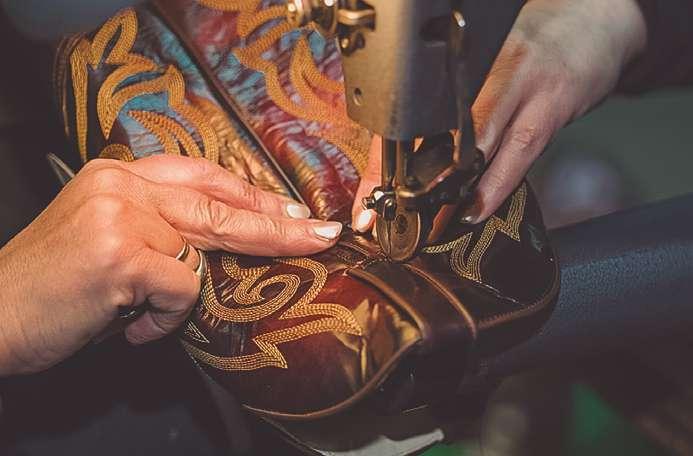

142
TONY MORA
BOTAS COWBOY CON ACENTO MALLORQUÍN
Las botas de Tony Mora se fabrican en Alaró, pero han pisado las pasarelas de París, Nueva York y Milán. El diseño atemporal y la rabiosa actualidad de cada par de botas de esta marca que nació en el corazón de la isla en 1918 es un homenaje al proceso artesanal.
Más de cien procesos se siguen escrupulosamente, desde la selección del cuero hasta el meticuloso acabado, con máquinas con cien años de antigüedad y manos expertas, para conseguir que cada par de botas cowboy sea único y perfecto.
Aunque el origen de las botas cowboy es algo confuso, no ocurre lo mismo con la historia de Tony Mora que, desde que abrió su fábrica en 1918 manufactura botas artesanas que triunfan en todo el mundo. Una de sus claves es la calidad de las pieles que la firma utiliza, 100% naturales, y que van desde las clásicas a las más exóticas -de avestruz, cocodrilo, iguana o pitón- hasta las pieles de serraje o giradas, las pieles Noubouck y las pieles Washed, pieles irrepetibles con tacto envejecido.
Otro factor determinante es el sistema Goodyear -que revolucionó el calzado en la segunda mitad del siglo XIX- y que la firma sigue ejecutando hoy metódicamente. Este método consiste en revestir la parte superior de la bota, después moldearla y unirla a la plantilla para acabar uniendo las piezas con un ribete. Un proceso que logra dotar de durabilidad, flexibilidad y comodidad al zapato que se fabrica.
Versátiles y siempre actuales, las botas cowboy de Tony Mora tienen identidad propia y la capacidad de construir un look desde los pies. Además, la empresa de Alaró ofrece un servicio cien por cien personalizado en el que el cliente puede diseñar su propio par a su gusto y elegir la piel, el color, los bordados, los acabados e incluso la altura y la forma del tacón.
Con tiendas físicas en Alaró, Puerto de Andratx, Santanyí, Artà y también en Marbella, sus botas también pueden adquirirse online en su página web y calzarse en cualquier parte del planeta. Duraderas y funcionales, aúnan estilo y comodidad. Unas botas para lucir toda la vida.
TONY MORA
COWBOYSTIEFEL MIT MALLORCA-TOUCH
Stiefel von Tony Mora fertigt man in Alaró, getragen werden sie auf Laufstegen in Paris, New York und Mailand. Jedes Paar Stiefel mit zeitlos und rabiat aktuellem Design dieser 1918 auf der Insel gegründeten Marke ist eine Ehrerbietung an handwerkliches Können.
Mehr als hundert Arbeitsschritte braucht es, von der Auswahl des Leders bis zur akribischen Verarbeitung, damit erfahrene Hände auf hundertjährigen Maschinen ein Paar Cowboystiefel, jedes einzigartig und tadellos, fertigen.
Der Ursprung der Cowboystiefel ist vage, ganz klar dagegen die Geschichte von Tony Mora, wo man seit der Gründung der Fabrik 1918 Stiefel in Handarbeit fertigt, die auf der ganzen Welt Erfolge feiern. Einer der Gründe ist die Qualität des verwendeten Leders, 100% Naturleder, von absoluten Klassikern bis hin zum Extravaganten, Strauß, Krokodil, Leguan oder Python, Spaltleder oder auf links gedrehtes Leder, Nubuk und Washed Leder, unverkennbar mit reizvoll alter Haptik.
Dazu kommt das Goodyear-System, eine Revolution Mitte des 19. Jahrhunderts bei der Fertigung von Schuhwerk, dem das Unternehmen auch heute noch strikt folgt. Bei dieser Methode werden Oberleder über die Brandsohle angepasst, befestigt und danach Brandsohle und Laufsohle durch einen Kanal verbunden. Das Verfahren verleiht dem Schuhwerk lange Lebensdauer, Geschmeidigkeit und Laufkomfort.
Vielseitig tragbar, immer topaktuell, Cowboystiefel von Tony Mora erkennt man auf Anhieb. Mit ihnen lässt sich von den Füßen aufwärts eigener Stil kreieren. Und das Unternehmen in Alaró bietet absolut individuellen Service. Kunden können sich ihr Paar Stiefel ganz nach eigenem Geschmack designen und dabei Lederart, Farbe, Bestickung, Verarbeitung und sogar Höhe und Form des Absatzes wählen.
Kaufen kann man die Stiefel in Geschäften in Alaró, Puerto de Andratx, Santanyí, Artà und Marbella oder online über die Website. Langlebig, zweckmäßig, stilvoller Tragekomfort. Stiefel, um ein ganzes Leben lang bestens unterwegs zu sein.
www.tonymora.com
143 TRAVEL EXPERIENCES
PALAU MARCH
A HISTORICAL LEGACY
Palma’s historic centre boasts buildings that preserve the city’s history. They house the past, fill the present with life, and project the future. Near the cathedral, La Seu, and between the Palau de l’Almudaina and the Parlament de les Illes Balears, is the Palau March, built at the request of Juan March Ordinas and designed by Madrid architect Luis Gutiérrez Soto, managed by Gabriel Alomar.
With architectural influences from the Mediterranean Baroque palaces, its main façade, a terrace overlooking the heart of the city and its courtyard of honour are the main features of the former March family’s residence in the capital, where they resided from 1945, for decades.
The Palau March is now the headquarters of the Bartolomé March Servera Foundation. Founded in 1975 by Joan March’s son Bartolomé March, who the foundation is named after, it reflects his intense devotion to art and culture with its purpose and its initiatives.
The palace has a library specializing in Balearic themes, with manuscripts, books and pamphlets, an eighteenth-century Neapolitan nativity scene with around 2000 pieces, Bartolomé March’s own cartography collection, with navigation charts from the XIV and XV centuries, and two scenographies, on the main staircase and in the spectacular music room, the work of the Catalan muralist Josep M. Sert.
The Fundació also houses a collection of modern and contemporary sculptures including pieces by international artists like Henry Moore, Max Bill and Pietro Consagra, and Spanish artists Eduardo Chillida, Miguel Ortiz Berrocal and Francisco Otero. These sculptures are exhibited alongside the collection’s most emblematic piece, the bronze ‘Torse d ‘Homme qui tombe’, by the famous French sculptor Auguste Rodin.
Faithful to its commitment to patronage, the Bartolomé March Servera Foundation founded the annual Juan March Cencillo Short Novel Prize in 1993, organising a program of cultural activities taking place in the auditorium, opening in 2003, and in Sa Torre Cega, in Cala Ratjada, acquired by the March family in 1915.
Within its walls, the Palau March currently reflects the cultural background of a man passionate about the arts, a collector, bibliophile and patron. A legacy of great artistic sensitivity, now accessible to any culture lover visiting Majorca.
144 HERITAGE


145
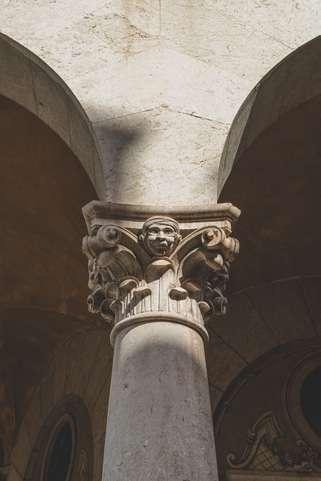

146
PALAU MARCH UN LEGADO HISTÓRICO
En el centro histórico de Palma conviven edificios que custodian la historia de la ciudad. Albergan el pasado, llenan de vida el presente y proyectan el futuro. Cerca de la catedral, La Seu, y entre el Palau de l’Almudaina y el Parlament de les Illes Balears, se encuentra el Palau March, un edificio que se construyó a petición de Juan March Ordinas y proyectó el arquitecto madrileño Luis Gutiérrez Soto bajo la dirección de Gabriel Alomar.
Con influencias arquitectónicas de los palacios barrocos mediterráneos, su fachada principal, una terraza con vistas al corazón de la ciudad y su patio de honor conforman los principales atractivos de la que fue la residencia familiar de los March en la capital durante décadas desde que se inaugurara en 1945.
Hoy, el Palau March es la sede de la Fundació Bartolomé March Servera. Fundada en 1975 por el hijo de Joan March que da nombre a la fundación, ésta refleja, con su propósito y sus iniciativas, la devoción por el arte y la cultura que vivió intensamente Bartolomé March.
El palacio cuenta con una biblioteca especializada en temática balear -con manuscritos, libros y opúsculos-, un belén napolitano del siglo XVIII que se compone de alrededor de 2.000 piezas, la colección de cartografía del propio Bartolomé March, que reúne cartas de navegación de los siglos XIV y XV, y dos escenografías, en la escalera principal y en la espectacular sala de música, obra del muralista catalán Josep María Sert.
Además, la Fundació hospeda una colección de escultura moderna y contemporánea con obras de nombres internacionales como Henry Moore, Max Bill y Pietro Consagra, y de los artistas españoles Eduardo Chillida, Miguel Ortiz Berrocal y Francisco Otero, entre otros. Esculturas que conviven con, seguramente, la obra más emblemática de toda la colección, la pieza en bronce ‘Torse d’Homme qui tombe’, del célebre escultor francés Auguste Rodin, considerado fundador de la escultura moderna.
Fiel a su compromiso con el mecenazgo, la Fundació Bartolomé March Servera fundó en 1993 el Premio de Novela Breve Juan March Cencillo, que se celebra anualmente, y organiza un programa plagado de actividades culturales que se llevan a cabo en el auditorio del edificio -inaugurado en 2003- y en Sa Torre Cega, en Cala Ratjada, que fue adquirida por los March en 1915.
Entre sus muros, el Palau March refleja en la actualidad el bagaje cultural de un hombre apasionado por las artes, coleccionista, bibliófilo y mecenas. Un legado de gran sensibilidad artística, hoy al alcance de cualquier amante de la cultura que pase por Mallorca.
PALAU MARCH
GESCHICHTSTRÄCHTIGES ERBE
In Palmas Altstadt finden sich die Geschichte der Stadt bewahrende Bauwerke. Sie künden von längst Vergangenem, erfüllen die Gegenwart mit Leben und weisen in die Zukunft. Nahe der Kathedrale La Seu, zwischen dem Palau de l’Almudaina und dem Parlament der Balearischen Inseln, thront Palau March, ein auf Wunsch von Juan March Ordinas errichtetes Gebäude, das von dem Madrider Architekten Luis Gutiérrez Soto unter Leitung von Gabriel Alomar entworfen wurde.
Architektonische Anleihen bei Barockpalästen, die herrliche Hauptfassade, die Terrasse mit Blick auf das Zentrum der Stadt und der Ehrenhof sind attraktiver Blickfang der 1945 eingeweihten, jahrzehntelangen Residenz der Familie March in der Hauptstadt.
Heute ist der Palau March Sitz der Fundació Bartolomé March Servera. Die Stiftung, 1975 nach ihrem Gründer, dem Sohn von Joan March benannt, ist mit Zweck und Angeboten ein Spiegelbild der leidenschaftlichen Hingabe von Bartolomé March an Kunst und Kultur.
So gibt es im Palast eine Bibliothek mit auf Themen der Balearen spezialisierten Manuskripten, Büchern und Broschüren, eine neapolitanische Krippe aus dem 18. Jahrhundert mit fast 2000 Teilen, die kartografische Sammlung von Bartolomé March mit Seekarten aus dem 14. und 15. Jahrhundert und zwei Szenenbilder, über der Haupttreppe und im prachtvollen Musiksaal, Arbeiten des katalanischen Wandmalers Josep M. Sert.
Zur Stiftung gehört auch eine Sammlung moderner, zeitgenössischer Skulpturen. Es sind Werke international renommierter Namen wie Henry Moore, Max Bill und Pietro Consagra und neben anderen der spanischen Künstler Eduardo Chillida, Miguel Ortiz Berrocal und Francisco Otero. Werke, die neben dem wohl markantesten Stück der Sammlung, der Bronzeskulptur ‘Torse d’Homme qui tombe’, des berühmten französischen Bildhauers Auguste Rodin bestehen.
Ihrem Mäzenatentum treu stiftet die Fundació Bartolomé March Servera seit 1993 den jährlich vergebenen Kurzromanpreis Juan March Cencillo und bietet ein abwechslungsreiches Kulturprogramm im 2003 eröffneten Auditorium und im 1915 von der Familie March erworbenen Sa Torre Cega in Cala Ratjada.
Innerhalb der Mauern des Palau March spürt man auch heute noch den weiten kulturellen Horizont eines von Kunst begeisterten Mannes, Sammlers, Büchernarrens und Mäzens. Ein Erbe großartiger künstlerischer Bedeutung, das heute jedem Kunstliebhaber bei seinem Besuch auf Mallorca offensteht.
147 HERITAGE
YOGA RETREATS
CONNECT WITH YOURSELF
Taking care of yourself, eating well, resting, meditating, or doing yoga and exercising are everyday habits that sometimes fall by the wayside when life gets busy. The retreats, in the form of experiences rich in detail, have arrived in Majorca, offering getaways that allow us to connect and take time for ourselves for a few days.
Cal Reiet, in Santanyí, is the perfect place to enjoy a transformative experience. These yoga and meditation retreats and workshops embrace wellness in its broadest sense: physical, emotional, social, and mental. Led by internationally renowned instructors at a rural-looking but chic and elegant estate, the retreats include yoga classes, events focused on holistic wellbeing, and healthy and nutritious vegetarian and vegan food.
Peace and harmony reign in this wonderful house, decorated according to the Zen philosophy, where Tramuntana Flow is located. A building which can host up to twelve people with yoga studios, bedrooms, gardens and a pool spread over 8,000 m² in Sa Cabaneta’s old town. Baptized ‘The House of Calm’, this space can be hired for private retreats and instructor training.
Ashtanga Yoga was founded by Pilar de Miguel who launched her own project here in Majorca, after returning home from a yoga trip to India with her instructor. She gives group and private classes in the north of the Santa Catalina neighbourhood, following the Ashtanga Yoga method, which involves synchronizing breathing with a progressive series of postures, purification of the muscles and organs that promotes improved circulation, a lighter, more toned body, and a calmer mind. Pilar also hosts yoga weeks, five-day retreats focusing on the power of breathing, movement, and meditation for both beginner and experienced yogi.
‘Feel better. Be better’ is Sadhana Works’ motto, inviting guests to look deep into themselves through yoga, alternative therapies and conscious lifestyle choices. Focusing on Majorca, Sadhana Works organizes retreats inspired by the calm, history and art of the island such as Mallorca Mystica at the Nivia Born Boutique Hotel, Radiant Power of Women - a transformative experience aimed at the collective power of women - or full days of reconnection at the Osa Mayor estate via Kundalini yoga, a sense of community and healthy gastronomy.
TRAVEL EXPERIENCES
148


149
Photo: Ashtana Yoga
Photo: Ashtana Yoga


150
Photo: Sadhana Works
Photo: Cal Reiet
RETIROS DE YOGA
CONECTAR CON UNOS MISMO
Cuidarse, alimentarse bien, descansar, practicar meditación, yoga o deporte son hábitos cotidianos que, a veces, dejamos relegados a un segundo plano, entregados al estrés del día a día. Los retiros, en forma de experiencias mimadas al detalle han llegado a Mallorca para proponernos escapadas que, al menos por unos días, nos permiten conectar e invertir tiempo en nosotros mismos.
Cal Reiet, en Santanyí, es un destino perfecto para entregarse a una experiencia transformadora. Sus retiros y talleres de yoga y meditación abarcan el bienestar en su sentido más amplio: el físico, el emocional, el social y, por supuesto, el mental. Dirigidos por profesores de renombre internacional en una finca de aspecto rural pero chic y elegante, sus retiros abarcan clases de yoga, eventos enfocados al bienestar holístico y una propuesta gastronómica saludable y nutritiva basada en la filosofía vegetariana y vegana.
En una maravillosa casa en la que reina la paz y la armonía gracias a una decoración inspirada en la filosofía Zen se encuentra Tramuntana Flow. Un edificio con capacidad para alojar hasta doce personas que cuenta con salas de yoga, dormitorios, jardín y piscina repartidos en una área de 8.000 m² en el casco antiguo de Sa Cabaneta. El espacio –bautizado como La casa de la calma- está disponible tanto para la organización de retiros privados como para la formación de profesores.
Ashtanga Yoga es el proyecto de Pilar de Miguel quién, tras viajar a la India para practicar con su maestro, impulsó en su isla natal su propio proyecto. En un local al norte del barrio de Santa Catalina, imparte clases en grupo y clases privadas siguiendo el método Ashtanga Yoga, que implica la sincronización de la respiración con una serie progresiva de posturas, una purificación de los músculos y los órganos que se traduce en una mejor circulación, un cuerpo más ligero y tonificado, y una mente más calmada. Además, Pilar organiza semanas de yoga, retiros de cinco días enfocados en el poder de la respiración, el movimiento y la meditación para practicantes principiantes y experimentados.
‘Siéntete mejor. Sé mejor’ es el lema de Sadhana Works, una invitación a profundizar en uno mismo a través de la práctica de yoga, terapias alternativas y un estilo de vida consciente. Con el foco puesto en Mallorca, Sadhana Works organiza retiros inspirados en la calma, la historia y el arte de la isla como Mallorca Mística en el hotel Nivia Born Boutique Hotel, Radiant Power of Women –una experiencia transformadora dirigida al poder compartido de las mujeres- o jornadas enteras de reconexión en la finca Osa Mayor a través del yoga kundalini, el sentido de la comunidad y la gastronomía saludable.
YOGA-RETREATS
WIEDER ZU SICH SELBST FINDEN
Auf sich achten, gute Ernährung, Ausruhen, Meditation, Yoga oder Sport sind alltägliche Gewohnheiten, die wir im Alltagsstress mitunter zurückstellen. Retreats als Rundum-Verwöhnerlebnisse sind auf Mallorca angekommen und bieten uns einen Rückzug aus dem Alltag, bei dem wir uns wenigstens für ein paar Tage die Zeit gönnen, wieder in Einklang mit uns selbst zu kommen.
Cal Reiet in Santanyí ist genau der richtige Ort für so ein veränderndes Erlebnis. Retreats und Meditations-Workshops hier umfassen Wohlbefinden im weitesten Sinne: körperlich, emotional, sozial und natürlich mental. Auf einem ländlichen, zugleich aber elegant schicken Anwesen reichen die Retreats unter Leitung international renommierter Lehrer von Yogakursen über ganzheitliche Wellness-Events bis hin zu einem gesunden und nahrhaften Gastro-Angebot auf der Grundlage vegetarischer und veganer Ernährungslehren.
In einem herrlichen Haus, das durch die von Zen inspirierte Einrichtung harmonisch heitere Beschaulichkeit ausstrahlt, befindet sich Tramuntana Flow. Ein Gebäude, in dem bis zu 12 Personen Unterkunft finden, mit Yoga-Räumen, Schlafräumen, Garten und Pool auf 8000 m² in der Altstadt von Sa Cabaneta. Die Räumlichkeiten, auf den Namen Haus der inneren Ruhe getauft, dienen sowohl der Ausrichtung privater Retreats wie auch der Ausbildung von Lehrern.
Ashtanga Yoga, eigenes Projekt von Pilar de Miguel auf ihrer Heimatinsel, startete sie nach ihrer Reise nach Indien, wo sie mit ihrem Meister übte. In einem Lokal im Norden des Viertels Santa Catalina leitet sie Gruppen- und Privatunterricht nach der Methode Ashtanga Yoga. Dabei wird die Atmung auf eine Reihe aufeinander folgender Körperstellungen abgestimmt und die reinigende Wirkung auf Muskeln und Organe fördert die Durchblutung, der Körper fühlt sich leichter und straffer an und der Geist kommt zur Ruhe. Außerdem organisiert Pilar Yoga-Wochen, fünftägige Retreats, mit Augenmerk auf die Macht der Atmung, auf Bewegung und Meditation für Anfänger und Fortgeschrittene.
‘Fühl dich besser. Sei besser’ lautet der Leitspruch bei Sadhana Works, einem Angebot, um durch Yoga, alternative Therapien und achtsame Lebensart wieder zu sich selbst zu finden. Mit Blick auf Mallorca organisiert man bei Sadhana Works von Beschaulichkeit, Geschichte und Kunst Mallorcas inspirierte Retreats wie Mallorca Mística im Nivia Born Boutique Hotel, Radiant Power of Women, ein veränderndes, auf der gemeinsamen Kraft von Frauen beruhendes Erlebnis, oder ganze Tage, um wieder mit sich selbst ins Reine zu kommen, auf der Finca Osa Mayor mit Kundalini Yoga, Gemeinschaftsgefühl und gesunder Gastronomie.
151 TRAVEL EXPERIENCES
SHOPPING IN MALLORCA
CABRABOC HUGUET

DRY GIN BLAU fetasoller.com 40€
ELENA GUAL

AZALEA PRINT spatulabyelenagual.com 375€

BROWN TERRAZZO BATHTUBE huguetmallorca.com 4.257€
CAMPER LAB

VENGA camper.com 440€
CHRISTIAN TSCHIDA

PEEK A BOO
NATURAL RED WINE lundgrenwines.com 62€
MASCARO

QUEEN CLUTCH C. Ses Moreres, 29. Mahón 212€
152
SHOPPING IN MALLORCA
PLA SHOES ARQUINESIA

ILLETES
Ctra de Santa Margalida, 1. Sineu 130€
TONY MORA

DENOS MADISON BOOT
SON MORAGUES

VIRGINIA VALD

DOLL LONG DRESS virginiavald.com 840€

SCENTED CERAMICS
C. de Sant Gaietà, 6A. Palma 59€
LA PECERA
 ACEITE DE OLIVA VIRGEN EXTRA Plaça Bartomeu Estaràs, 1. Valldemossa 75€
ROBUSTA LOUNGE PALM THREAD C. Victoria, 4. Palma P.U.R.
Ctra. Alaró, km 4. Alaró 350€
ACEITE DE OLIVA VIRGEN EXTRA Plaça Bartomeu Estaràs, 1. Valldemossa 75€
ROBUSTA LOUNGE PALM THREAD C. Victoria, 4. Palma P.U.R.
Ctra. Alaró, km 4. Alaró 350€
153

BECAUSE EVERY WEDDING OR EVENT IS UNIQUE. BECAUSE FOR EVERYONE AIRE CATERING IS THE BEST OPTION.

We o er everything you need to organize a tailor-made event.
info@airecatering.com airecatering.com
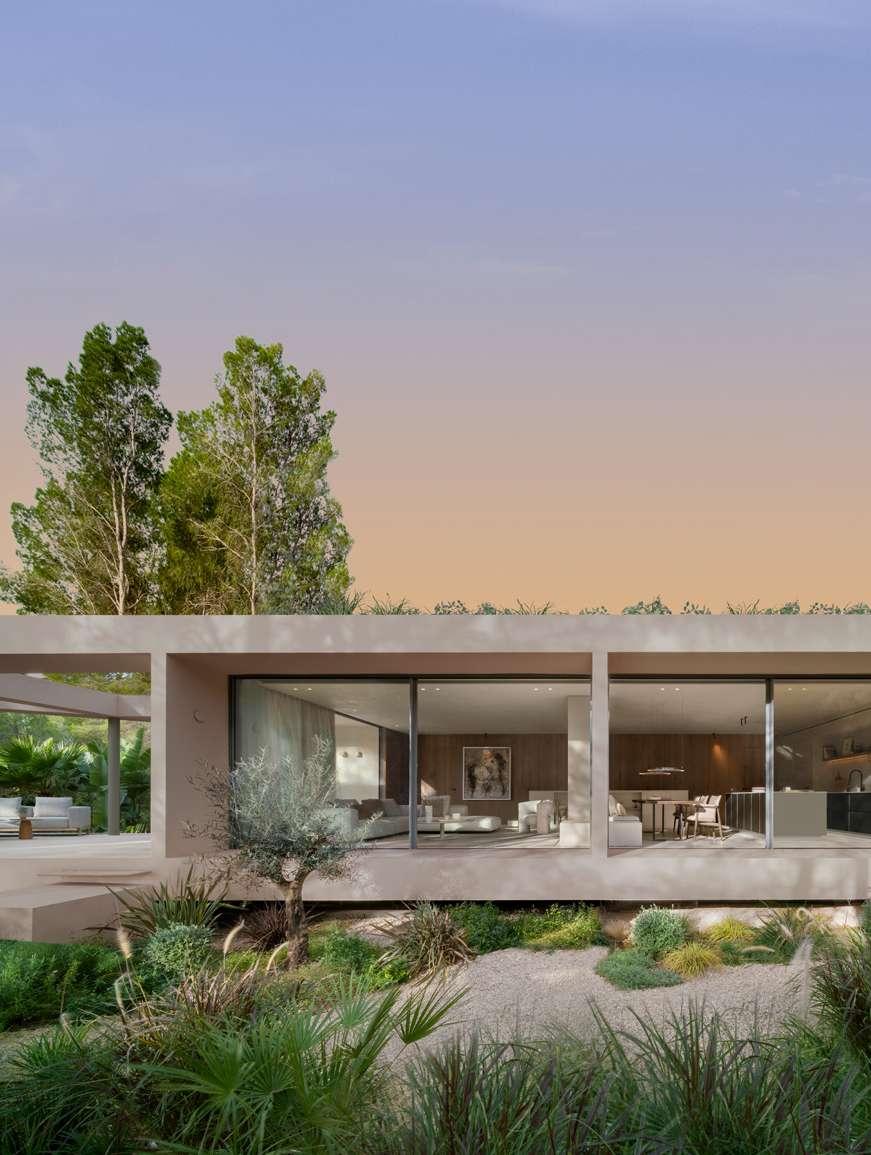
MALLORCA | MADRID | BARCELONA | MARBELLA | BILBAO terrazabalear.com interior design & furniture
AWAKENING SENSES



 Photo: Can Pep Rey
Photo: Can Pep Rey



























 The finest bespoke interiors.
The finest bespoke interiors.



 Photo: Castell Son Claret
Photo: Castell Son Claret

































































 Photo: Llubí
Photo: Llubí











 Photo: Bruno Daureo
Photo: Bruno Daureo














 Photo: Daria Scagliola
Photo: Daria Scagliola













































 ACEITE DE OLIVA VIRGEN EXTRA Plaça Bartomeu Estaràs, 1. Valldemossa 75€
ROBUSTA LOUNGE PALM THREAD C. Victoria, 4. Palma P.U.R.
Ctra. Alaró, km 4. Alaró 350€
ACEITE DE OLIVA VIRGEN EXTRA Plaça Bartomeu Estaràs, 1. Valldemossa 75€
ROBUSTA LOUNGE PALM THREAD C. Victoria, 4. Palma P.U.R.
Ctra. Alaró, km 4. Alaró 350€

